Japan's Visa Policy Impact on Thai Tourists
VerifiedAdded on 2020/06/05
|57
|19090
|81
AI Summary
This assignment investigates how changes in Japan's visa policy have affected Thai tourists. It explores factors like visitor motivation, satisfaction with policy duration limits, and the perceived impact of visa changes on travel decisions. The research also considers cost implications and whether new residence visa policies attract more Thai visitors to Japan.
Contribute Materials
Your contribution can guide someone’s learning journey. Share your
documents today.
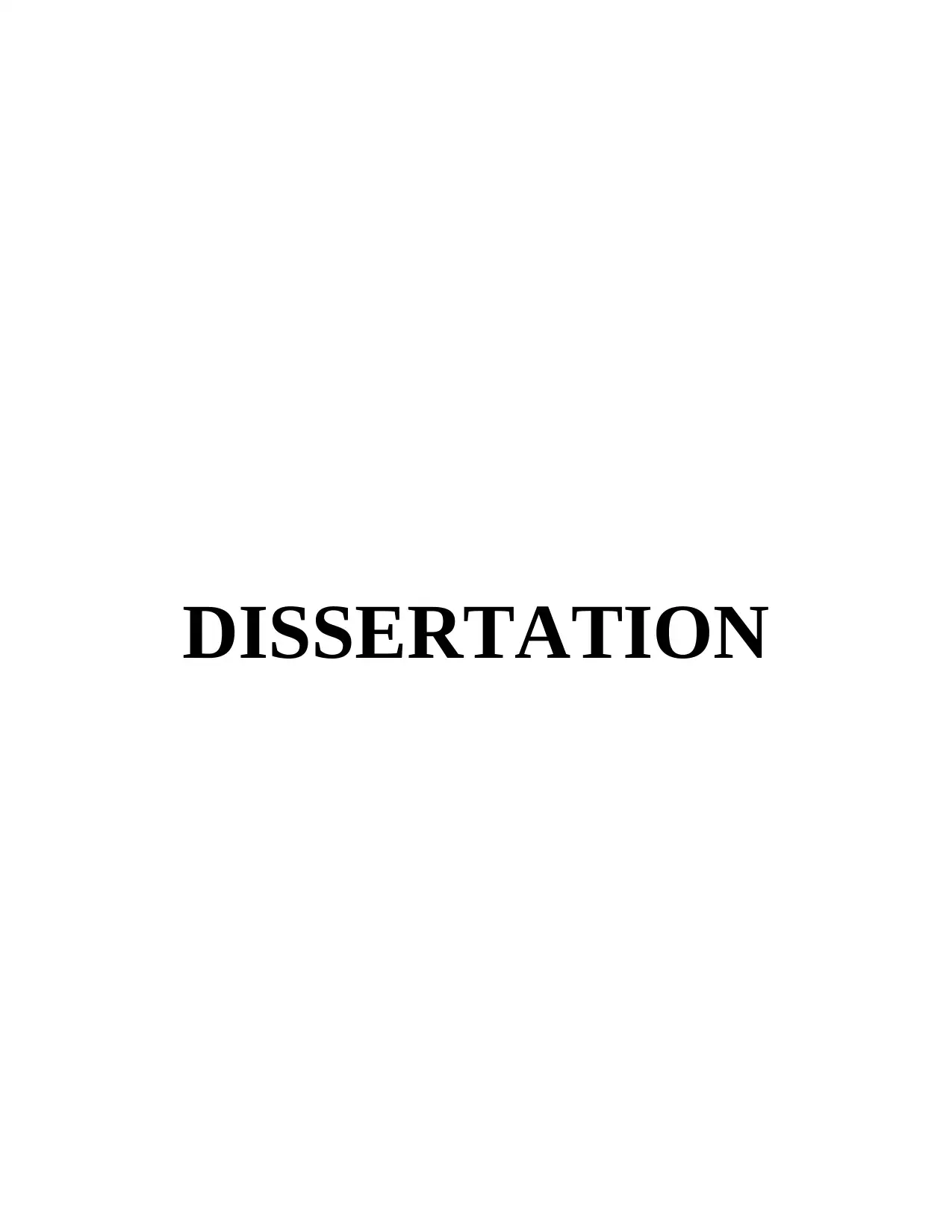
DISSERTATION
Secure Best Marks with AI Grader
Need help grading? Try our AI Grader for instant feedback on your assignments.
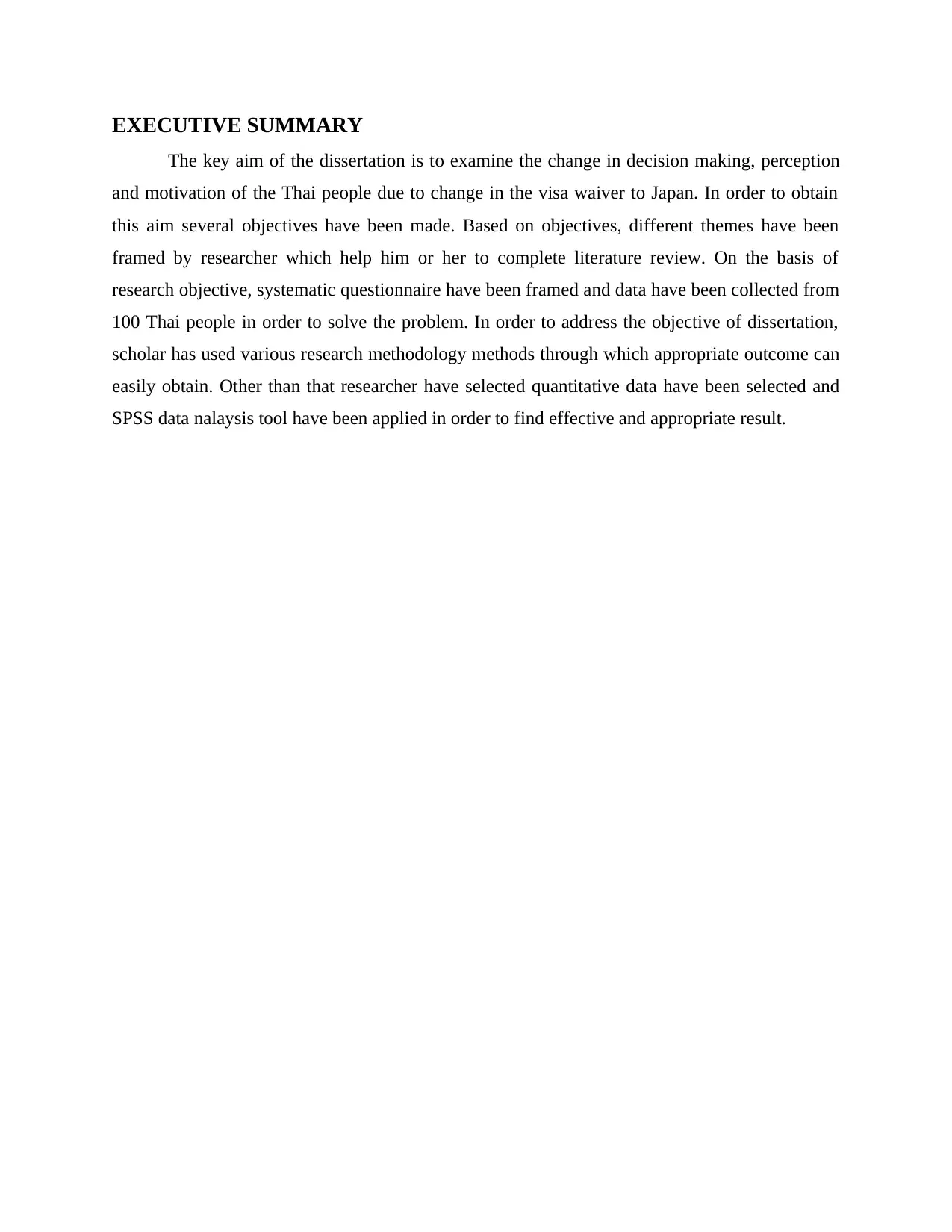
EXECUTIVE SUMMARY
The key aim of the dissertation is to examine the change in decision making, perception
and motivation of the Thai people due to change in the visa waiver to Japan. In order to obtain
this aim several objectives have been made. Based on objectives, different themes have been
framed by researcher which help him or her to complete literature review. On the basis of
research objective, systematic questionnaire have been framed and data have been collected from
100 Thai people in order to solve the problem. In order to address the objective of dissertation,
scholar has used various research methodology methods through which appropriate outcome can
easily obtain. Other than that researcher have selected quantitative data have been selected and
SPSS data nalaysis tool have been applied in order to find effective and appropriate result.
The key aim of the dissertation is to examine the change in decision making, perception
and motivation of the Thai people due to change in the visa waiver to Japan. In order to obtain
this aim several objectives have been made. Based on objectives, different themes have been
framed by researcher which help him or her to complete literature review. On the basis of
research objective, systematic questionnaire have been framed and data have been collected from
100 Thai people in order to solve the problem. In order to address the objective of dissertation,
scholar has used various research methodology methods through which appropriate outcome can
easily obtain. Other than that researcher have selected quantitative data have been selected and
SPSS data nalaysis tool have been applied in order to find effective and appropriate result.
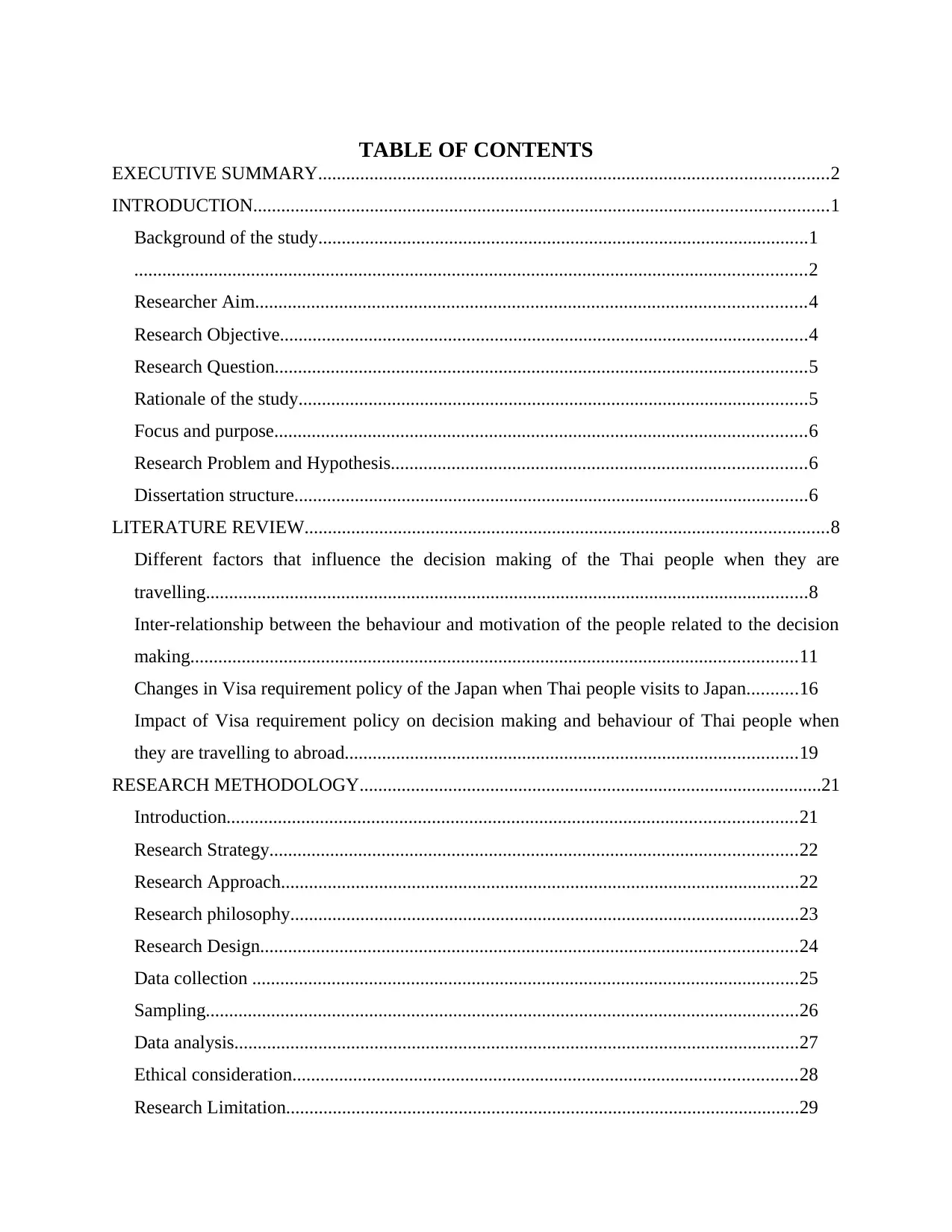
TABLE OF CONTENTS
EXECUTIVE SUMMARY.............................................................................................................2
INTRODUCTION...........................................................................................................................1
Background of the study.........................................................................................................1
................................................................................................................................................2
Researcher Aim......................................................................................................................4
Research Objective.................................................................................................................4
Research Question..................................................................................................................5
Rationale of the study.............................................................................................................5
Focus and purpose..................................................................................................................6
Research Problem and Hypothesis.........................................................................................6
Dissertation structure..............................................................................................................6
LITERATURE REVIEW................................................................................................................8
Different factors that influence the decision making of the Thai people when they are
travelling.................................................................................................................................8
Inter-relationship between the behaviour and motivation of the people related to the decision
making..................................................................................................................................11
Changes in Visa requirement policy of the Japan when Thai people visits to Japan...........16
Impact of Visa requirement policy on decision making and behaviour of Thai people when
they are travelling to abroad.................................................................................................19
RESEARCH METHODOLOGY...................................................................................................21
Introduction..........................................................................................................................21
Research Strategy.................................................................................................................22
Research Approach...............................................................................................................22
Research philosophy.............................................................................................................23
Research Design...................................................................................................................24
Data collection .....................................................................................................................25
Sampling...............................................................................................................................26
Data analysis.........................................................................................................................27
Ethical consideration............................................................................................................28
Research Limitation..............................................................................................................29
EXECUTIVE SUMMARY.............................................................................................................2
INTRODUCTION...........................................................................................................................1
Background of the study.........................................................................................................1
................................................................................................................................................2
Researcher Aim......................................................................................................................4
Research Objective.................................................................................................................4
Research Question..................................................................................................................5
Rationale of the study.............................................................................................................5
Focus and purpose..................................................................................................................6
Research Problem and Hypothesis.........................................................................................6
Dissertation structure..............................................................................................................6
LITERATURE REVIEW................................................................................................................8
Different factors that influence the decision making of the Thai people when they are
travelling.................................................................................................................................8
Inter-relationship between the behaviour and motivation of the people related to the decision
making..................................................................................................................................11
Changes in Visa requirement policy of the Japan when Thai people visits to Japan...........16
Impact of Visa requirement policy on decision making and behaviour of Thai people when
they are travelling to abroad.................................................................................................19
RESEARCH METHODOLOGY...................................................................................................21
Introduction..........................................................................................................................21
Research Strategy.................................................................................................................22
Research Approach...............................................................................................................22
Research philosophy.............................................................................................................23
Research Design...................................................................................................................24
Data collection .....................................................................................................................25
Sampling...............................................................................................................................26
Data analysis.........................................................................................................................27
Ethical consideration............................................................................................................28
Research Limitation..............................................................................................................29
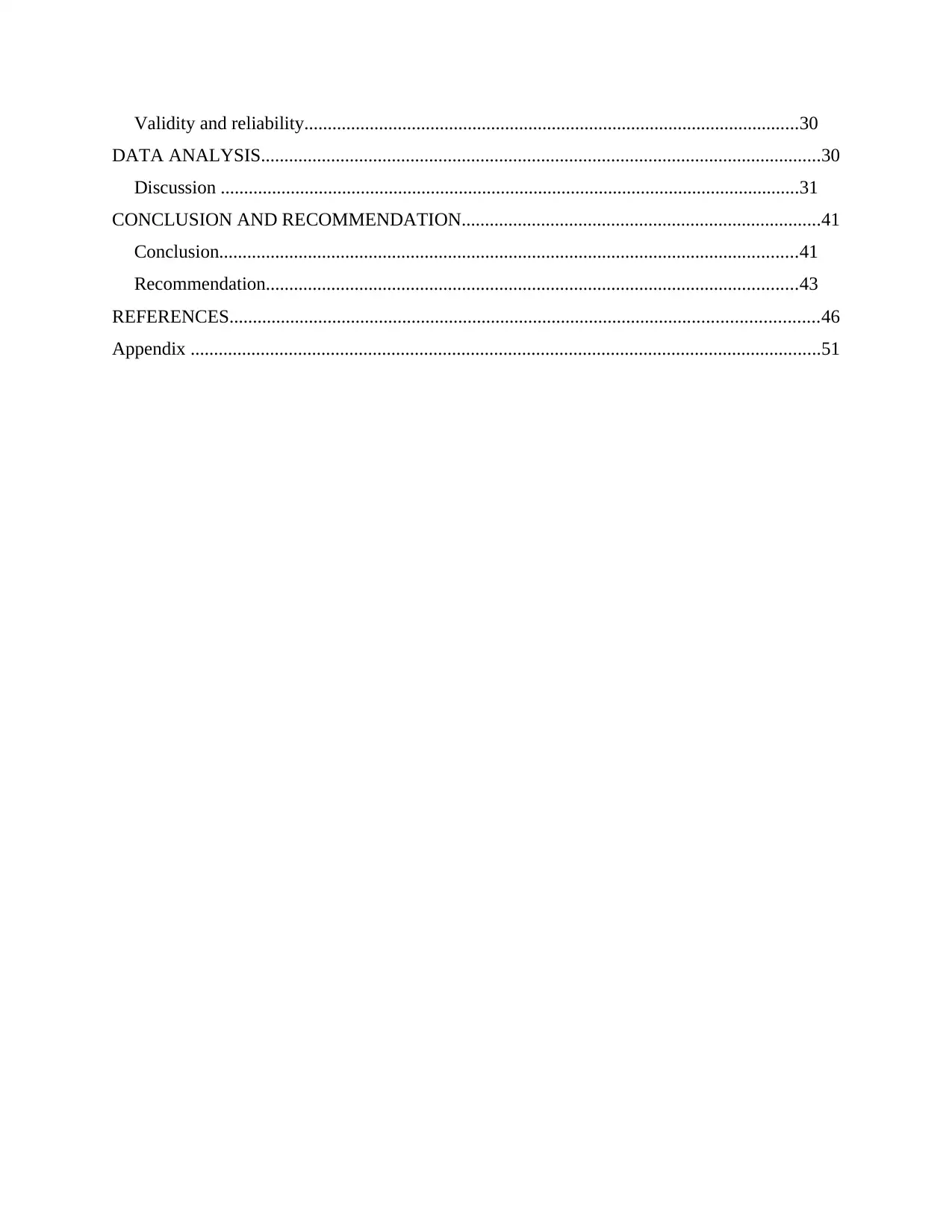
Validity and reliability..........................................................................................................30
DATA ANALYSIS........................................................................................................................30
Discussion ............................................................................................................................31
CONCLUSION AND RECOMMENDATION.............................................................................41
Conclusion............................................................................................................................41
Recommendation..................................................................................................................43
REFERENCES..............................................................................................................................46
Appendix .......................................................................................................................................51
DATA ANALYSIS........................................................................................................................30
Discussion ............................................................................................................................31
CONCLUSION AND RECOMMENDATION.............................................................................41
Conclusion............................................................................................................................41
Recommendation..................................................................................................................43
REFERENCES..............................................................................................................................46
Appendix .......................................................................................................................................51
Secure Best Marks with AI Grader
Need help grading? Try our AI Grader for instant feedback on your assignments.
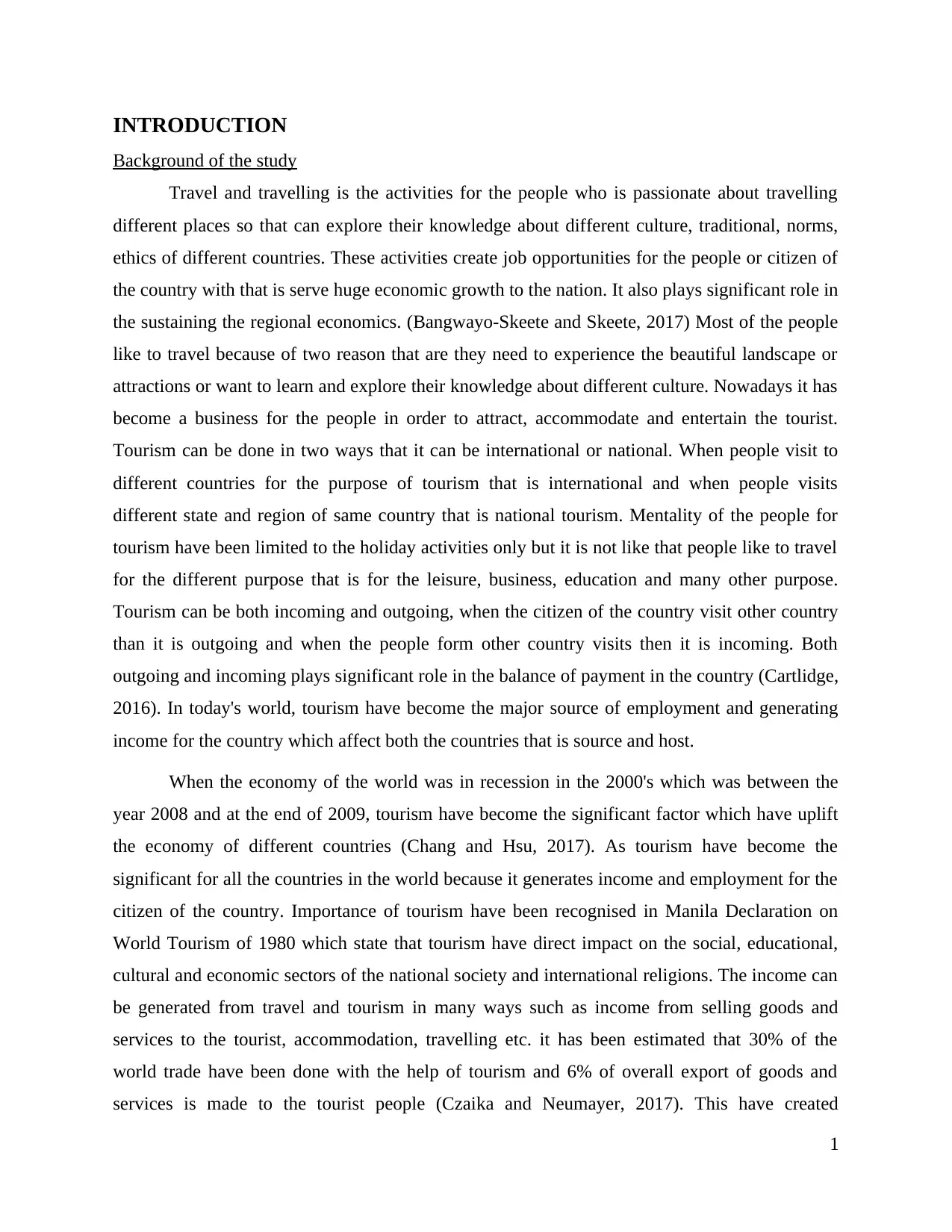
INTRODUCTION
Background of the study
Travel and travelling is the activities for the people who is passionate about travelling
different places so that can explore their knowledge about different culture, traditional, norms,
ethics of different countries. These activities create job opportunities for the people or citizen of
the country with that is serve huge economic growth to the nation. It also plays significant role in
the sustaining the regional economics. (Bangwayo-Skeete and Skeete, 2017) Most of the people
like to travel because of two reason that are they need to experience the beautiful landscape or
attractions or want to learn and explore their knowledge about different culture. Nowadays it has
become a business for the people in order to attract, accommodate and entertain the tourist.
Tourism can be done in two ways that it can be international or national. When people visit to
different countries for the purpose of tourism that is international and when people visits
different state and region of same country that is national tourism. Mentality of the people for
tourism have been limited to the holiday activities only but it is not like that people like to travel
for the different purpose that is for the leisure, business, education and many other purpose.
Tourism can be both incoming and outgoing, when the citizen of the country visit other country
than it is outgoing and when the people form other country visits then it is incoming. Both
outgoing and incoming plays significant role in the balance of payment in the country (Cartlidge,
2016). In today's world, tourism have become the major source of employment and generating
income for the country which affect both the countries that is source and host.
When the economy of the world was in recession in the 2000's which was between the
year 2008 and at the end of 2009, tourism have become the significant factor which have uplift
the economy of different countries (Chang and Hsu, 2017). As tourism have become the
significant for all the countries in the world because it generates income and employment for the
citizen of the country. Importance of tourism have been recognised in Manila Declaration on
World Tourism of 1980 which state that tourism have direct impact on the social, educational,
cultural and economic sectors of the national society and international religions. The income can
be generated from travel and tourism in many ways such as income from selling goods and
services to the tourist, accommodation, travelling etc. it has been estimated that 30% of the
world trade have been done with the help of tourism and 6% of overall export of goods and
services is made to the tourist people (Czaika and Neumayer, 2017). This have created
1
Background of the study
Travel and travelling is the activities for the people who is passionate about travelling
different places so that can explore their knowledge about different culture, traditional, norms,
ethics of different countries. These activities create job opportunities for the people or citizen of
the country with that is serve huge economic growth to the nation. It also plays significant role in
the sustaining the regional economics. (Bangwayo-Skeete and Skeete, 2017) Most of the people
like to travel because of two reason that are they need to experience the beautiful landscape or
attractions or want to learn and explore their knowledge about different culture. Nowadays it has
become a business for the people in order to attract, accommodate and entertain the tourist.
Tourism can be done in two ways that it can be international or national. When people visit to
different countries for the purpose of tourism that is international and when people visits
different state and region of same country that is national tourism. Mentality of the people for
tourism have been limited to the holiday activities only but it is not like that people like to travel
for the different purpose that is for the leisure, business, education and many other purpose.
Tourism can be both incoming and outgoing, when the citizen of the country visit other country
than it is outgoing and when the people form other country visits then it is incoming. Both
outgoing and incoming plays significant role in the balance of payment in the country (Cartlidge,
2016). In today's world, tourism have become the major source of employment and generating
income for the country which affect both the countries that is source and host.
When the economy of the world was in recession in the 2000's which was between the
year 2008 and at the end of 2009, tourism have become the significant factor which have uplift
the economy of different countries (Chang and Hsu, 2017). As tourism have become the
significant for all the countries in the world because it generates income and employment for the
citizen of the country. Importance of tourism have been recognised in Manila Declaration on
World Tourism of 1980 which state that tourism have direct impact on the social, educational,
cultural and economic sectors of the national society and international religions. The income can
be generated from travel and tourism in many ways such as income from selling goods and
services to the tourist, accommodation, travelling etc. it has been estimated that 30% of the
world trade have been done with the help of tourism and 6% of overall export of goods and
services is made to the tourist people (Czaika and Neumayer, 2017). This have created
1
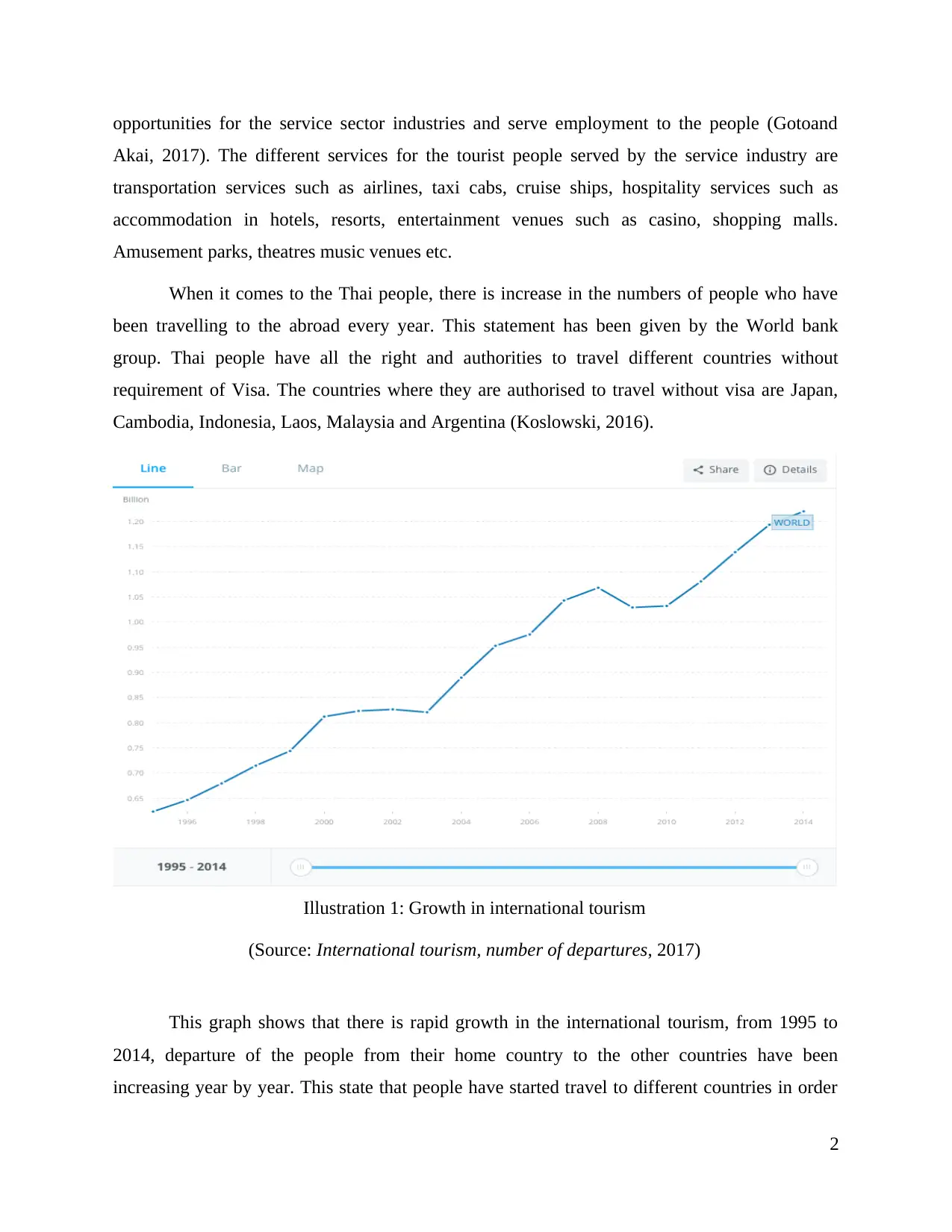
opportunities for the service sector industries and serve employment to the people (Gotoand
Akai, 2017). The different services for the tourist people served by the service industry are
transportation services such as airlines, taxi cabs, cruise ships, hospitality services such as
accommodation in hotels, resorts, entertainment venues such as casino, shopping malls.
Amusement parks, theatres music venues etc.
When it comes to the Thai people, there is increase in the numbers of people who have
been travelling to the abroad every year. This statement has been given by the World bank
group. Thai people have all the right and authorities to travel different countries without
requirement of Visa. The countries where they are authorised to travel without visa are Japan,
Cambodia, Indonesia, Laos, Malaysia and Argentina (Koslowski, 2016).
Illustration 1: Growth in international tourism
(Source: International tourism, number of departures, 2017)
This graph shows that there is rapid growth in the international tourism, from 1995 to
2014, departure of the people from their home country to the other countries have been
increasing year by year. This state that people have started travel to different countries in order
2
Akai, 2017). The different services for the tourist people served by the service industry are
transportation services such as airlines, taxi cabs, cruise ships, hospitality services such as
accommodation in hotels, resorts, entertainment venues such as casino, shopping malls.
Amusement parks, theatres music venues etc.
When it comes to the Thai people, there is increase in the numbers of people who have
been travelling to the abroad every year. This statement has been given by the World bank
group. Thai people have all the right and authorities to travel different countries without
requirement of Visa. The countries where they are authorised to travel without visa are Japan,
Cambodia, Indonesia, Laos, Malaysia and Argentina (Koslowski, 2016).
Illustration 1: Growth in international tourism
(Source: International tourism, number of departures, 2017)
This graph shows that there is rapid growth in the international tourism, from 1995 to
2014, departure of the people from their home country to the other countries have been
increasing year by year. This state that people have started travel to different countries in order
2
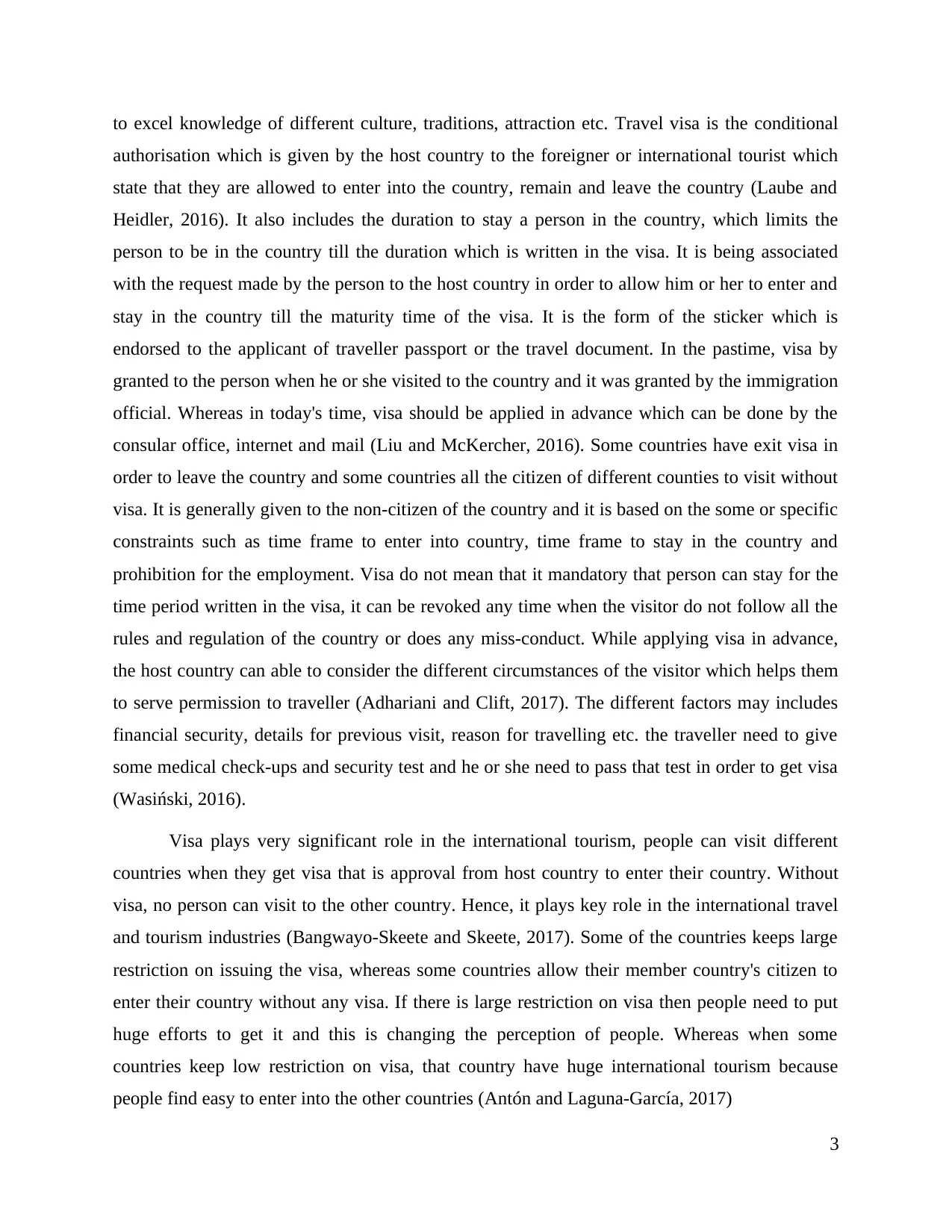
to excel knowledge of different culture, traditions, attraction etc. Travel visa is the conditional
authorisation which is given by the host country to the foreigner or international tourist which
state that they are allowed to enter into the country, remain and leave the country (Laube and
Heidler, 2016). It also includes the duration to stay a person in the country, which limits the
person to be in the country till the duration which is written in the visa. It is being associated
with the request made by the person to the host country in order to allow him or her to enter and
stay in the country till the maturity time of the visa. It is the form of the sticker which is
endorsed to the applicant of traveller passport or the travel document. In the pastime, visa by
granted to the person when he or she visited to the country and it was granted by the immigration
official. Whereas in today's time, visa should be applied in advance which can be done by the
consular office, internet and mail (Liu and McKercher, 2016). Some countries have exit visa in
order to leave the country and some countries all the citizen of different counties to visit without
visa. It is generally given to the non-citizen of the country and it is based on the some or specific
constraints such as time frame to enter into country, time frame to stay in the country and
prohibition for the employment. Visa do not mean that it mandatory that person can stay for the
time period written in the visa, it can be revoked any time when the visitor do not follow all the
rules and regulation of the country or does any miss-conduct. While applying visa in advance,
the host country can able to consider the different circumstances of the visitor which helps them
to serve permission to traveller (Adhariani and Clift, 2017). The different factors may includes
financial security, details for previous visit, reason for travelling etc. the traveller need to give
some medical check-ups and security test and he or she need to pass that test in order to get visa
(Wasiński, 2016).
Visa plays very significant role in the international tourism, people can visit different
countries when they get visa that is approval from host country to enter their country. Without
visa, no person can visit to the other country. Hence, it plays key role in the international travel
and tourism industries (Bangwayo-Skeete and Skeete, 2017). Some of the countries keeps large
restriction on issuing the visa, whereas some countries allow their member country's citizen to
enter their country without any visa. If there is large restriction on visa then people need to put
huge efforts to get it and this is changing the perception of people. Whereas when some
countries keep low restriction on visa, that country have huge international tourism because
people find easy to enter into the other countries (Antón and Laguna-García, 2017)
3
authorisation which is given by the host country to the foreigner or international tourist which
state that they are allowed to enter into the country, remain and leave the country (Laube and
Heidler, 2016). It also includes the duration to stay a person in the country, which limits the
person to be in the country till the duration which is written in the visa. It is being associated
with the request made by the person to the host country in order to allow him or her to enter and
stay in the country till the maturity time of the visa. It is the form of the sticker which is
endorsed to the applicant of traveller passport or the travel document. In the pastime, visa by
granted to the person when he or she visited to the country and it was granted by the immigration
official. Whereas in today's time, visa should be applied in advance which can be done by the
consular office, internet and mail (Liu and McKercher, 2016). Some countries have exit visa in
order to leave the country and some countries all the citizen of different counties to visit without
visa. It is generally given to the non-citizen of the country and it is based on the some or specific
constraints such as time frame to enter into country, time frame to stay in the country and
prohibition for the employment. Visa do not mean that it mandatory that person can stay for the
time period written in the visa, it can be revoked any time when the visitor do not follow all the
rules and regulation of the country or does any miss-conduct. While applying visa in advance,
the host country can able to consider the different circumstances of the visitor which helps them
to serve permission to traveller (Adhariani and Clift, 2017). The different factors may includes
financial security, details for previous visit, reason for travelling etc. the traveller need to give
some medical check-ups and security test and he or she need to pass that test in order to get visa
(Wasiński, 2016).
Visa plays very significant role in the international tourism, people can visit different
countries when they get visa that is approval from host country to enter their country. Without
visa, no person can visit to the other country. Hence, it plays key role in the international travel
and tourism industries (Bangwayo-Skeete and Skeete, 2017). Some of the countries keeps large
restriction on issuing the visa, whereas some countries allow their member country's citizen to
enter their country without any visa. If there is large restriction on visa then people need to put
huge efforts to get it and this is changing the perception of people. Whereas when some
countries keep low restriction on visa, that country have huge international tourism because
people find easy to enter into the other countries (Antón and Laguna-García, 2017)
3
Paraphrase This Document
Need a fresh take? Get an instant paraphrase of this document with our AI Paraphraser
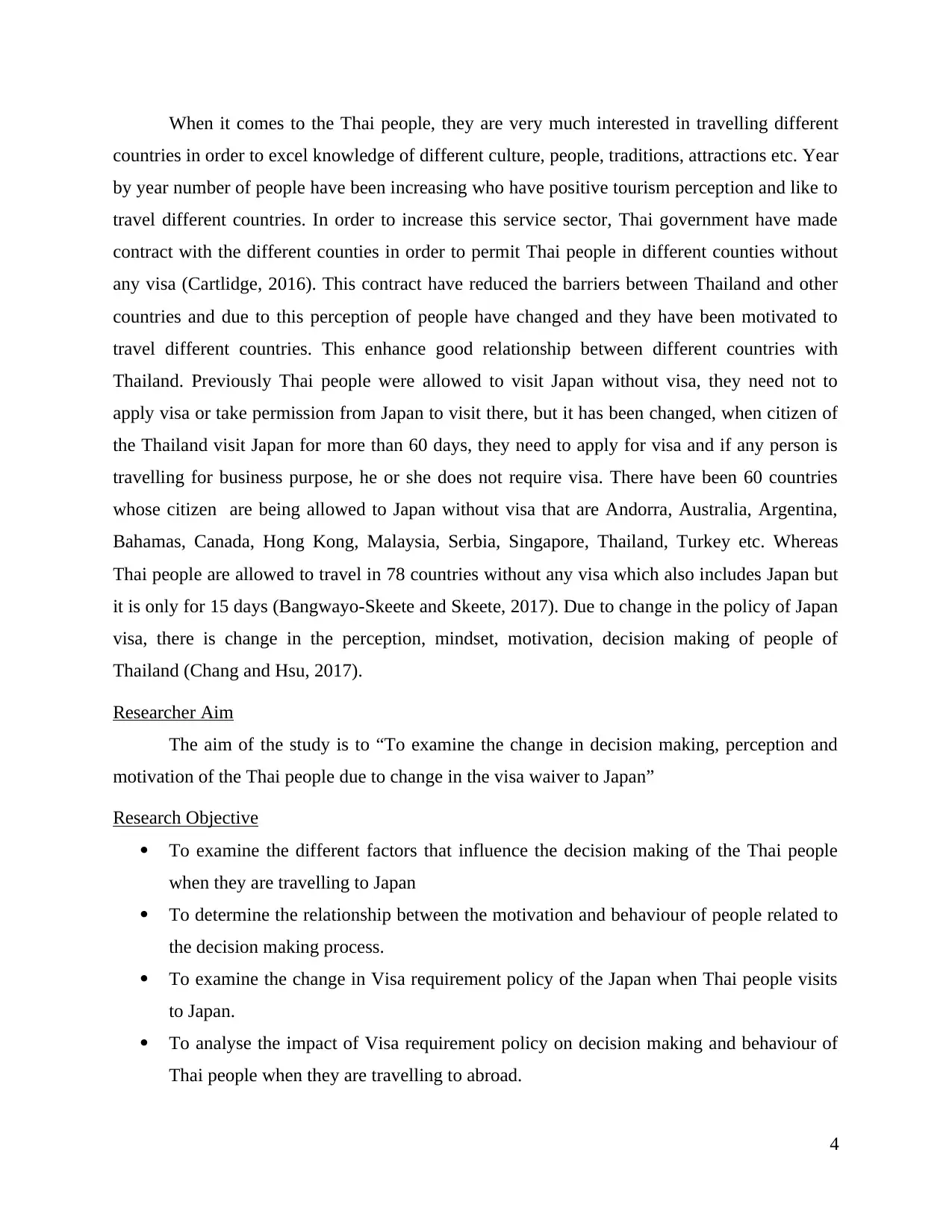
When it comes to the Thai people, they are very much interested in travelling different
countries in order to excel knowledge of different culture, people, traditions, attractions etc. Year
by year number of people have been increasing who have positive tourism perception and like to
travel different countries. In order to increase this service sector, Thai government have made
contract with the different counties in order to permit Thai people in different counties without
any visa (Cartlidge, 2016). This contract have reduced the barriers between Thailand and other
countries and due to this perception of people have changed and they have been motivated to
travel different countries. This enhance good relationship between different countries with
Thailand. Previously Thai people were allowed to visit Japan without visa, they need not to
apply visa or take permission from Japan to visit there, but it has been changed, when citizen of
the Thailand visit Japan for more than 60 days, they need to apply for visa and if any person is
travelling for business purpose, he or she does not require visa. There have been 60 countries
whose citizen are being allowed to Japan without visa that are Andorra, Australia, Argentina,
Bahamas, Canada, Hong Kong, Malaysia, Serbia, Singapore, Thailand, Turkey etc. Whereas
Thai people are allowed to travel in 78 countries without any visa which also includes Japan but
it is only for 15 days (Bangwayo-Skeete and Skeete, 2017). Due to change in the policy of Japan
visa, there is change in the perception, mindset, motivation, decision making of people of
Thailand (Chang and Hsu, 2017).
Researcher Aim
The aim of the study is to “To examine the change in decision making, perception and
motivation of the Thai people due to change in the visa waiver to Japan”
Research Objective
To examine the different factors that influence the decision making of the Thai people
when they are travelling to Japan
To determine the relationship between the motivation and behaviour of people related to
the decision making process.
To examine the change in Visa requirement policy of the Japan when Thai people visits
to Japan.
To analyse the impact of Visa requirement policy on decision making and behaviour of
Thai people when they are travelling to abroad.
4
countries in order to excel knowledge of different culture, people, traditions, attractions etc. Year
by year number of people have been increasing who have positive tourism perception and like to
travel different countries. In order to increase this service sector, Thai government have made
contract with the different counties in order to permit Thai people in different counties without
any visa (Cartlidge, 2016). This contract have reduced the barriers between Thailand and other
countries and due to this perception of people have changed and they have been motivated to
travel different countries. This enhance good relationship between different countries with
Thailand. Previously Thai people were allowed to visit Japan without visa, they need not to
apply visa or take permission from Japan to visit there, but it has been changed, when citizen of
the Thailand visit Japan for more than 60 days, they need to apply for visa and if any person is
travelling for business purpose, he or she does not require visa. There have been 60 countries
whose citizen are being allowed to Japan without visa that are Andorra, Australia, Argentina,
Bahamas, Canada, Hong Kong, Malaysia, Serbia, Singapore, Thailand, Turkey etc. Whereas
Thai people are allowed to travel in 78 countries without any visa which also includes Japan but
it is only for 15 days (Bangwayo-Skeete and Skeete, 2017). Due to change in the policy of Japan
visa, there is change in the perception, mindset, motivation, decision making of people of
Thailand (Chang and Hsu, 2017).
Researcher Aim
The aim of the study is to “To examine the change in decision making, perception and
motivation of the Thai people due to change in the visa waiver to Japan”
Research Objective
To examine the different factors that influence the decision making of the Thai people
when they are travelling to Japan
To determine the relationship between the motivation and behaviour of people related to
the decision making process.
To examine the change in Visa requirement policy of the Japan when Thai people visits
to Japan.
To analyse the impact of Visa requirement policy on decision making and behaviour of
Thai people when they are travelling to abroad.
4
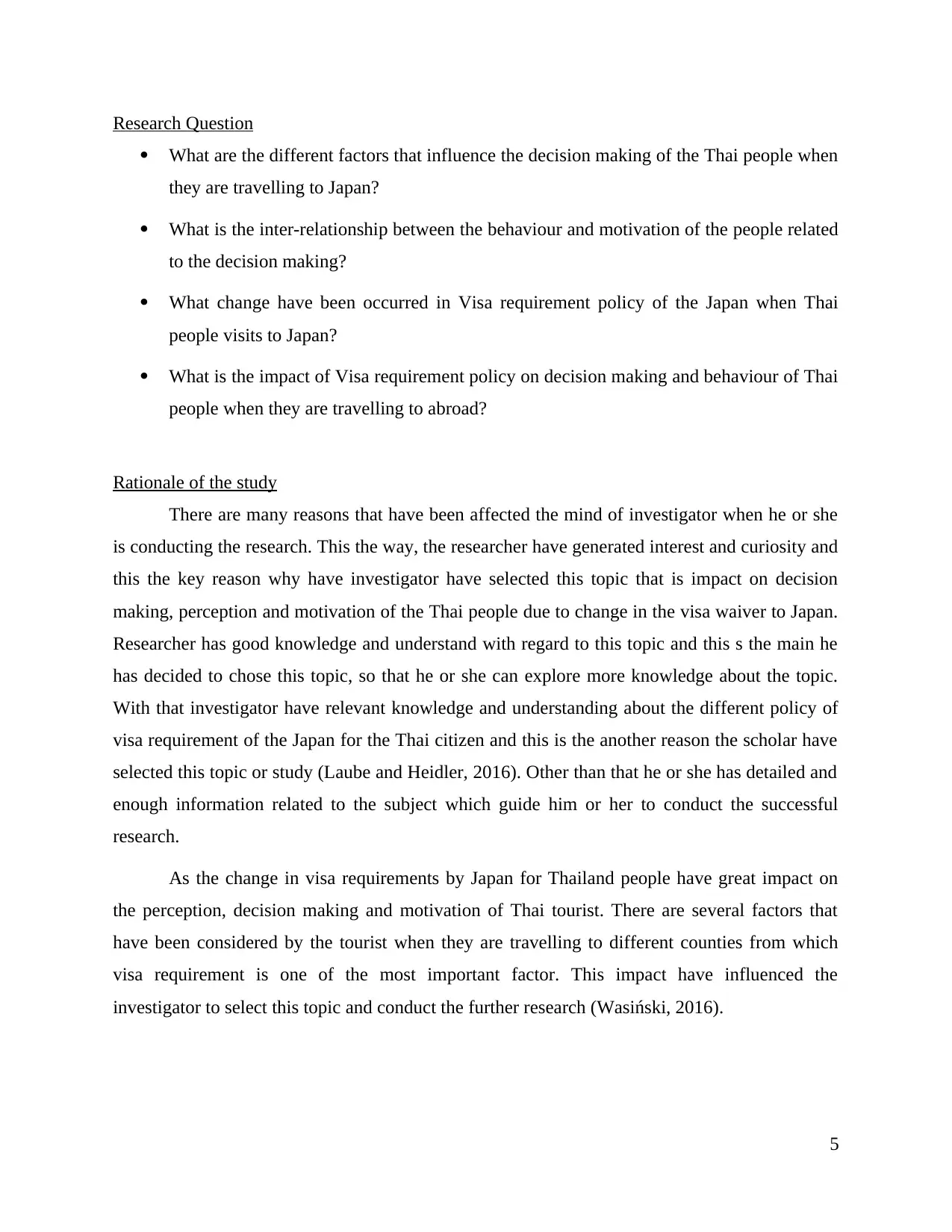
Research Question
What are the different factors that influence the decision making of the Thai people when
they are travelling to Japan?
What is the inter-relationship between the behaviour and motivation of the people related
to the decision making?
What change have been occurred in Visa requirement policy of the Japan when Thai
people visits to Japan?
What is the impact of Visa requirement policy on decision making and behaviour of Thai
people when they are travelling to abroad?
Rationale of the study
There are many reasons that have been affected the mind of investigator when he or she
is conducting the research. This the way, the researcher have generated interest and curiosity and
this the key reason why have investigator have selected this topic that is impact on decision
making, perception and motivation of the Thai people due to change in the visa waiver to Japan.
Researcher has good knowledge and understand with regard to this topic and this s the main he
has decided to chose this topic, so that he or she can explore more knowledge about the topic.
With that investigator have relevant knowledge and understanding about the different policy of
visa requirement of the Japan for the Thai citizen and this is the another reason the scholar have
selected this topic or study (Laube and Heidler, 2016). Other than that he or she has detailed and
enough information related to the subject which guide him or her to conduct the successful
research.
As the change in visa requirements by Japan for Thailand people have great impact on
the perception, decision making and motivation of Thai tourist. There are several factors that
have been considered by the tourist when they are travelling to different counties from which
visa requirement is one of the most important factor. This impact have influenced the
investigator to select this topic and conduct the further research (Wasiński, 2016).
5
What are the different factors that influence the decision making of the Thai people when
they are travelling to Japan?
What is the inter-relationship between the behaviour and motivation of the people related
to the decision making?
What change have been occurred in Visa requirement policy of the Japan when Thai
people visits to Japan?
What is the impact of Visa requirement policy on decision making and behaviour of Thai
people when they are travelling to abroad?
Rationale of the study
There are many reasons that have been affected the mind of investigator when he or she
is conducting the research. This the way, the researcher have generated interest and curiosity and
this the key reason why have investigator have selected this topic that is impact on decision
making, perception and motivation of the Thai people due to change in the visa waiver to Japan.
Researcher has good knowledge and understand with regard to this topic and this s the main he
has decided to chose this topic, so that he or she can explore more knowledge about the topic.
With that investigator have relevant knowledge and understanding about the different policy of
visa requirement of the Japan for the Thai citizen and this is the another reason the scholar have
selected this topic or study (Laube and Heidler, 2016). Other than that he or she has detailed and
enough information related to the subject which guide him or her to conduct the successful
research.
As the change in visa requirements by Japan for Thailand people have great impact on
the perception, decision making and motivation of Thai tourist. There are several factors that
have been considered by the tourist when they are travelling to different counties from which
visa requirement is one of the most important factor. This impact have influenced the
investigator to select this topic and conduct the further research (Wasiński, 2016).
5
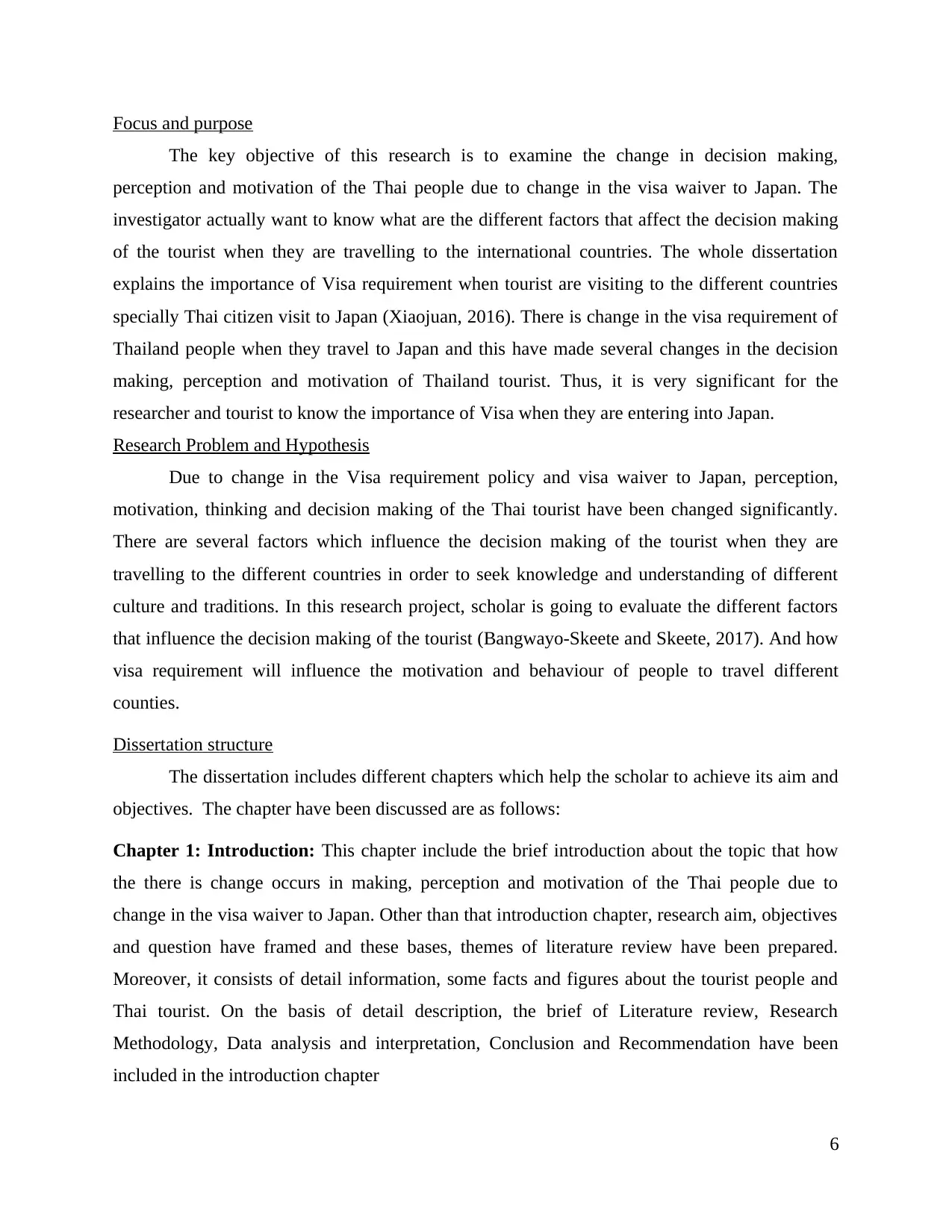
Focus and purpose
The key objective of this research is to examine the change in decision making,
perception and motivation of the Thai people due to change in the visa waiver to Japan. The
investigator actually want to know what are the different factors that affect the decision making
of the tourist when they are travelling to the international countries. The whole dissertation
explains the importance of Visa requirement when tourist are visiting to the different countries
specially Thai citizen visit to Japan (Xiaojuan, 2016). There is change in the visa requirement of
Thailand people when they travel to Japan and this have made several changes in the decision
making, perception and motivation of Thailand tourist. Thus, it is very significant for the
researcher and tourist to know the importance of Visa when they are entering into Japan.
Research Problem and Hypothesis
Due to change in the Visa requirement policy and visa waiver to Japan, perception,
motivation, thinking and decision making of the Thai tourist have been changed significantly.
There are several factors which influence the decision making of the tourist when they are
travelling to the different countries in order to seek knowledge and understanding of different
culture and traditions. In this research project, scholar is going to evaluate the different factors
that influence the decision making of the tourist (Bangwayo-Skeete and Skeete, 2017). And how
visa requirement will influence the motivation and behaviour of people to travel different
counties.
Dissertation structure
The dissertation includes different chapters which help the scholar to achieve its aim and
objectives. The chapter have been discussed are as follows:
Chapter 1: Introduction: This chapter include the brief introduction about the topic that how
the there is change occurs in making, perception and motivation of the Thai people due to
change in the visa waiver to Japan. Other than that introduction chapter, research aim, objectives
and question have framed and these bases, themes of literature review have been prepared.
Moreover, it consists of detail information, some facts and figures about the tourist people and
Thai tourist. On the basis of detail description, the brief of Literature review, Research
Methodology, Data analysis and interpretation, Conclusion and Recommendation have been
included in the introduction chapter
6
The key objective of this research is to examine the change in decision making,
perception and motivation of the Thai people due to change in the visa waiver to Japan. The
investigator actually want to know what are the different factors that affect the decision making
of the tourist when they are travelling to the international countries. The whole dissertation
explains the importance of Visa requirement when tourist are visiting to the different countries
specially Thai citizen visit to Japan (Xiaojuan, 2016). There is change in the visa requirement of
Thailand people when they travel to Japan and this have made several changes in the decision
making, perception and motivation of Thailand tourist. Thus, it is very significant for the
researcher and tourist to know the importance of Visa when they are entering into Japan.
Research Problem and Hypothesis
Due to change in the Visa requirement policy and visa waiver to Japan, perception,
motivation, thinking and decision making of the Thai tourist have been changed significantly.
There are several factors which influence the decision making of the tourist when they are
travelling to the different countries in order to seek knowledge and understanding of different
culture and traditions. In this research project, scholar is going to evaluate the different factors
that influence the decision making of the tourist (Bangwayo-Skeete and Skeete, 2017). And how
visa requirement will influence the motivation and behaviour of people to travel different
counties.
Dissertation structure
The dissertation includes different chapters which help the scholar to achieve its aim and
objectives. The chapter have been discussed are as follows:
Chapter 1: Introduction: This chapter include the brief introduction about the topic that how
the there is change occurs in making, perception and motivation of the Thai people due to
change in the visa waiver to Japan. Other than that introduction chapter, research aim, objectives
and question have framed and these bases, themes of literature review have been prepared.
Moreover, it consists of detail information, some facts and figures about the tourist people and
Thai tourist. On the basis of detail description, the brief of Literature review, Research
Methodology, Data analysis and interpretation, Conclusion and Recommendation have been
included in the introduction chapter
6
Secure Best Marks with AI Grader
Need help grading? Try our AI Grader for instant feedback on your assignments.
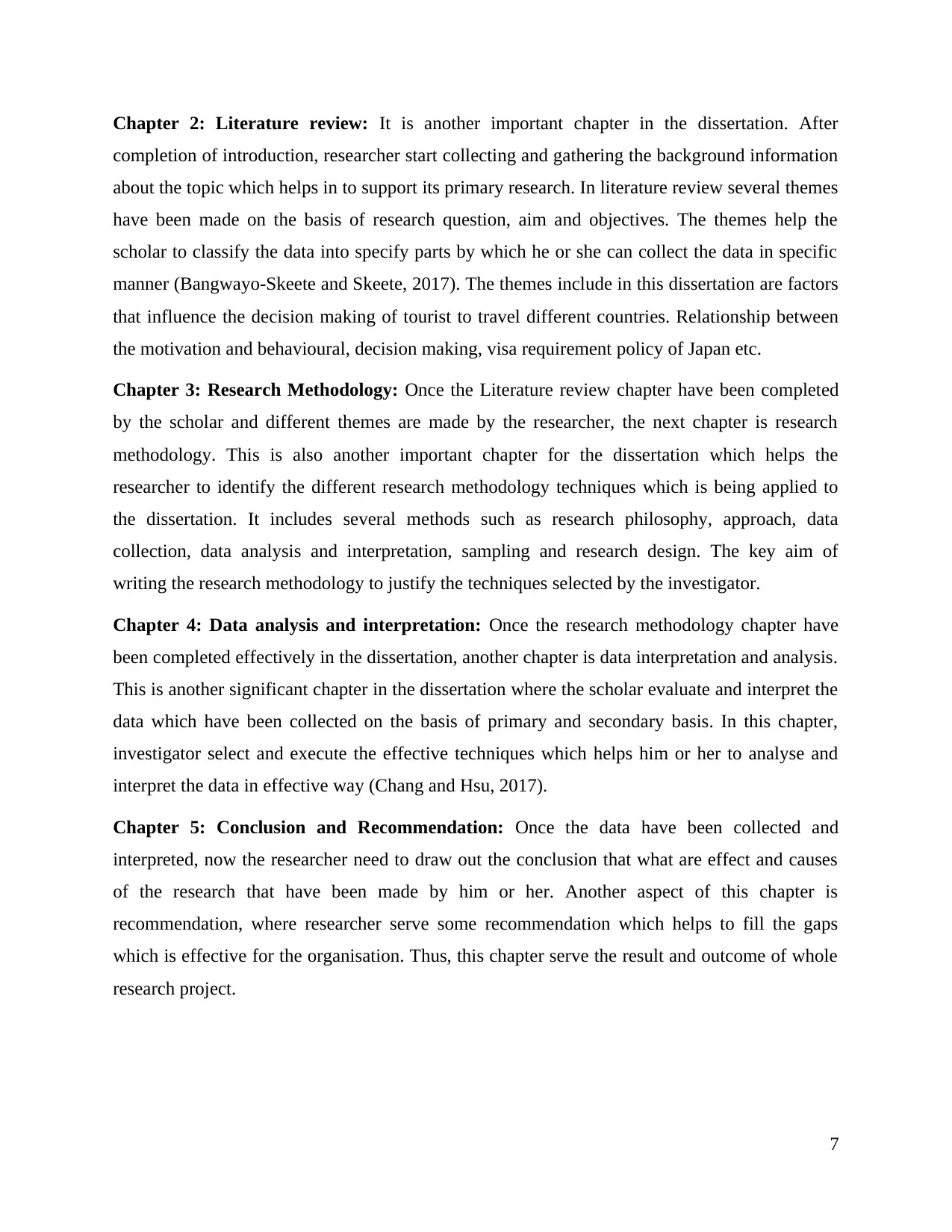
Chapter 2: Literature review: It is another important chapter in the dissertation. After
completion of introduction, researcher start collecting and gathering the background information
about the topic which helps in to support its primary research. In literature review several themes
have been made on the basis of research question, aim and objectives. The themes help the
scholar to classify the data into specify parts by which he or she can collect the data in specific
manner (Bangwayo-Skeete and Skeete, 2017). The themes include in this dissertation are factors
that influence the decision making of tourist to travel different countries. Relationship between
the motivation and behavioural, decision making, visa requirement policy of Japan etc.
Chapter 3: Research Methodology: Once the Literature review chapter have been completed
by the scholar and different themes are made by the researcher, the next chapter is research
methodology. This is also another important chapter for the dissertation which helps the
researcher to identify the different research methodology techniques which is being applied to
the dissertation. It includes several methods such as research philosophy, approach, data
collection, data analysis and interpretation, sampling and research design. The key aim of
writing the research methodology to justify the techniques selected by the investigator.
Chapter 4: Data analysis and interpretation: Once the research methodology chapter have
been completed effectively in the dissertation, another chapter is data interpretation and analysis.
This is another significant chapter in the dissertation where the scholar evaluate and interpret the
data which have been collected on the basis of primary and secondary basis. In this chapter,
investigator select and execute the effective techniques which helps him or her to analyse and
interpret the data in effective way (Chang and Hsu, 2017).
Chapter 5: Conclusion and Recommendation: Once the data have been collected and
interpreted, now the researcher need to draw out the conclusion that what are effect and causes
of the research that have been made by him or her. Another aspect of this chapter is
recommendation, where researcher serve some recommendation which helps to fill the gaps
which is effective for the organisation. Thus, this chapter serve the result and outcome of whole
research project.
7
completion of introduction, researcher start collecting and gathering the background information
about the topic which helps in to support its primary research. In literature review several themes
have been made on the basis of research question, aim and objectives. The themes help the
scholar to classify the data into specify parts by which he or she can collect the data in specific
manner (Bangwayo-Skeete and Skeete, 2017). The themes include in this dissertation are factors
that influence the decision making of tourist to travel different countries. Relationship between
the motivation and behavioural, decision making, visa requirement policy of Japan etc.
Chapter 3: Research Methodology: Once the Literature review chapter have been completed
by the scholar and different themes are made by the researcher, the next chapter is research
methodology. This is also another important chapter for the dissertation which helps the
researcher to identify the different research methodology techniques which is being applied to
the dissertation. It includes several methods such as research philosophy, approach, data
collection, data analysis and interpretation, sampling and research design. The key aim of
writing the research methodology to justify the techniques selected by the investigator.
Chapter 4: Data analysis and interpretation: Once the research methodology chapter have
been completed effectively in the dissertation, another chapter is data interpretation and analysis.
This is another significant chapter in the dissertation where the scholar evaluate and interpret the
data which have been collected on the basis of primary and secondary basis. In this chapter,
investigator select and execute the effective techniques which helps him or her to analyse and
interpret the data in effective way (Chang and Hsu, 2017).
Chapter 5: Conclusion and Recommendation: Once the data have been collected and
interpreted, now the researcher need to draw out the conclusion that what are effect and causes
of the research that have been made by him or her. Another aspect of this chapter is
recommendation, where researcher serve some recommendation which helps to fill the gaps
which is effective for the organisation. Thus, this chapter serve the result and outcome of whole
research project.
7
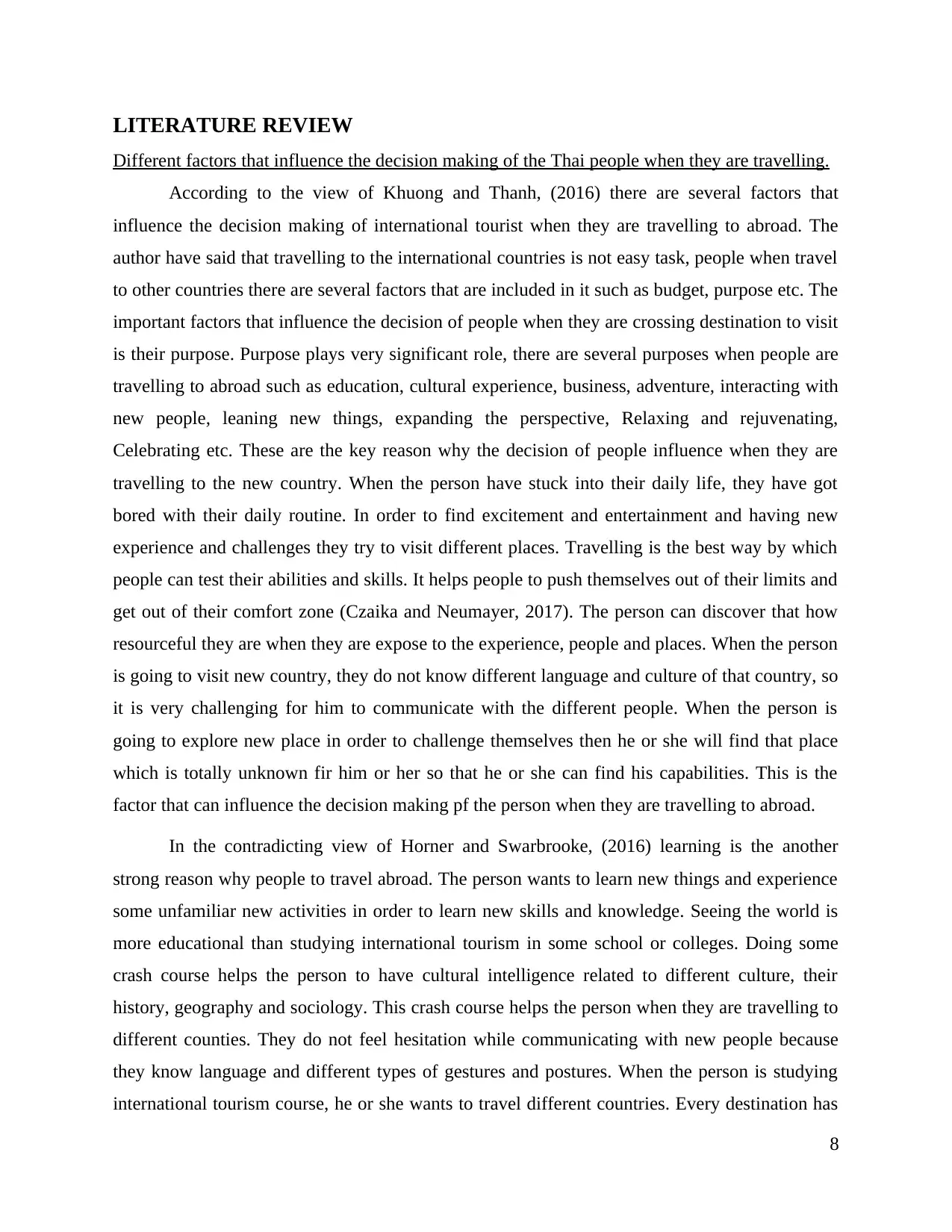
LITERATURE REVIEW
Different factors that influence the decision making of the Thai people when they are travelling.
According to the view of Khuong and Thanh, (2016) there are several factors that
influence the decision making of international tourist when they are travelling to abroad. The
author have said that travelling to the international countries is not easy task, people when travel
to other countries there are several factors that are included in it such as budget, purpose etc. The
important factors that influence the decision of people when they are crossing destination to visit
is their purpose. Purpose plays very significant role, there are several purposes when people are
travelling to abroad such as education, cultural experience, business, adventure, interacting with
new people, leaning new things, expanding the perspective, Relaxing and rejuvenating,
Celebrating etc. These are the key reason why the decision of people influence when they are
travelling to the new country. When the person have stuck into their daily life, they have got
bored with their daily routine. In order to find excitement and entertainment and having new
experience and challenges they try to visit different places. Travelling is the best way by which
people can test their abilities and skills. It helps people to push themselves out of their limits and
get out of their comfort zone (Czaika and Neumayer, 2017). The person can discover that how
resourceful they are when they are expose to the experience, people and places. When the person
is going to visit new country, they do not know different language and culture of that country, so
it is very challenging for him to communicate with the different people. When the person is
going to explore new place in order to challenge themselves then he or she will find that place
which is totally unknown fir him or her so that he or she can find his capabilities. This is the
factor that can influence the decision making pf the person when they are travelling to abroad.
In the contradicting view of Horner and Swarbrooke, (2016) learning is the another
strong reason why people to travel abroad. The person wants to learn new things and experience
some unfamiliar new activities in order to learn new skills and knowledge. Seeing the world is
more educational than studying international tourism in some school or colleges. Doing some
crash course helps the person to have cultural intelligence related to different culture, their
history, geography and sociology. This crash course helps the person when they are travelling to
different counties. They do not feel hesitation while communicating with new people because
they know language and different types of gestures and postures. When the person is studying
international tourism course, he or she wants to travel different countries. Every destination has
8
Different factors that influence the decision making of the Thai people when they are travelling.
According to the view of Khuong and Thanh, (2016) there are several factors that
influence the decision making of international tourist when they are travelling to abroad. The
author have said that travelling to the international countries is not easy task, people when travel
to other countries there are several factors that are included in it such as budget, purpose etc. The
important factors that influence the decision of people when they are crossing destination to visit
is their purpose. Purpose plays very significant role, there are several purposes when people are
travelling to abroad such as education, cultural experience, business, adventure, interacting with
new people, leaning new things, expanding the perspective, Relaxing and rejuvenating,
Celebrating etc. These are the key reason why the decision of people influence when they are
travelling to the new country. When the person have stuck into their daily life, they have got
bored with their daily routine. In order to find excitement and entertainment and having new
experience and challenges they try to visit different places. Travelling is the best way by which
people can test their abilities and skills. It helps people to push themselves out of their limits and
get out of their comfort zone (Czaika and Neumayer, 2017). The person can discover that how
resourceful they are when they are expose to the experience, people and places. When the person
is going to visit new country, they do not know different language and culture of that country, so
it is very challenging for him to communicate with the different people. When the person is
going to explore new place in order to challenge themselves then he or she will find that place
which is totally unknown fir him or her so that he or she can find his capabilities. This is the
factor that can influence the decision making pf the person when they are travelling to abroad.
In the contradicting view of Horner and Swarbrooke, (2016) learning is the another
strong reason why people to travel abroad. The person wants to learn new things and experience
some unfamiliar new activities in order to learn new skills and knowledge. Seeing the world is
more educational than studying international tourism in some school or colleges. Doing some
crash course helps the person to have cultural intelligence related to different culture, their
history, geography and sociology. This crash course helps the person when they are travelling to
different counties. They do not feel hesitation while communicating with new people because
they know language and different types of gestures and postures. When the person is studying
international tourism course, he or she wants to travel different countries. Every destination has
8
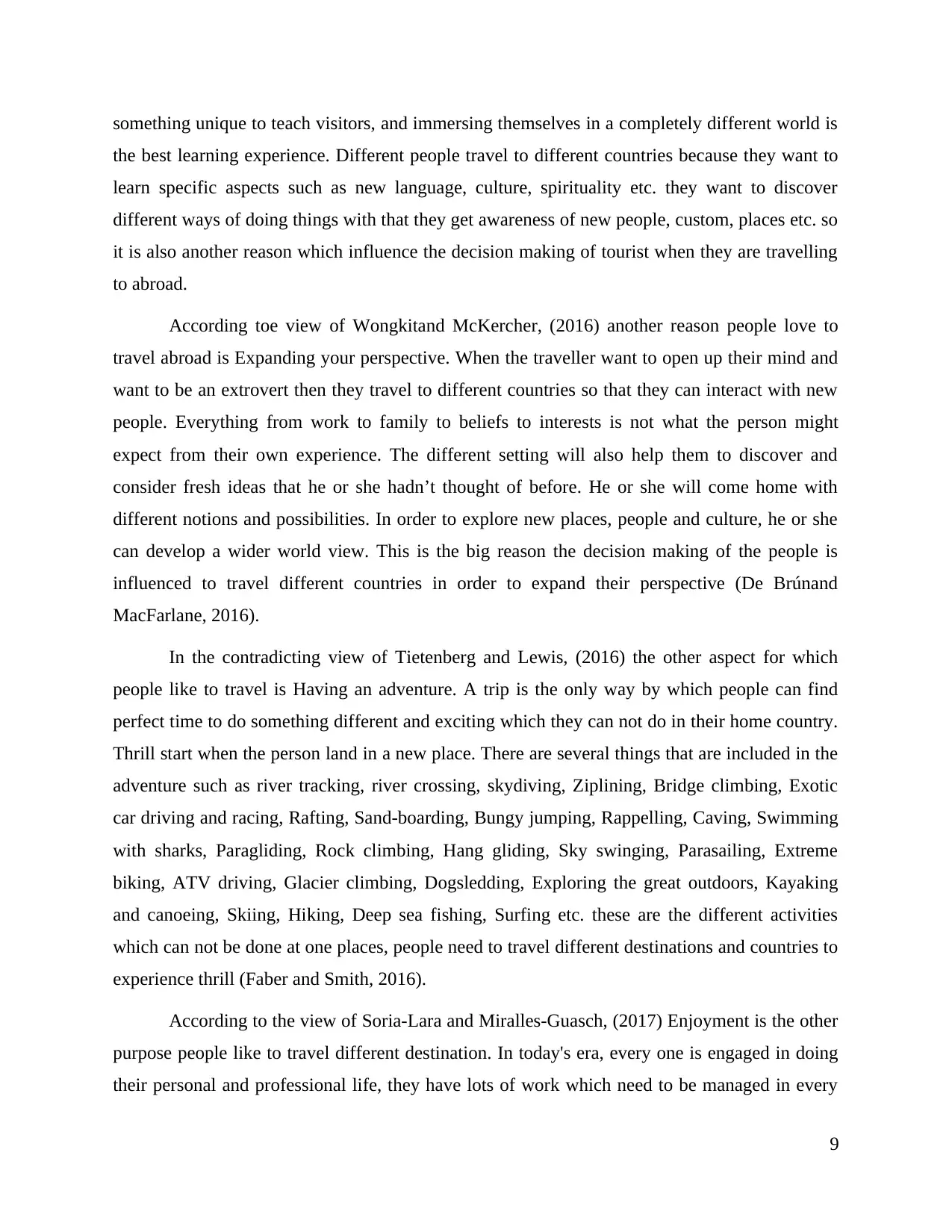
something unique to teach visitors, and immersing themselves in a completely different world is
the best learning experience. Different people travel to different countries because they want to
learn specific aspects such as new language, culture, spirituality etc. they want to discover
different ways of doing things with that they get awareness of new people, custom, places etc. so
it is also another reason which influence the decision making of tourist when they are travelling
to abroad.
According toe view of Wongkitand McKercher, (2016) another reason people love to
travel abroad is Expanding your perspective. When the traveller want to open up their mind and
want to be an extrovert then they travel to different countries so that they can interact with new
people. Everything from work to family to beliefs to interests is not what the person might
expect from their own experience. The different setting will also help them to discover and
consider fresh ideas that he or she hadn’t thought of before. He or she will come home with
different notions and possibilities. In order to explore new places, people and culture, he or she
can develop a wider world view. This is the big reason the decision making of the people is
influenced to travel different countries in order to expand their perspective (De Brúnand
MacFarlane, 2016).
In the contradicting view of Tietenberg and Lewis, (2016) the other aspect for which
people like to travel is Having an adventure. A trip is the only way by which people can find
perfect time to do something different and exciting which they can not do in their home country.
Thrill start when the person land in a new place. There are several things that are included in the
adventure such as river tracking, river crossing, skydiving, Ziplining, Bridge climbing, Exotic
car driving and racing, Rafting, Sand-boarding, Bungy jumping, Rappelling, Caving, Swimming
with sharks, Paragliding, Rock climbing, Hang gliding, Sky swinging, Parasailing, Extreme
biking, ATV driving, Glacier climbing, Dogsledding, Exploring the great outdoors, Kayaking
and canoeing, Skiing, Hiking, Deep sea fishing, Surfing etc. these are the different activities
which can not be done at one places, people need to travel different destinations and countries to
experience thrill (Faber and Smith, 2016).
According to the view of Soria-Lara and Miralles-Guasch, (2017) Enjoyment is the other
purpose people like to travel different destination. In today's era, every one is engaged in doing
their personal and professional life, they have lots of work which need to be managed in every
9
the best learning experience. Different people travel to different countries because they want to
learn specific aspects such as new language, culture, spirituality etc. they want to discover
different ways of doing things with that they get awareness of new people, custom, places etc. so
it is also another reason which influence the decision making of tourist when they are travelling
to abroad.
According toe view of Wongkitand McKercher, (2016) another reason people love to
travel abroad is Expanding your perspective. When the traveller want to open up their mind and
want to be an extrovert then they travel to different countries so that they can interact with new
people. Everything from work to family to beliefs to interests is not what the person might
expect from their own experience. The different setting will also help them to discover and
consider fresh ideas that he or she hadn’t thought of before. He or she will come home with
different notions and possibilities. In order to explore new places, people and culture, he or she
can develop a wider world view. This is the big reason the decision making of the people is
influenced to travel different countries in order to expand their perspective (De Brúnand
MacFarlane, 2016).
In the contradicting view of Tietenberg and Lewis, (2016) the other aspect for which
people like to travel is Having an adventure. A trip is the only way by which people can find
perfect time to do something different and exciting which they can not do in their home country.
Thrill start when the person land in a new place. There are several things that are included in the
adventure such as river tracking, river crossing, skydiving, Ziplining, Bridge climbing, Exotic
car driving and racing, Rafting, Sand-boarding, Bungy jumping, Rappelling, Caving, Swimming
with sharks, Paragliding, Rock climbing, Hang gliding, Sky swinging, Parasailing, Extreme
biking, ATV driving, Glacier climbing, Dogsledding, Exploring the great outdoors, Kayaking
and canoeing, Skiing, Hiking, Deep sea fishing, Surfing etc. these are the different activities
which can not be done at one places, people need to travel different destinations and countries to
experience thrill (Faber and Smith, 2016).
According to the view of Soria-Lara and Miralles-Guasch, (2017) Enjoyment is the other
purpose people like to travel different destination. In today's era, every one is engaged in doing
their personal and professional life, they have lots of work which need to be managed in every
9
Paraphrase This Document
Need a fresh take? Get an instant paraphrase of this document with our AI Paraphraser
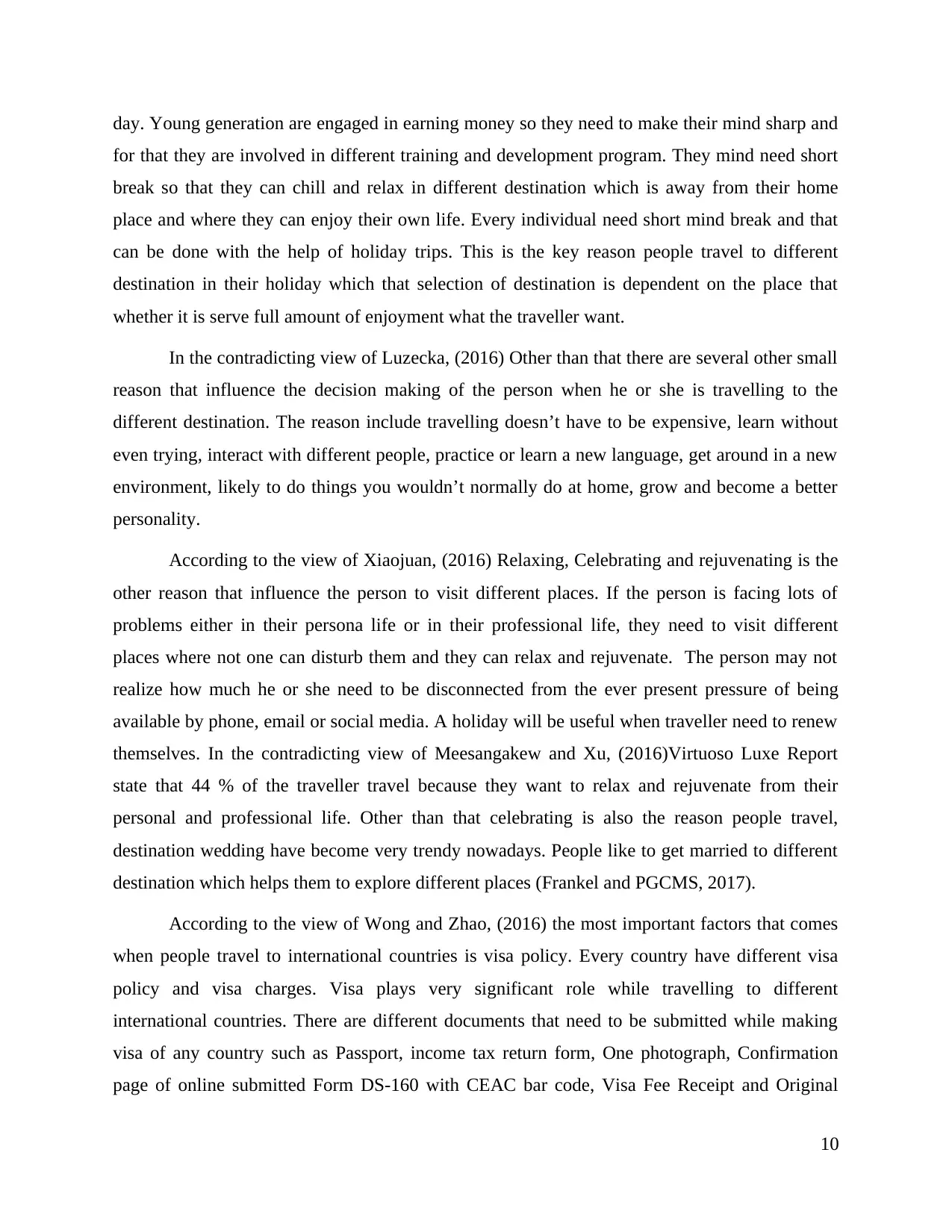
day. Young generation are engaged in earning money so they need to make their mind sharp and
for that they are involved in different training and development program. They mind need short
break so that they can chill and relax in different destination which is away from their home
place and where they can enjoy their own life. Every individual need short mind break and that
can be done with the help of holiday trips. This is the key reason people travel to different
destination in their holiday which that selection of destination is dependent on the place that
whether it is serve full amount of enjoyment what the traveller want.
In the contradicting view of Luzecka, (2016) Other than that there are several other small
reason that influence the decision making of the person when he or she is travelling to the
different destination. The reason include travelling doesn’t have to be expensive, learn without
even trying, interact with different people, practice or learn a new language, get around in a new
environment, likely to do things you wouldn’t normally do at home, grow and become a better
personality.
According to the view of Xiaojuan, (2016) Relaxing, Celebrating and rejuvenating is the
other reason that influence the person to visit different places. If the person is facing lots of
problems either in their persona life or in their professional life, they need to visit different
places where not one can disturb them and they can relax and rejuvenate. The person may not
realize how much he or she need to be disconnected from the ever present pressure of being
available by phone, email or social media. A holiday will be useful when traveller need to renew
themselves. In the contradicting view of Meesangakew and Xu, (2016)Virtuoso Luxe Report
state that 44 % of the traveller travel because they want to relax and rejuvenate from their
personal and professional life. Other than that celebrating is also the reason people travel,
destination wedding have become very trendy nowadays. People like to get married to different
destination which helps them to explore different places (Frankel and PGCMS, 2017).
According to the view of Wong and Zhao, (2016) the most important factors that comes
when people travel to international countries is visa policy. Every country have different visa
policy and visa charges. Visa plays very significant role while travelling to different
international countries. There are different documents that need to be submitted while making
visa of any country such as Passport, income tax return form, One photograph, Confirmation
page of online submitted Form DS-160 with CEAC bar code, Visa Fee Receipt and Original
10
for that they are involved in different training and development program. They mind need short
break so that they can chill and relax in different destination which is away from their home
place and where they can enjoy their own life. Every individual need short mind break and that
can be done with the help of holiday trips. This is the key reason people travel to different
destination in their holiday which that selection of destination is dependent on the place that
whether it is serve full amount of enjoyment what the traveller want.
In the contradicting view of Luzecka, (2016) Other than that there are several other small
reason that influence the decision making of the person when he or she is travelling to the
different destination. The reason include travelling doesn’t have to be expensive, learn without
even trying, interact with different people, practice or learn a new language, get around in a new
environment, likely to do things you wouldn’t normally do at home, grow and become a better
personality.
According to the view of Xiaojuan, (2016) Relaxing, Celebrating and rejuvenating is the
other reason that influence the person to visit different places. If the person is facing lots of
problems either in their persona life or in their professional life, they need to visit different
places where not one can disturb them and they can relax and rejuvenate. The person may not
realize how much he or she need to be disconnected from the ever present pressure of being
available by phone, email or social media. A holiday will be useful when traveller need to renew
themselves. In the contradicting view of Meesangakew and Xu, (2016)Virtuoso Luxe Report
state that 44 % of the traveller travel because they want to relax and rejuvenate from their
personal and professional life. Other than that celebrating is also the reason people travel,
destination wedding have become very trendy nowadays. People like to get married to different
destination which helps them to explore different places (Frankel and PGCMS, 2017).
According to the view of Wong and Zhao, (2016) the most important factors that comes
when people travel to international countries is visa policy. Every country have different visa
policy and visa charges. Visa plays very significant role while travelling to different
international countries. There are different documents that need to be submitted while making
visa of any country such as Passport, income tax return form, One photograph, Confirmation
page of online submitted Form DS-160 with CEAC bar code, Visa Fee Receipt and Original
10
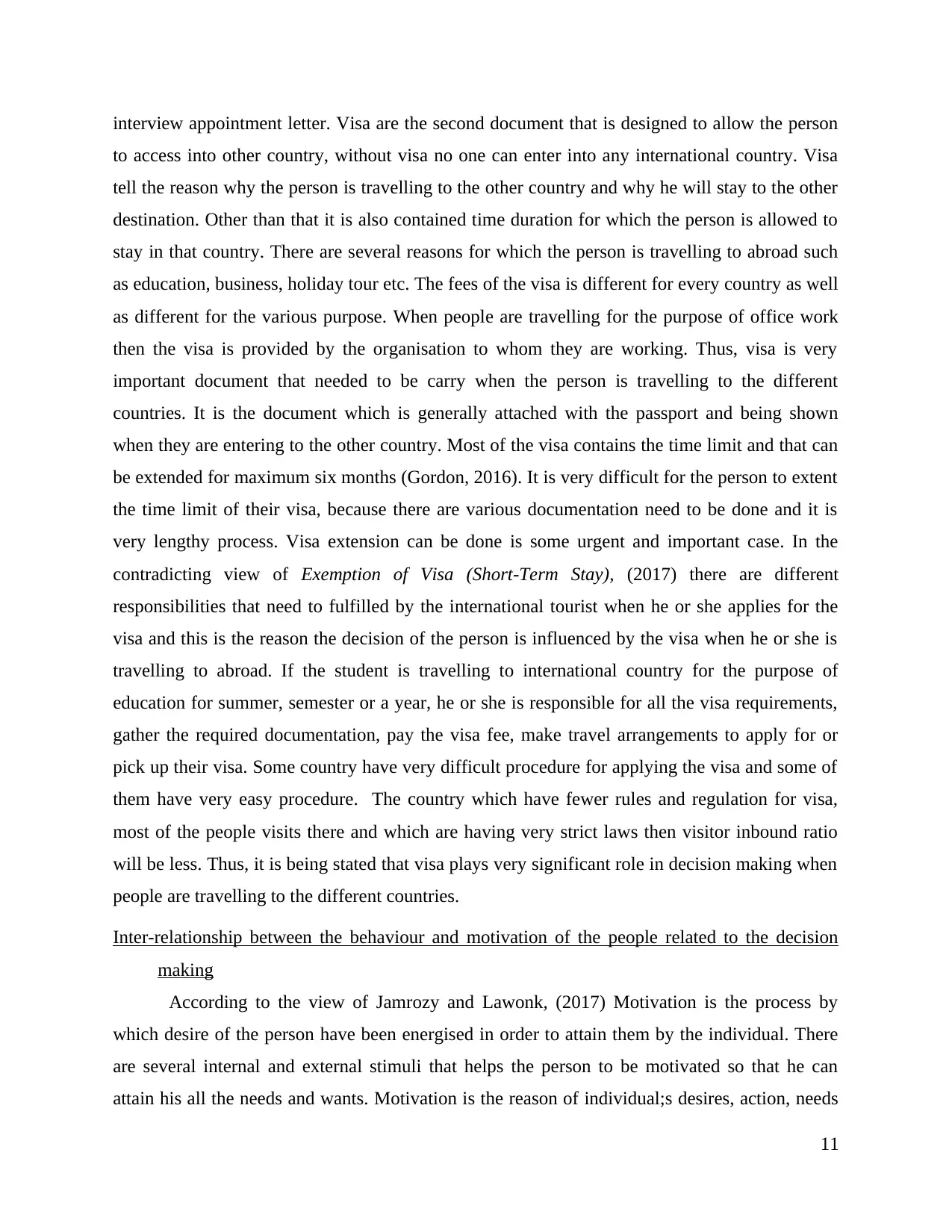
interview appointment letter. Visa are the second document that is designed to allow the person
to access into other country, without visa no one can enter into any international country. Visa
tell the reason why the person is travelling to the other country and why he will stay to the other
destination. Other than that it is also contained time duration for which the person is allowed to
stay in that country. There are several reasons for which the person is travelling to abroad such
as education, business, holiday tour etc. The fees of the visa is different for every country as well
as different for the various purpose. When people are travelling for the purpose of office work
then the visa is provided by the organisation to whom they are working. Thus, visa is very
important document that needed to be carry when the person is travelling to the different
countries. It is the document which is generally attached with the passport and being shown
when they are entering to the other country. Most of the visa contains the time limit and that can
be extended for maximum six months (Gordon, 2016). It is very difficult for the person to extent
the time limit of their visa, because there are various documentation need to be done and it is
very lengthy process. Visa extension can be done is some urgent and important case. In the
contradicting view of Exemption of Visa (Short-Term Stay), (2017) there are different
responsibilities that need to fulfilled by the international tourist when he or she applies for the
visa and this is the reason the decision of the person is influenced by the visa when he or she is
travelling to abroad. If the student is travelling to international country for the purpose of
education for summer, semester or a year, he or she is responsible for all the visa requirements,
gather the required documentation, pay the visa fee, make travel arrangements to apply for or
pick up their visa. Some country have very difficult procedure for applying the visa and some of
them have very easy procedure. The country which have fewer rules and regulation for visa,
most of the people visits there and which are having very strict laws then visitor inbound ratio
will be less. Thus, it is being stated that visa plays very significant role in decision making when
people are travelling to the different countries.
Inter-relationship between the behaviour and motivation of the people related to the decision
making
According to the view of Jamrozy and Lawonk, (2017) Motivation is the process by
which desire of the person have been energised in order to attain them by the individual. There
are several internal and external stimuli that helps the person to be motivated so that he can
attain his all the needs and wants. Motivation is the reason of individual;s desires, action, needs
11
to access into other country, without visa no one can enter into any international country. Visa
tell the reason why the person is travelling to the other country and why he will stay to the other
destination. Other than that it is also contained time duration for which the person is allowed to
stay in that country. There are several reasons for which the person is travelling to abroad such
as education, business, holiday tour etc. The fees of the visa is different for every country as well
as different for the various purpose. When people are travelling for the purpose of office work
then the visa is provided by the organisation to whom they are working. Thus, visa is very
important document that needed to be carry when the person is travelling to the different
countries. It is the document which is generally attached with the passport and being shown
when they are entering to the other country. Most of the visa contains the time limit and that can
be extended for maximum six months (Gordon, 2016). It is very difficult for the person to extent
the time limit of their visa, because there are various documentation need to be done and it is
very lengthy process. Visa extension can be done is some urgent and important case. In the
contradicting view of Exemption of Visa (Short-Term Stay), (2017) there are different
responsibilities that need to fulfilled by the international tourist when he or she applies for the
visa and this is the reason the decision of the person is influenced by the visa when he or she is
travelling to abroad. If the student is travelling to international country for the purpose of
education for summer, semester or a year, he or she is responsible for all the visa requirements,
gather the required documentation, pay the visa fee, make travel arrangements to apply for or
pick up their visa. Some country have very difficult procedure for applying the visa and some of
them have very easy procedure. The country which have fewer rules and regulation for visa,
most of the people visits there and which are having very strict laws then visitor inbound ratio
will be less. Thus, it is being stated that visa plays very significant role in decision making when
people are travelling to the different countries.
Inter-relationship between the behaviour and motivation of the people related to the decision
making
According to the view of Jamrozy and Lawonk, (2017) Motivation is the process by
which desire of the person have been energised in order to attain them by the individual. There
are several internal and external stimuli that helps the person to be motivated so that he can
attain his all the needs and wants. Motivation is the reason of individual;s desires, action, needs
11
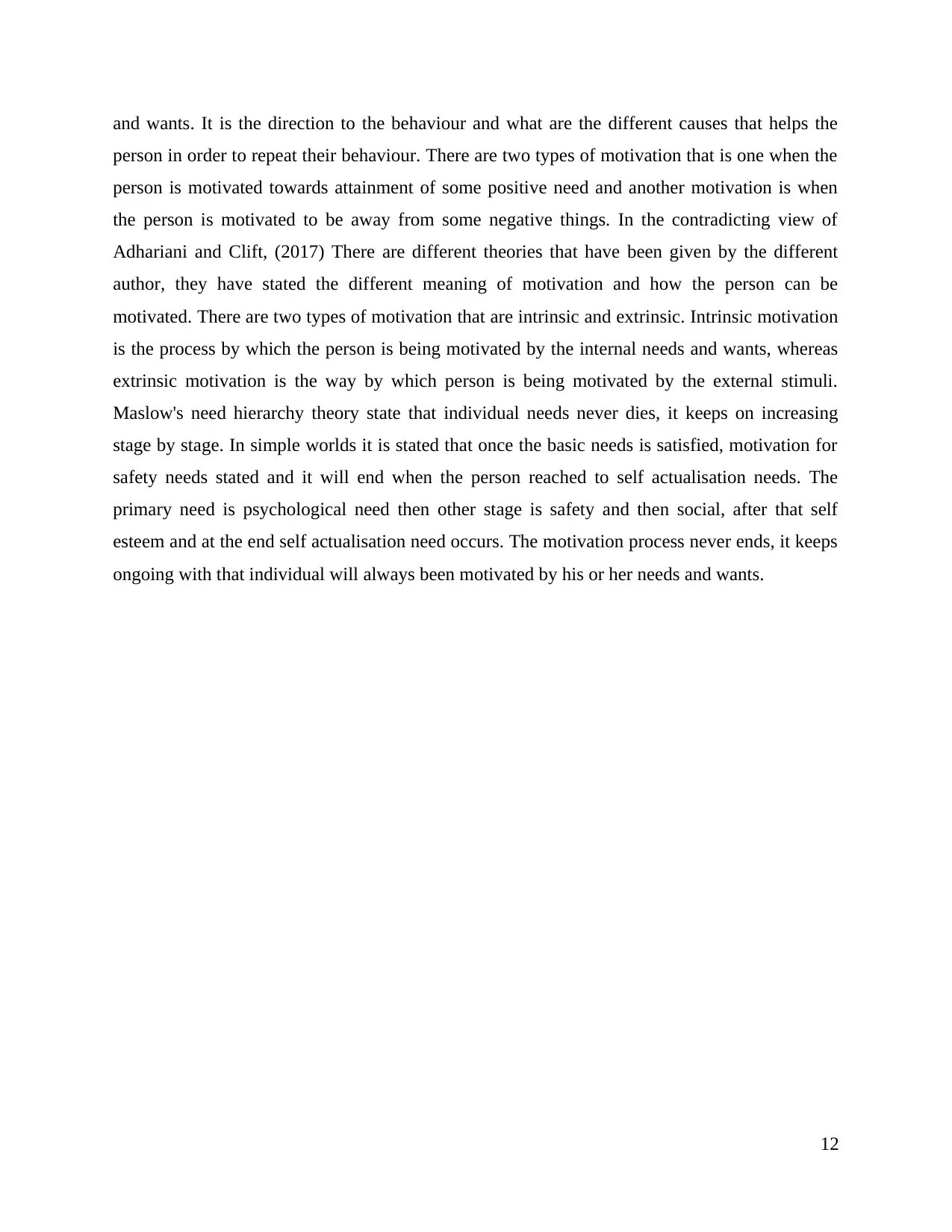
and wants. It is the direction to the behaviour and what are the different causes that helps the
person in order to repeat their behaviour. There are two types of motivation that is one when the
person is motivated towards attainment of some positive need and another motivation is when
the person is motivated to be away from some negative things. In the contradicting view of
Adhariani and Clift, (2017) There are different theories that have been given by the different
author, they have stated the different meaning of motivation and how the person can be
motivated. There are two types of motivation that are intrinsic and extrinsic. Intrinsic motivation
is the process by which the person is being motivated by the internal needs and wants, whereas
extrinsic motivation is the way by which person is being motivated by the external stimuli.
Maslow's need hierarchy theory state that individual needs never dies, it keeps on increasing
stage by stage. In simple worlds it is stated that once the basic needs is satisfied, motivation for
safety needs stated and it will end when the person reached to self actualisation needs. The
primary need is psychological need then other stage is safety and then social, after that self
esteem and at the end self actualisation need occurs. The motivation process never ends, it keeps
ongoing with that individual will always been motivated by his or her needs and wants.
12
person in order to repeat their behaviour. There are two types of motivation that is one when the
person is motivated towards attainment of some positive need and another motivation is when
the person is motivated to be away from some negative things. In the contradicting view of
Adhariani and Clift, (2017) There are different theories that have been given by the different
author, they have stated the different meaning of motivation and how the person can be
motivated. There are two types of motivation that are intrinsic and extrinsic. Intrinsic motivation
is the process by which the person is being motivated by the internal needs and wants, whereas
extrinsic motivation is the way by which person is being motivated by the external stimuli.
Maslow's need hierarchy theory state that individual needs never dies, it keeps on increasing
stage by stage. In simple worlds it is stated that once the basic needs is satisfied, motivation for
safety needs stated and it will end when the person reached to self actualisation needs. The
primary need is psychological need then other stage is safety and then social, after that self
esteem and at the end self actualisation need occurs. The motivation process never ends, it keeps
ongoing with that individual will always been motivated by his or her needs and wants.
12
Secure Best Marks with AI Grader
Need help grading? Try our AI Grader for instant feedback on your assignments.
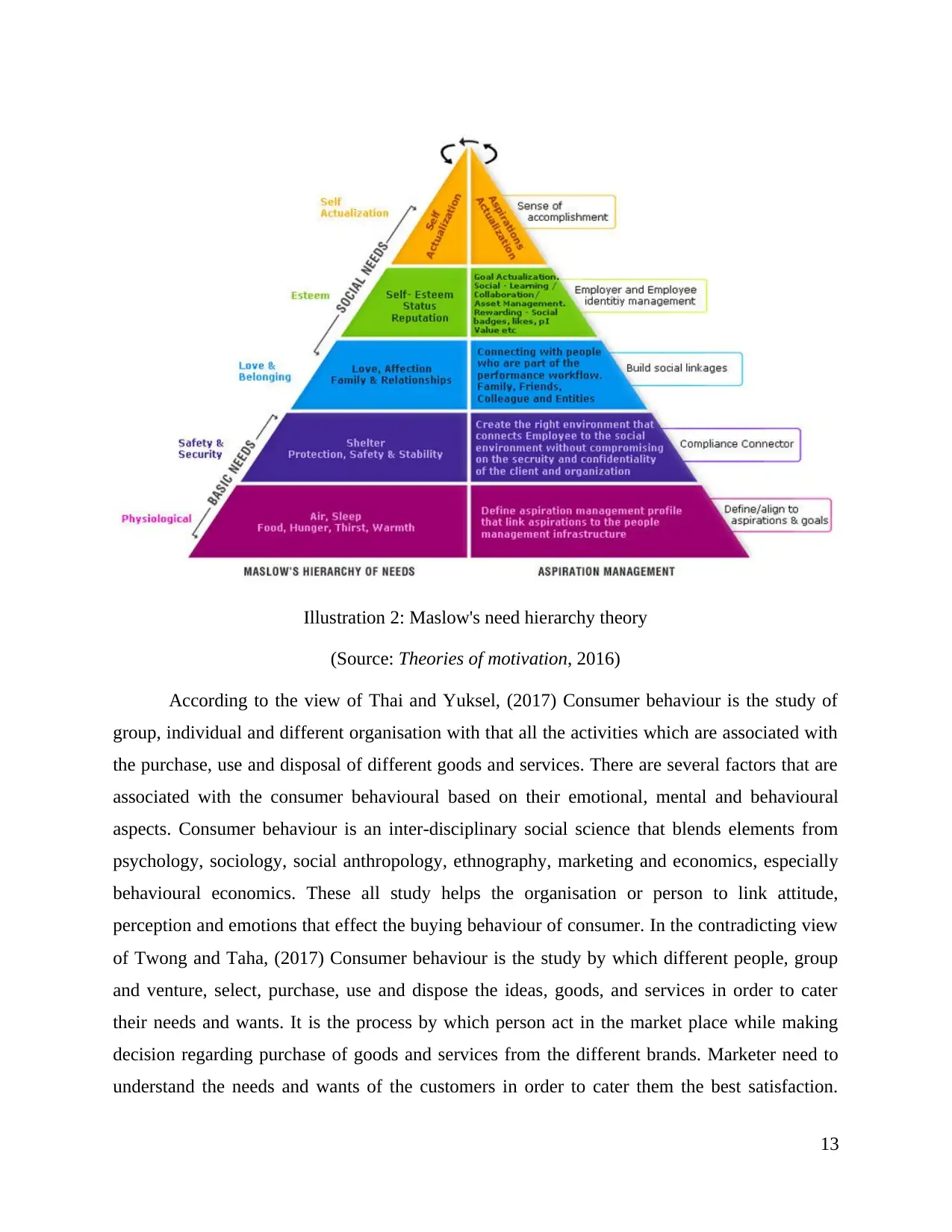
Illustration 2: Maslow's need hierarchy theory
(Source: Theories of motivation, 2016)
According to the view of Thai and Yuksel, (2017) Consumer behaviour is the study of
group, individual and different organisation with that all the activities which are associated with
the purchase, use and disposal of different goods and services. There are several factors that are
associated with the consumer behavioural based on their emotional, mental and behavioural
aspects. Consumer behaviour is an inter-disciplinary social science that blends elements from
psychology, sociology, social anthropology, ethnography, marketing and economics, especially
behavioural economics. These all study helps the organisation or person to link attitude,
perception and emotions that effect the buying behaviour of consumer. In the contradicting view
of Twong and Taha, (2017) Consumer behaviour is the study by which different people, group
and venture, select, purchase, use and dispose the ideas, goods, and services in order to cater
their needs and wants. It is the process by which person act in the market place while making
decision regarding purchase of goods and services from the different brands. Marketer need to
understand the needs and wants of the customers in order to cater them the best satisfaction.
13
(Source: Theories of motivation, 2016)
According to the view of Thai and Yuksel, (2017) Consumer behaviour is the study of
group, individual and different organisation with that all the activities which are associated with
the purchase, use and disposal of different goods and services. There are several factors that are
associated with the consumer behavioural based on their emotional, mental and behavioural
aspects. Consumer behaviour is an inter-disciplinary social science that blends elements from
psychology, sociology, social anthropology, ethnography, marketing and economics, especially
behavioural economics. These all study helps the organisation or person to link attitude,
perception and emotions that effect the buying behaviour of consumer. In the contradicting view
of Twong and Taha, (2017) Consumer behaviour is the study by which different people, group
and venture, select, purchase, use and dispose the ideas, goods, and services in order to cater
their needs and wants. It is the process by which person act in the market place while making
decision regarding purchase of goods and services from the different brands. Marketer need to
understand the needs and wants of the customers in order to cater them the best satisfaction.
13
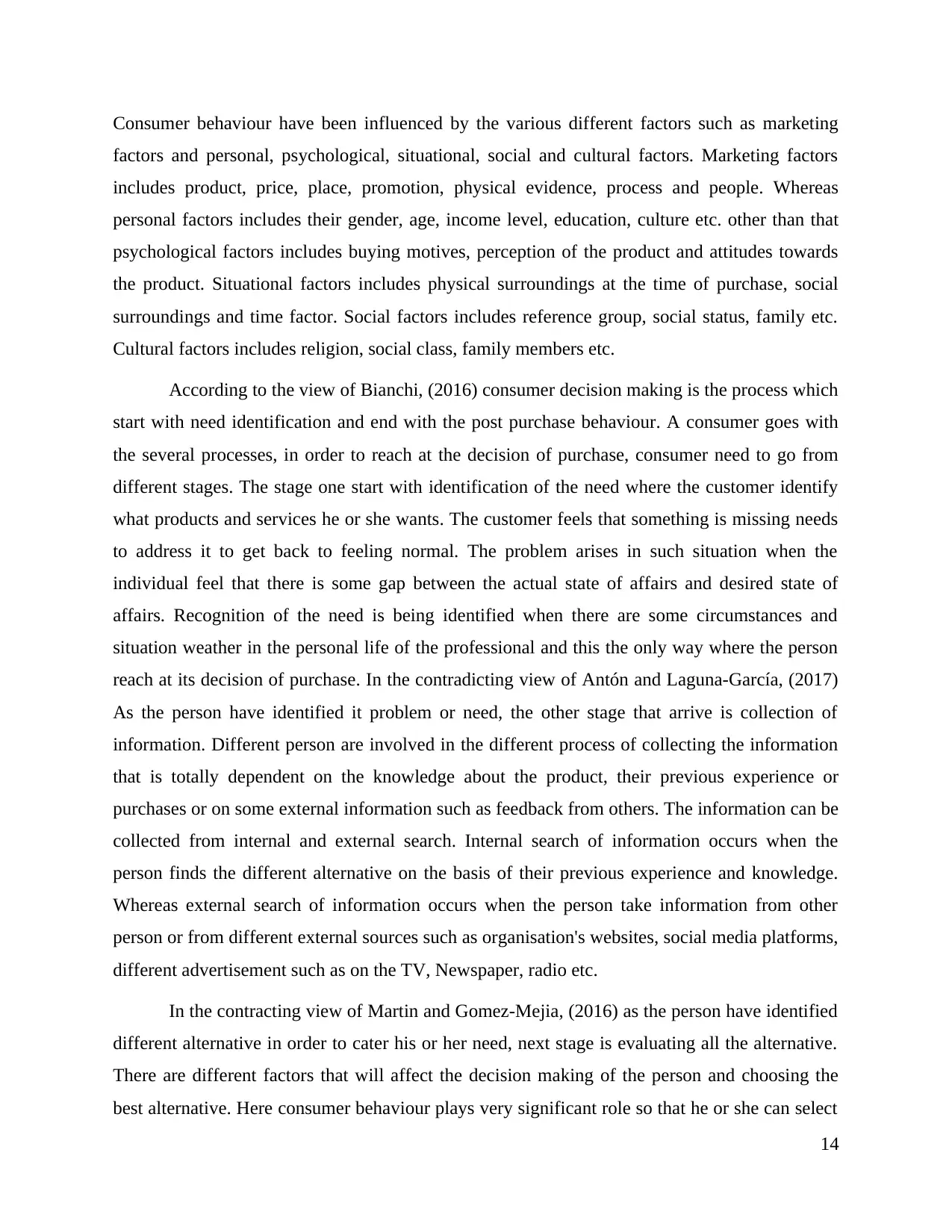
Consumer behaviour have been influenced by the various different factors such as marketing
factors and personal, psychological, situational, social and cultural factors. Marketing factors
includes product, price, place, promotion, physical evidence, process and people. Whereas
personal factors includes their gender, age, income level, education, culture etc. other than that
psychological factors includes buying motives, perception of the product and attitudes towards
the product. Situational factors includes physical surroundings at the time of purchase, social
surroundings and time factor. Social factors includes reference group, social status, family etc.
Cultural factors includes religion, social class, family members etc.
According to the view of Bianchi, (2016) consumer decision making is the process which
start with need identification and end with the post purchase behaviour. A consumer goes with
the several processes, in order to reach at the decision of purchase, consumer need to go from
different stages. The stage one start with identification of the need where the customer identify
what products and services he or she wants. The customer feels that something is missing needs
to address it to get back to feeling normal. The problem arises in such situation when the
individual feel that there is some gap between the actual state of affairs and desired state of
affairs. Recognition of the need is being identified when there are some circumstances and
situation weather in the personal life of the professional and this the only way where the person
reach at its decision of purchase. In the contradicting view of Antón and Laguna-García, (2017)
As the person have identified it problem or need, the other stage that arrive is collection of
information. Different person are involved in the different process of collecting the information
that is totally dependent on the knowledge about the product, their previous experience or
purchases or on some external information such as feedback from others. The information can be
collected from internal and external search. Internal search of information occurs when the
person finds the different alternative on the basis of their previous experience and knowledge.
Whereas external search of information occurs when the person take information from other
person or from different external sources such as organisation's websites, social media platforms,
different advertisement such as on the TV, Newspaper, radio etc.
In the contracting view of Martin and Gomez-Mejia, (2016) as the person have identified
different alternative in order to cater his or her need, next stage is evaluating all the alternative.
There are different factors that will affect the decision making of the person and choosing the
best alternative. Here consumer behaviour plays very significant role so that he or she can select
14
factors and personal, psychological, situational, social and cultural factors. Marketing factors
includes product, price, place, promotion, physical evidence, process and people. Whereas
personal factors includes their gender, age, income level, education, culture etc. other than that
psychological factors includes buying motives, perception of the product and attitudes towards
the product. Situational factors includes physical surroundings at the time of purchase, social
surroundings and time factor. Social factors includes reference group, social status, family etc.
Cultural factors includes religion, social class, family members etc.
According to the view of Bianchi, (2016) consumer decision making is the process which
start with need identification and end with the post purchase behaviour. A consumer goes with
the several processes, in order to reach at the decision of purchase, consumer need to go from
different stages. The stage one start with identification of the need where the customer identify
what products and services he or she wants. The customer feels that something is missing needs
to address it to get back to feeling normal. The problem arises in such situation when the
individual feel that there is some gap between the actual state of affairs and desired state of
affairs. Recognition of the need is being identified when there are some circumstances and
situation weather in the personal life of the professional and this the only way where the person
reach at its decision of purchase. In the contradicting view of Antón and Laguna-García, (2017)
As the person have identified it problem or need, the other stage that arrive is collection of
information. Different person are involved in the different process of collecting the information
that is totally dependent on the knowledge about the product, their previous experience or
purchases or on some external information such as feedback from others. The information can be
collected from internal and external search. Internal search of information occurs when the
person finds the different alternative on the basis of their previous experience and knowledge.
Whereas external search of information occurs when the person take information from other
person or from different external sources such as organisation's websites, social media platforms,
different advertisement such as on the TV, Newspaper, radio etc.
In the contracting view of Martin and Gomez-Mejia, (2016) as the person have identified
different alternative in order to cater his or her need, next stage is evaluating all the alternative.
There are different factors that will affect the decision making of the person and choosing the
best alternative. Here consumer behaviour plays very significant role so that he or she can select
14
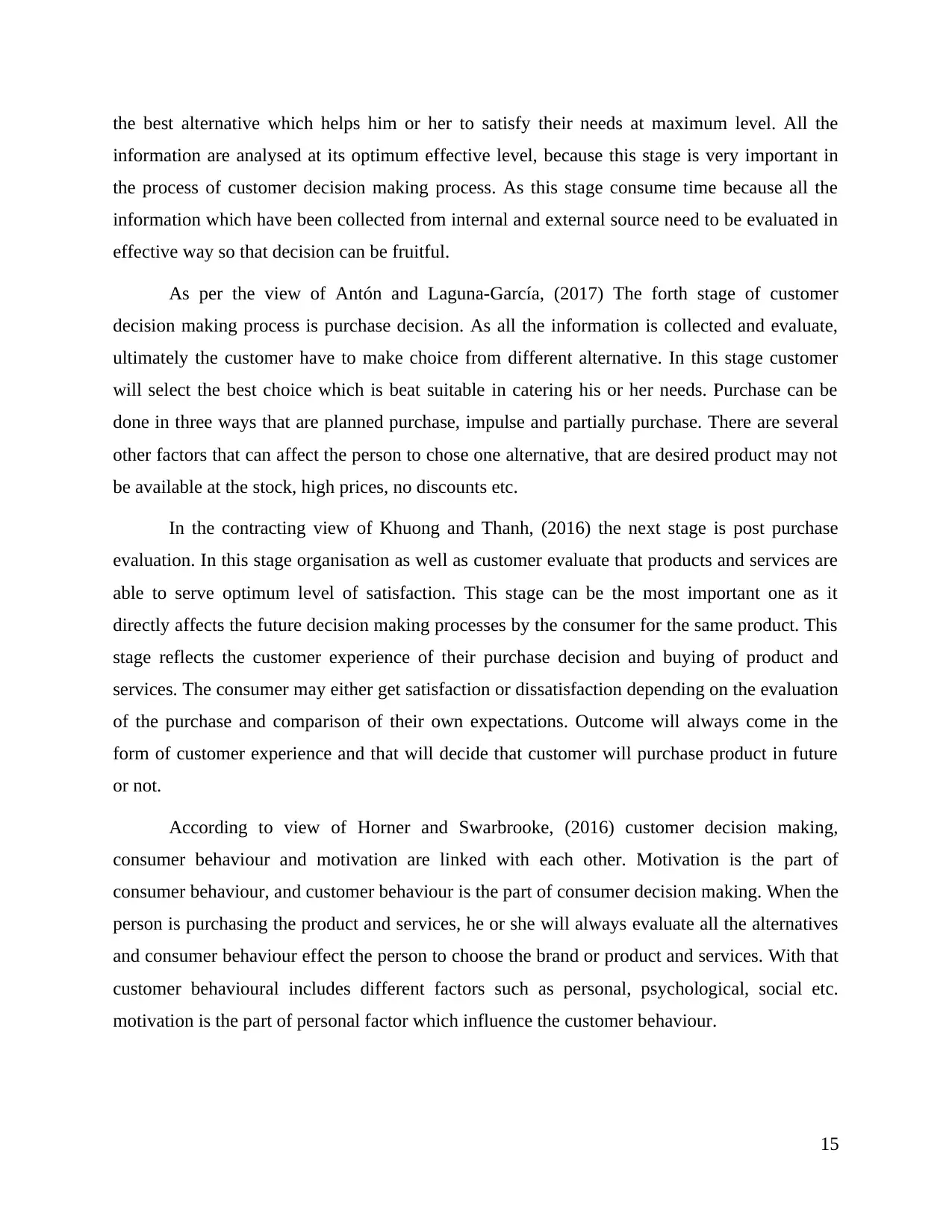
the best alternative which helps him or her to satisfy their needs at maximum level. All the
information are analysed at its optimum effective level, because this stage is very important in
the process of customer decision making process. As this stage consume time because all the
information which have been collected from internal and external source need to be evaluated in
effective way so that decision can be fruitful.
As per the view of Antón and Laguna-García, (2017) The forth stage of customer
decision making process is purchase decision. As all the information is collected and evaluate,
ultimately the customer have to make choice from different alternative. In this stage customer
will select the best choice which is beat suitable in catering his or her needs. Purchase can be
done in three ways that are planned purchase, impulse and partially purchase. There are several
other factors that can affect the person to chose one alternative, that are desired product may not
be available at the stock, high prices, no discounts etc.
In the contracting view of Khuong and Thanh, (2016) the next stage is post purchase
evaluation. In this stage organisation as well as customer evaluate that products and services are
able to serve optimum level of satisfaction. This stage can be the most important one as it
directly affects the future decision making processes by the consumer for the same product. This
stage reflects the customer experience of their purchase decision and buying of product and
services. The consumer may either get satisfaction or dissatisfaction depending on the evaluation
of the purchase and comparison of their own expectations. Outcome will always come in the
form of customer experience and that will decide that customer will purchase product in future
or not.
According to view of Horner and Swarbrooke, (2016) customer decision making,
consumer behaviour and motivation are linked with each other. Motivation is the part of
consumer behaviour, and customer behaviour is the part of consumer decision making. When the
person is purchasing the product and services, he or she will always evaluate all the alternatives
and consumer behaviour effect the person to choose the brand or product and services. With that
customer behavioural includes different factors such as personal, psychological, social etc.
motivation is the part of personal factor which influence the customer behaviour.
15
information are analysed at its optimum effective level, because this stage is very important in
the process of customer decision making process. As this stage consume time because all the
information which have been collected from internal and external source need to be evaluated in
effective way so that decision can be fruitful.
As per the view of Antón and Laguna-García, (2017) The forth stage of customer
decision making process is purchase decision. As all the information is collected and evaluate,
ultimately the customer have to make choice from different alternative. In this stage customer
will select the best choice which is beat suitable in catering his or her needs. Purchase can be
done in three ways that are planned purchase, impulse and partially purchase. There are several
other factors that can affect the person to chose one alternative, that are desired product may not
be available at the stock, high prices, no discounts etc.
In the contracting view of Khuong and Thanh, (2016) the next stage is post purchase
evaluation. In this stage organisation as well as customer evaluate that products and services are
able to serve optimum level of satisfaction. This stage can be the most important one as it
directly affects the future decision making processes by the consumer for the same product. This
stage reflects the customer experience of their purchase decision and buying of product and
services. The consumer may either get satisfaction or dissatisfaction depending on the evaluation
of the purchase and comparison of their own expectations. Outcome will always come in the
form of customer experience and that will decide that customer will purchase product in future
or not.
According to view of Horner and Swarbrooke, (2016) customer decision making,
consumer behaviour and motivation are linked with each other. Motivation is the part of
consumer behaviour, and customer behaviour is the part of consumer decision making. When the
person is purchasing the product and services, he or she will always evaluate all the alternatives
and consumer behaviour effect the person to choose the brand or product and services. With that
customer behavioural includes different factors such as personal, psychological, social etc.
motivation is the part of personal factor which influence the customer behaviour.
15
Paraphrase This Document
Need a fresh take? Get an instant paraphrase of this document with our AI Paraphraser
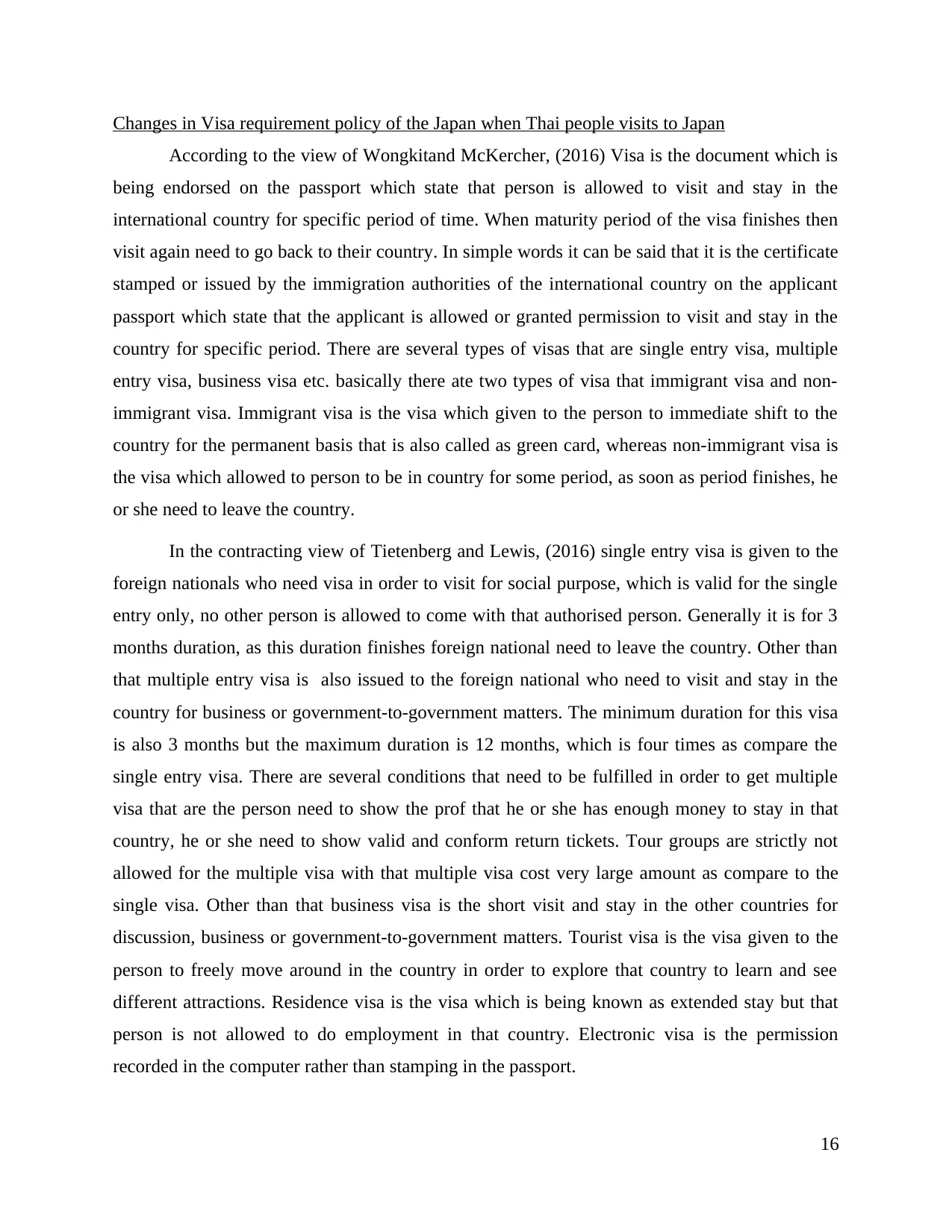
Changes in Visa requirement policy of the Japan when Thai people visits to Japan
According to the view of Wongkitand McKercher, (2016) Visa is the document which is
being endorsed on the passport which state that person is allowed to visit and stay in the
international country for specific period of time. When maturity period of the visa finishes then
visit again need to go back to their country. In simple words it can be said that it is the certificate
stamped or issued by the immigration authorities of the international country on the applicant
passport which state that the applicant is allowed or granted permission to visit and stay in the
country for specific period. There are several types of visas that are single entry visa, multiple
entry visa, business visa etc. basically there ate two types of visa that immigrant visa and non-
immigrant visa. Immigrant visa is the visa which given to the person to immediate shift to the
country for the permanent basis that is also called as green card, whereas non-immigrant visa is
the visa which allowed to person to be in country for some period, as soon as period finishes, he
or she need to leave the country.
In the contracting view of Tietenberg and Lewis, (2016) single entry visa is given to the
foreign nationals who need visa in order to visit for social purpose, which is valid for the single
entry only, no other person is allowed to come with that authorised person. Generally it is for 3
months duration, as this duration finishes foreign national need to leave the country. Other than
that multiple entry visa is also issued to the foreign national who need to visit and stay in the
country for business or government-to-government matters. The minimum duration for this visa
is also 3 months but the maximum duration is 12 months, which is four times as compare the
single entry visa. There are several conditions that need to be fulfilled in order to get multiple
visa that are the person need to show the prof that he or she has enough money to stay in that
country, he or she need to show valid and conform return tickets. Tour groups are strictly not
allowed for the multiple visa with that multiple visa cost very large amount as compare to the
single visa. Other than that business visa is the short visit and stay in the other countries for
discussion, business or government-to-government matters. Tourist visa is the visa given to the
person to freely move around in the country in order to explore that country to learn and see
different attractions. Residence visa is the visa which is being known as extended stay but that
person is not allowed to do employment in that country. Electronic visa is the permission
recorded in the computer rather than stamping in the passport.
16
According to the view of Wongkitand McKercher, (2016) Visa is the document which is
being endorsed on the passport which state that person is allowed to visit and stay in the
international country for specific period of time. When maturity period of the visa finishes then
visit again need to go back to their country. In simple words it can be said that it is the certificate
stamped or issued by the immigration authorities of the international country on the applicant
passport which state that the applicant is allowed or granted permission to visit and stay in the
country for specific period. There are several types of visas that are single entry visa, multiple
entry visa, business visa etc. basically there ate two types of visa that immigrant visa and non-
immigrant visa. Immigrant visa is the visa which given to the person to immediate shift to the
country for the permanent basis that is also called as green card, whereas non-immigrant visa is
the visa which allowed to person to be in country for some period, as soon as period finishes, he
or she need to leave the country.
In the contracting view of Tietenberg and Lewis, (2016) single entry visa is given to the
foreign nationals who need visa in order to visit for social purpose, which is valid for the single
entry only, no other person is allowed to come with that authorised person. Generally it is for 3
months duration, as this duration finishes foreign national need to leave the country. Other than
that multiple entry visa is also issued to the foreign national who need to visit and stay in the
country for business or government-to-government matters. The minimum duration for this visa
is also 3 months but the maximum duration is 12 months, which is four times as compare the
single entry visa. There are several conditions that need to be fulfilled in order to get multiple
visa that are the person need to show the prof that he or she has enough money to stay in that
country, he or she need to show valid and conform return tickets. Tour groups are strictly not
allowed for the multiple visa with that multiple visa cost very large amount as compare to the
single visa. Other than that business visa is the short visit and stay in the other countries for
discussion, business or government-to-government matters. Tourist visa is the visa given to the
person to freely move around in the country in order to explore that country to learn and see
different attractions. Residence visa is the visa which is being known as extended stay but that
person is not allowed to do employment in that country. Electronic visa is the permission
recorded in the computer rather than stamping in the passport.
16
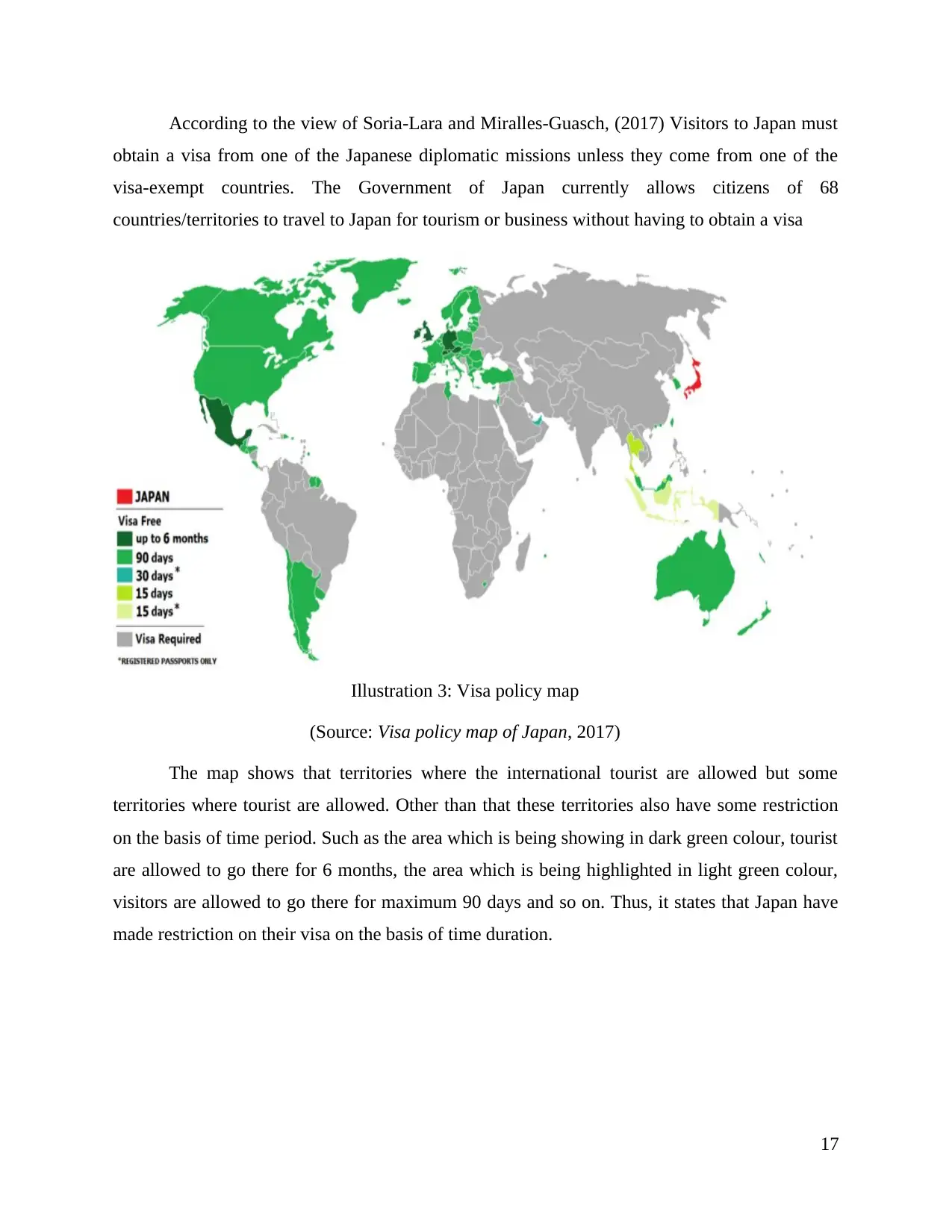
According to the view of Soria-Lara and Miralles-Guasch, (2017) Visitors to Japan must
obtain a visa from one of the Japanese diplomatic missions unless they come from one of the
visa-exempt countries. The Government of Japan currently allows citizens of 68
countries/territories to travel to Japan for tourism or business without having to obtain a visa
Illustration 3: Visa policy map
(Source: Visa policy map of Japan, 2017)
The map shows that territories where the international tourist are allowed but some
territories where tourist are allowed. Other than that these territories also have some restriction
on the basis of time period. Such as the area which is being showing in dark green colour, tourist
are allowed to go there for 6 months, the area which is being highlighted in light green colour,
visitors are allowed to go there for maximum 90 days and so on. Thus, it states that Japan have
made restriction on their visa on the basis of time duration.
17
obtain a visa from one of the Japanese diplomatic missions unless they come from one of the
visa-exempt countries. The Government of Japan currently allows citizens of 68
countries/territories to travel to Japan for tourism or business without having to obtain a visa
Illustration 3: Visa policy map
(Source: Visa policy map of Japan, 2017)
The map shows that territories where the international tourist are allowed but some
territories where tourist are allowed. Other than that these territories also have some restriction
on the basis of time period. Such as the area which is being showing in dark green colour, tourist
are allowed to go there for 6 months, the area which is being highlighted in light green colour,
visitors are allowed to go there for maximum 90 days and so on. Thus, it states that Japan have
made restriction on their visa on the basis of time duration.
17
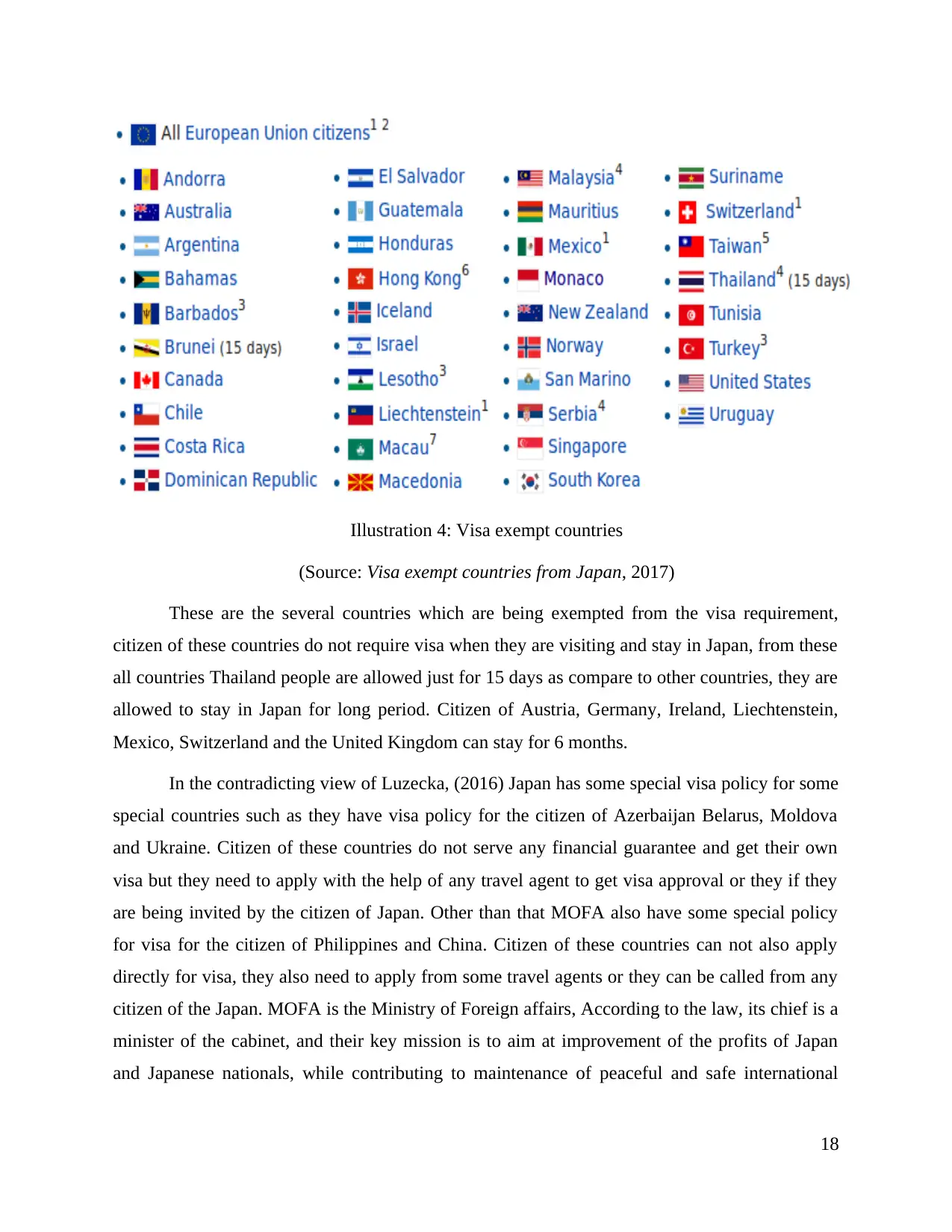
Illustration 4: Visa exempt countries
(Source: Visa exempt countries from Japan, 2017)
These are the several countries which are being exempted from the visa requirement,
citizen of these countries do not require visa when they are visiting and stay in Japan, from these
all countries Thailand people are allowed just for 15 days as compare to other countries, they are
allowed to stay in Japan for long period. Citizen of Austria, Germany, Ireland, Liechtenstein,
Mexico, Switzerland and the United Kingdom can stay for 6 months.
In the contradicting view of Luzecka, (2016) Japan has some special visa policy for some
special countries such as they have visa policy for the citizen of Azerbaijan Belarus, Moldova
and Ukraine. Citizen of these countries do not serve any financial guarantee and get their own
visa but they need to apply with the help of any travel agent to get visa approval or they if they
are being invited by the citizen of Japan. Other than that MOFA also have some special policy
for visa for the citizen of Philippines and China. Citizen of these countries can not also apply
directly for visa, they also need to apply from some travel agents or they can be called from any
citizen of the Japan. MOFA is the Ministry of Foreign affairs, According to the law, its chief is a
minister of the cabinet, and their key mission is to aim at improvement of the profits of Japan
and Japanese nationals, while contributing to maintenance of peaceful and safe international
18
(Source: Visa exempt countries from Japan, 2017)
These are the several countries which are being exempted from the visa requirement,
citizen of these countries do not require visa when they are visiting and stay in Japan, from these
all countries Thailand people are allowed just for 15 days as compare to other countries, they are
allowed to stay in Japan for long period. Citizen of Austria, Germany, Ireland, Liechtenstein,
Mexico, Switzerland and the United Kingdom can stay for 6 months.
In the contradicting view of Luzecka, (2016) Japan has some special visa policy for some
special countries such as they have visa policy for the citizen of Azerbaijan Belarus, Moldova
and Ukraine. Citizen of these countries do not serve any financial guarantee and get their own
visa but they need to apply with the help of any travel agent to get visa approval or they if they
are being invited by the citizen of Japan. Other than that MOFA also have some special policy
for visa for the citizen of Philippines and China. Citizen of these countries can not also apply
directly for visa, they also need to apply from some travel agents or they can be called from any
citizen of the Japan. MOFA is the Ministry of Foreign affairs, According to the law, its chief is a
minister of the cabinet, and their key mission is to aim at improvement of the profits of Japan
and Japanese nationals, while contributing to maintenance of peaceful and safe international
18
Secure Best Marks with AI Grader
Need help grading? Try our AI Grader for instant feedback on your assignments.
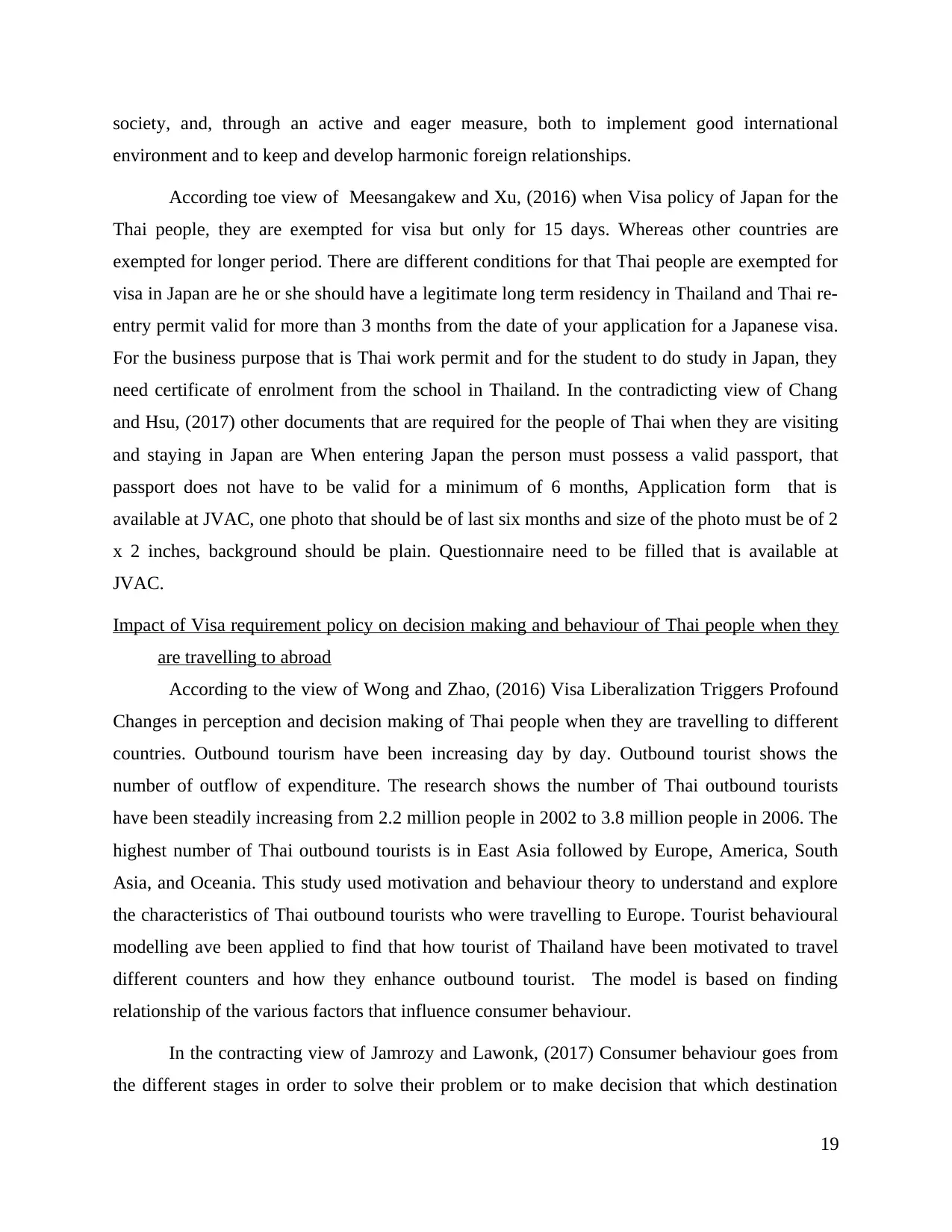
society, and, through an active and eager measure, both to implement good international
environment and to keep and develop harmonic foreign relationships.
According toe view of Meesangakew and Xu, (2016) when Visa policy of Japan for the
Thai people, they are exempted for visa but only for 15 days. Whereas other countries are
exempted for longer period. There are different conditions for that Thai people are exempted for
visa in Japan are he or she should have a legitimate long term residency in Thailand and Thai re-
entry permit valid for more than 3 months from the date of your application for a Japanese visa.
For the business purpose that is Thai work permit and for the student to do study in Japan, they
need certificate of enrolment from the school in Thailand. In the contradicting view of Chang
and Hsu, (2017) other documents that are required for the people of Thai when they are visiting
and staying in Japan are When entering Japan the person must possess a valid passport, that
passport does not have to be valid for a minimum of 6 months, Application form that is
available at JVAC, one photo that should be of last six months and size of the photo must be of 2
x 2 inches, background should be plain. Questionnaire need to be filled that is available at
JVAC.
Impact of Visa requirement policy on decision making and behaviour of Thai people when they
are travelling to abroad
According to the view of Wong and Zhao, (2016) Visa Liberalization Triggers Profound
Changes in perception and decision making of Thai people when they are travelling to different
countries. Outbound tourism have been increasing day by day. Outbound tourist shows the
number of outflow of expenditure. The research shows the number of Thai outbound tourists
have been steadily increasing from 2.2 million people in 2002 to 3.8 million people in 2006. The
highest number of Thai outbound tourists is in East Asia followed by Europe, America, South
Asia, and Oceania. This study used motivation and behaviour theory to understand and explore
the characteristics of Thai outbound tourists who were travelling to Europe. Tourist behavioural
modelling ave been applied to find that how tourist of Thailand have been motivated to travel
different counters and how they enhance outbound tourist. The model is based on finding
relationship of the various factors that influence consumer behaviour.
In the contracting view of Jamrozy and Lawonk, (2017) Consumer behaviour goes from
the different stages in order to solve their problem or to make decision that which destination
19
environment and to keep and develop harmonic foreign relationships.
According toe view of Meesangakew and Xu, (2016) when Visa policy of Japan for the
Thai people, they are exempted for visa but only for 15 days. Whereas other countries are
exempted for longer period. There are different conditions for that Thai people are exempted for
visa in Japan are he or she should have a legitimate long term residency in Thailand and Thai re-
entry permit valid for more than 3 months from the date of your application for a Japanese visa.
For the business purpose that is Thai work permit and for the student to do study in Japan, they
need certificate of enrolment from the school in Thailand. In the contradicting view of Chang
and Hsu, (2017) other documents that are required for the people of Thai when they are visiting
and staying in Japan are When entering Japan the person must possess a valid passport, that
passport does not have to be valid for a minimum of 6 months, Application form that is
available at JVAC, one photo that should be of last six months and size of the photo must be of 2
x 2 inches, background should be plain. Questionnaire need to be filled that is available at
JVAC.
Impact of Visa requirement policy on decision making and behaviour of Thai people when they
are travelling to abroad
According to the view of Wong and Zhao, (2016) Visa Liberalization Triggers Profound
Changes in perception and decision making of Thai people when they are travelling to different
countries. Outbound tourism have been increasing day by day. Outbound tourist shows the
number of outflow of expenditure. The research shows the number of Thai outbound tourists
have been steadily increasing from 2.2 million people in 2002 to 3.8 million people in 2006. The
highest number of Thai outbound tourists is in East Asia followed by Europe, America, South
Asia, and Oceania. This study used motivation and behaviour theory to understand and explore
the characteristics of Thai outbound tourists who were travelling to Europe. Tourist behavioural
modelling ave been applied to find that how tourist of Thailand have been motivated to travel
different counters and how they enhance outbound tourist. The model is based on finding
relationship of the various factors that influence consumer behaviour.
In the contracting view of Jamrozy and Lawonk, (2017) Consumer behaviour goes from
the different stages in order to solve their problem or to make decision that which destination
19
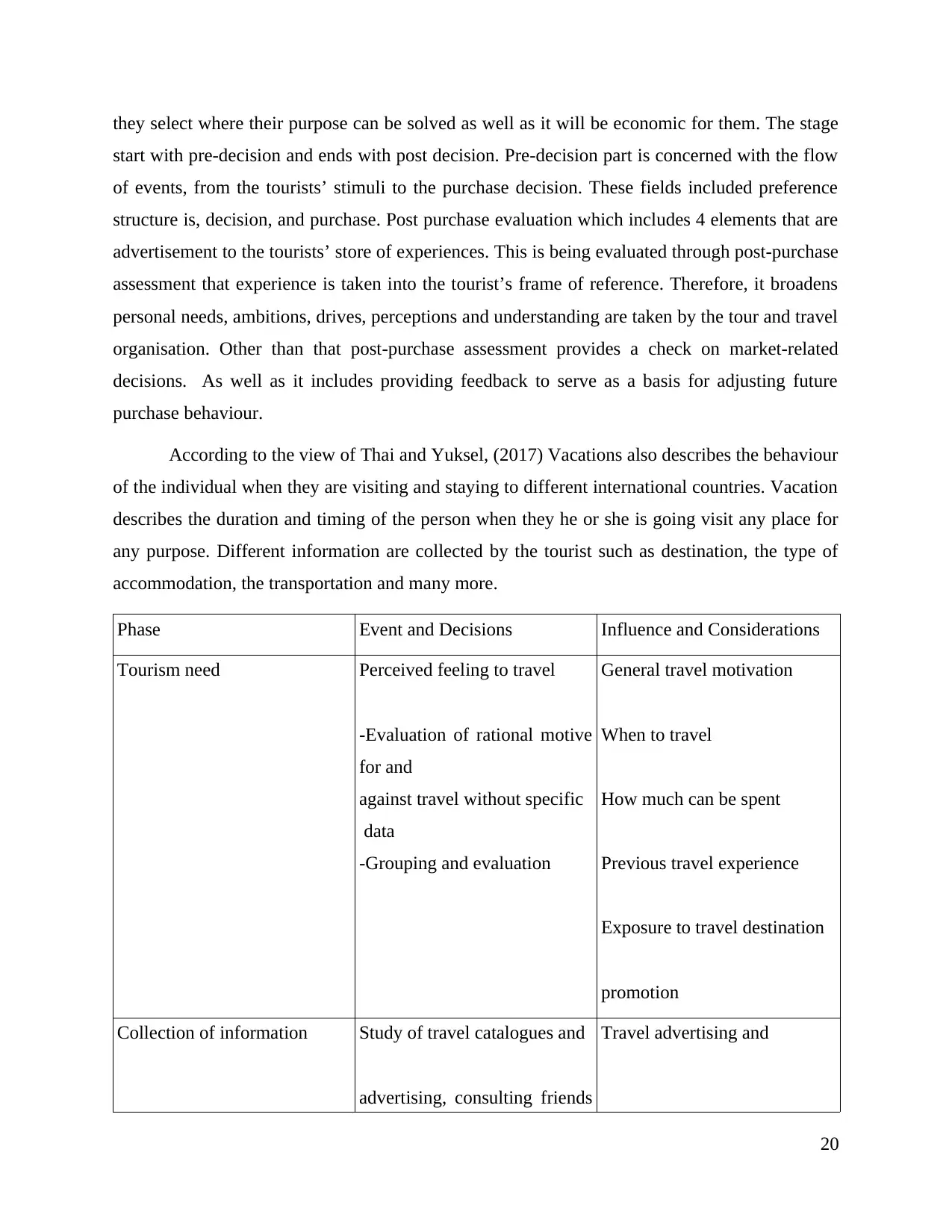
they select where their purpose can be solved as well as it will be economic for them. The stage
start with pre-decision and ends with post decision. Pre-decision part is concerned with the flow
of events, from the tourists’ stimuli to the purchase decision. These fields included preference
structure is, decision, and purchase. Post purchase evaluation which includes 4 elements that are
advertisement to the tourists’ store of experiences. This is being evaluated through post-purchase
assessment that experience is taken into the tourist’s frame of reference. Therefore, it broadens
personal needs, ambitions, drives, perceptions and understanding are taken by the tour and travel
organisation. Other than that post-purchase assessment provides a check on market-related
decisions. As well as it includes providing feedback to serve as a basis for adjusting future
purchase behaviour.
According to the view of Thai and Yuksel, (2017) Vacations also describes the behaviour
of the individual when they are visiting and staying to different international countries. Vacation
describes the duration and timing of the person when they he or she is going visit any place for
any purpose. Different information are collected by the tourist such as destination, the type of
accommodation, the transportation and many more.
Phase Event and Decisions Influence and Considerations
Tourism need Perceived feeling to travel
-Evaluation of rational motive
for and
against travel without specific
data
-Grouping and evaluation
General travel motivation
When to travel
How much can be spent
Previous travel experience
Exposure to travel destination
promotion
Collection of information Study of travel catalogues and
advertising, consulting friends
Travel advertising and
20
start with pre-decision and ends with post decision. Pre-decision part is concerned with the flow
of events, from the tourists’ stimuli to the purchase decision. These fields included preference
structure is, decision, and purchase. Post purchase evaluation which includes 4 elements that are
advertisement to the tourists’ store of experiences. This is being evaluated through post-purchase
assessment that experience is taken into the tourist’s frame of reference. Therefore, it broadens
personal needs, ambitions, drives, perceptions and understanding are taken by the tour and travel
organisation. Other than that post-purchase assessment provides a check on market-related
decisions. As well as it includes providing feedback to serve as a basis for adjusting future
purchase behaviour.
According to the view of Thai and Yuksel, (2017) Vacations also describes the behaviour
of the individual when they are visiting and staying to different international countries. Vacation
describes the duration and timing of the person when they he or she is going visit any place for
any purpose. Different information are collected by the tourist such as destination, the type of
accommodation, the transportation and many more.
Phase Event and Decisions Influence and Considerations
Tourism need Perceived feeling to travel
-Evaluation of rational motive
for and
against travel without specific
data
-Grouping and evaluation
General travel motivation
When to travel
How much can be spent
Previous travel experience
Exposure to travel destination
promotion
Collection of information Study of travel catalogues and
advertising, consulting friends
Travel advertising and
20
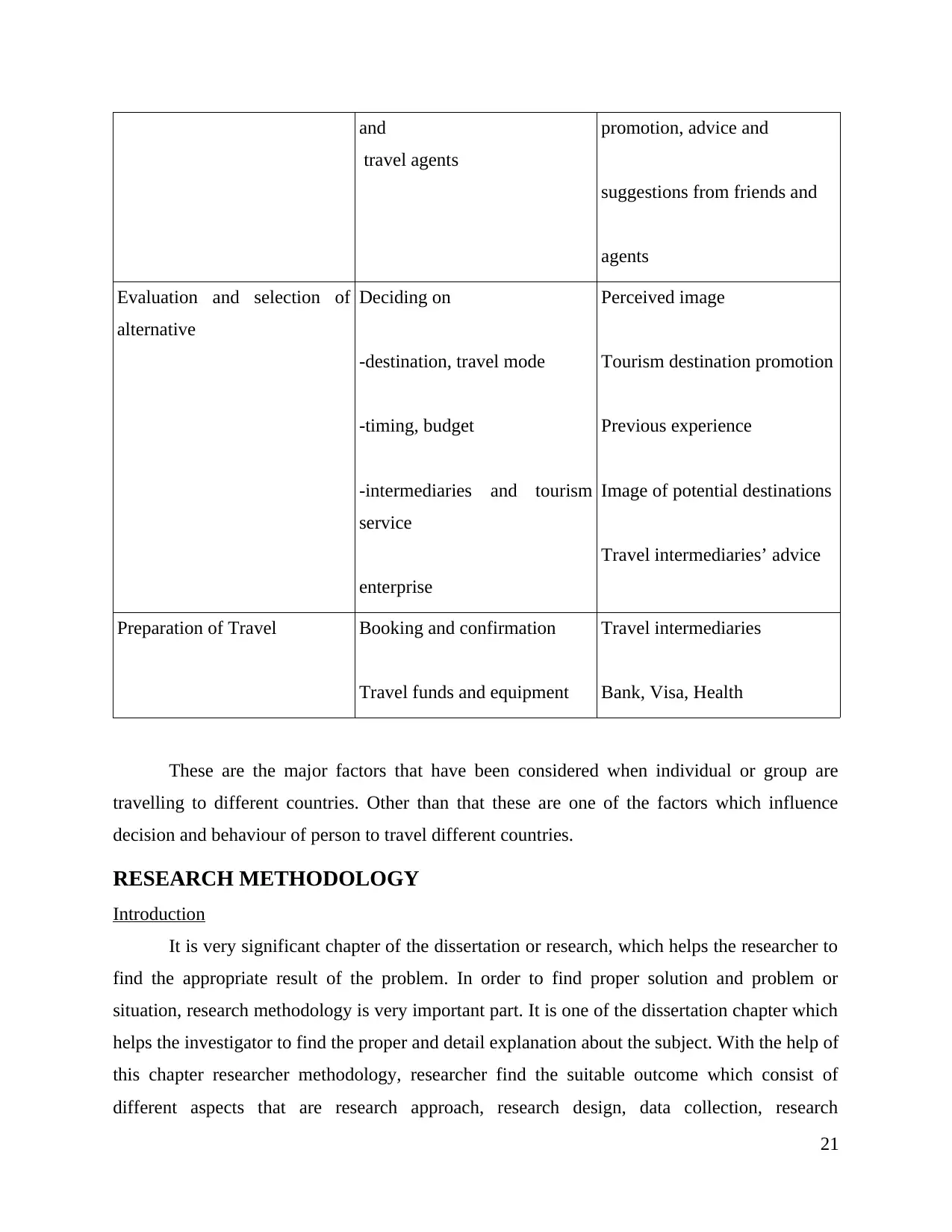
and
travel agents
promotion, advice and
suggestions from friends and
agents
Evaluation and selection of
alternative
Deciding on
-destination, travel mode
-timing, budget
-intermediaries and tourism
service
enterprise
Perceived image
Tourism destination promotion
Previous experience
Image of potential destinations
Travel intermediaries’ advice
Preparation of Travel Booking and confirmation
Travel funds and equipment
Travel intermediaries
Bank, Visa, Health
These are the major factors that have been considered when individual or group are
travelling to different countries. Other than that these are one of the factors which influence
decision and behaviour of person to travel different countries.
RESEARCH METHODOLOGY
Introduction
It is very significant chapter of the dissertation or research, which helps the researcher to
find the appropriate result of the problem. In order to find proper solution and problem or
situation, research methodology is very important part. It is one of the dissertation chapter which
helps the investigator to find the proper and detail explanation about the subject. With the help of
this chapter researcher methodology, researcher find the suitable outcome which consist of
different aspects that are research approach, research design, data collection, research
21
travel agents
promotion, advice and
suggestions from friends and
agents
Evaluation and selection of
alternative
Deciding on
-destination, travel mode
-timing, budget
-intermediaries and tourism
service
enterprise
Perceived image
Tourism destination promotion
Previous experience
Image of potential destinations
Travel intermediaries’ advice
Preparation of Travel Booking and confirmation
Travel funds and equipment
Travel intermediaries
Bank, Visa, Health
These are the major factors that have been considered when individual or group are
travelling to different countries. Other than that these are one of the factors which influence
decision and behaviour of person to travel different countries.
RESEARCH METHODOLOGY
Introduction
It is very significant chapter of the dissertation or research, which helps the researcher to
find the appropriate result of the problem. In order to find proper solution and problem or
situation, research methodology is very important part. It is one of the dissertation chapter which
helps the investigator to find the proper and detail explanation about the subject. With the help of
this chapter researcher methodology, researcher find the suitable outcome which consist of
different aspects that are research approach, research design, data collection, research
21
Paraphrase This Document
Need a fresh take? Get an instant paraphrase of this document with our AI Paraphraser
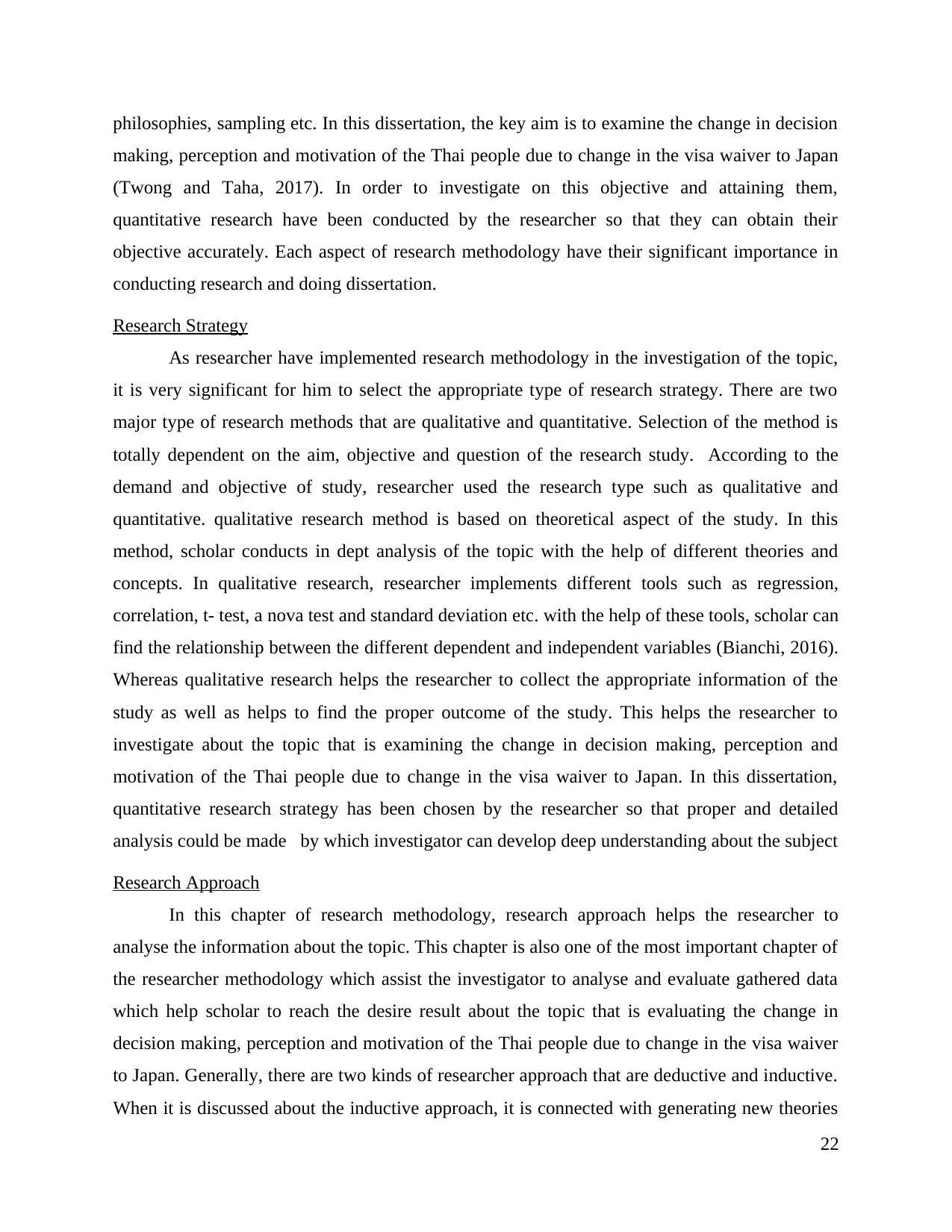
philosophies, sampling etc. In this dissertation, the key aim is to examine the change in decision
making, perception and motivation of the Thai people due to change in the visa waiver to Japan
(Twong and Taha, 2017). In order to investigate on this objective and attaining them,
quantitative research have been conducted by the researcher so that they can obtain their
objective accurately. Each aspect of research methodology have their significant importance in
conducting research and doing dissertation.
Research Strategy
As researcher have implemented research methodology in the investigation of the topic,
it is very significant for him to select the appropriate type of research strategy. There are two
major type of research methods that are qualitative and quantitative. Selection of the method is
totally dependent on the aim, objective and question of the research study. According to the
demand and objective of study, researcher used the research type such as qualitative and
quantitative. qualitative research method is based on theoretical aspect of the study. In this
method, scholar conducts in dept analysis of the topic with the help of different theories and
concepts. In qualitative research, researcher implements different tools such as regression,
correlation, t- test, a nova test and standard deviation etc. with the help of these tools, scholar can
find the relationship between the different dependent and independent variables (Bianchi, 2016).
Whereas qualitative research helps the researcher to collect the appropriate information of the
study as well as helps to find the proper outcome of the study. This helps the researcher to
investigate about the topic that is examining the change in decision making, perception and
motivation of the Thai people due to change in the visa waiver to Japan. In this dissertation,
quantitative research strategy has been chosen by the researcher so that proper and detailed
analysis could be made by which investigator can develop deep understanding about the subject
Research Approach
In this chapter of research methodology, research approach helps the researcher to
analyse the information about the topic. This chapter is also one of the most important chapter of
the researcher methodology which assist the investigator to analyse and evaluate gathered data
which help scholar to reach the desire result about the topic that is evaluating the change in
decision making, perception and motivation of the Thai people due to change in the visa waiver
to Japan. Generally, there are two kinds of researcher approach that are deductive and inductive.
When it is discussed about the inductive approach, it is connected with generating new theories
22
making, perception and motivation of the Thai people due to change in the visa waiver to Japan
(Twong and Taha, 2017). In order to investigate on this objective and attaining them,
quantitative research have been conducted by the researcher so that they can obtain their
objective accurately. Each aspect of research methodology have their significant importance in
conducting research and doing dissertation.
Research Strategy
As researcher have implemented research methodology in the investigation of the topic,
it is very significant for him to select the appropriate type of research strategy. There are two
major type of research methods that are qualitative and quantitative. Selection of the method is
totally dependent on the aim, objective and question of the research study. According to the
demand and objective of study, researcher used the research type such as qualitative and
quantitative. qualitative research method is based on theoretical aspect of the study. In this
method, scholar conducts in dept analysis of the topic with the help of different theories and
concepts. In qualitative research, researcher implements different tools such as regression,
correlation, t- test, a nova test and standard deviation etc. with the help of these tools, scholar can
find the relationship between the different dependent and independent variables (Bianchi, 2016).
Whereas qualitative research helps the researcher to collect the appropriate information of the
study as well as helps to find the proper outcome of the study. This helps the researcher to
investigate about the topic that is examining the change in decision making, perception and
motivation of the Thai people due to change in the visa waiver to Japan. In this dissertation,
quantitative research strategy has been chosen by the researcher so that proper and detailed
analysis could be made by which investigator can develop deep understanding about the subject
Research Approach
In this chapter of research methodology, research approach helps the researcher to
analyse the information about the topic. This chapter is also one of the most important chapter of
the researcher methodology which assist the investigator to analyse and evaluate gathered data
which help scholar to reach the desire result about the topic that is evaluating the change in
decision making, perception and motivation of the Thai people due to change in the visa waiver
to Japan. Generally, there are two kinds of researcher approach that are deductive and inductive.
When it is discussed about the inductive approach, it is connected with generating new theories
22
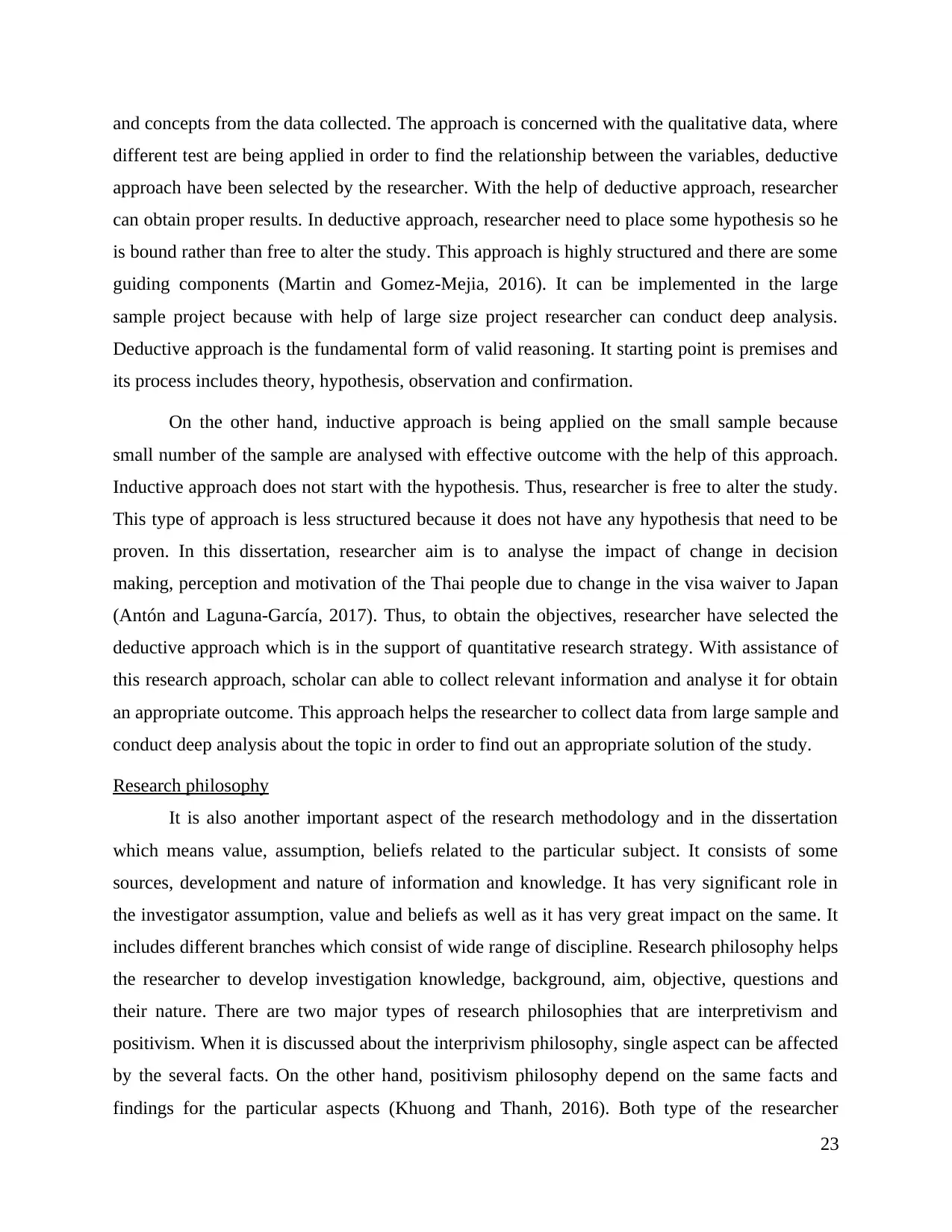
and concepts from the data collected. The approach is concerned with the qualitative data, where
different test are being applied in order to find the relationship between the variables, deductive
approach have been selected by the researcher. With the help of deductive approach, researcher
can obtain proper results. In deductive approach, researcher need to place some hypothesis so he
is bound rather than free to alter the study. This approach is highly structured and there are some
guiding components (Martin and Gomez-Mejia, 2016). It can be implemented in the large
sample project because with help of large size project researcher can conduct deep analysis.
Deductive approach is the fundamental form of valid reasoning. It starting point is premises and
its process includes theory, hypothesis, observation and confirmation.
On the other hand, inductive approach is being applied on the small sample because
small number of the sample are analysed with effective outcome with the help of this approach.
Inductive approach does not start with the hypothesis. Thus, researcher is free to alter the study.
This type of approach is less structured because it does not have any hypothesis that need to be
proven. In this dissertation, researcher aim is to analyse the impact of change in decision
making, perception and motivation of the Thai people due to change in the visa waiver to Japan
(Antón and Laguna-García, 2017). Thus, to obtain the objectives, researcher have selected the
deductive approach which is in the support of quantitative research strategy. With assistance of
this research approach, scholar can able to collect relevant information and analyse it for obtain
an appropriate outcome. This approach helps the researcher to collect data from large sample and
conduct deep analysis about the topic in order to find out an appropriate solution of the study.
Research philosophy
It is also another important aspect of the research methodology and in the dissertation
which means value, assumption, beliefs related to the particular subject. It consists of some
sources, development and nature of information and knowledge. It has very significant role in
the investigator assumption, value and beliefs as well as it has very great impact on the same. It
includes different branches which consist of wide range of discipline. Research philosophy helps
the researcher to develop investigation knowledge, background, aim, objective, questions and
their nature. There are two major types of research philosophies that are interpretivism and
positivism. When it is discussed about the interprivism philosophy, single aspect can be affected
by the several facts. On the other hand, positivism philosophy depend on the same facts and
findings for the particular aspects (Khuong and Thanh, 2016). Both type of the researcher
23
different test are being applied in order to find the relationship between the variables, deductive
approach have been selected by the researcher. With the help of deductive approach, researcher
can obtain proper results. In deductive approach, researcher need to place some hypothesis so he
is bound rather than free to alter the study. This approach is highly structured and there are some
guiding components (Martin and Gomez-Mejia, 2016). It can be implemented in the large
sample project because with help of large size project researcher can conduct deep analysis.
Deductive approach is the fundamental form of valid reasoning. It starting point is premises and
its process includes theory, hypothesis, observation and confirmation.
On the other hand, inductive approach is being applied on the small sample because
small number of the sample are analysed with effective outcome with the help of this approach.
Inductive approach does not start with the hypothesis. Thus, researcher is free to alter the study.
This type of approach is less structured because it does not have any hypothesis that need to be
proven. In this dissertation, researcher aim is to analyse the impact of change in decision
making, perception and motivation of the Thai people due to change in the visa waiver to Japan
(Antón and Laguna-García, 2017). Thus, to obtain the objectives, researcher have selected the
deductive approach which is in the support of quantitative research strategy. With assistance of
this research approach, scholar can able to collect relevant information and analyse it for obtain
an appropriate outcome. This approach helps the researcher to collect data from large sample and
conduct deep analysis about the topic in order to find out an appropriate solution of the study.
Research philosophy
It is also another important aspect of the research methodology and in the dissertation
which means value, assumption, beliefs related to the particular subject. It consists of some
sources, development and nature of information and knowledge. It has very significant role in
the investigator assumption, value and beliefs as well as it has very great impact on the same. It
includes different branches which consist of wide range of discipline. Research philosophy helps
the researcher to develop investigation knowledge, background, aim, objective, questions and
their nature. There are two major types of research philosophies that are interpretivism and
positivism. When it is discussed about the interprivism philosophy, single aspect can be affected
by the several facts. On the other hand, positivism philosophy depend on the same facts and
findings for the particular aspects (Khuong and Thanh, 2016). Both type of the researcher
23
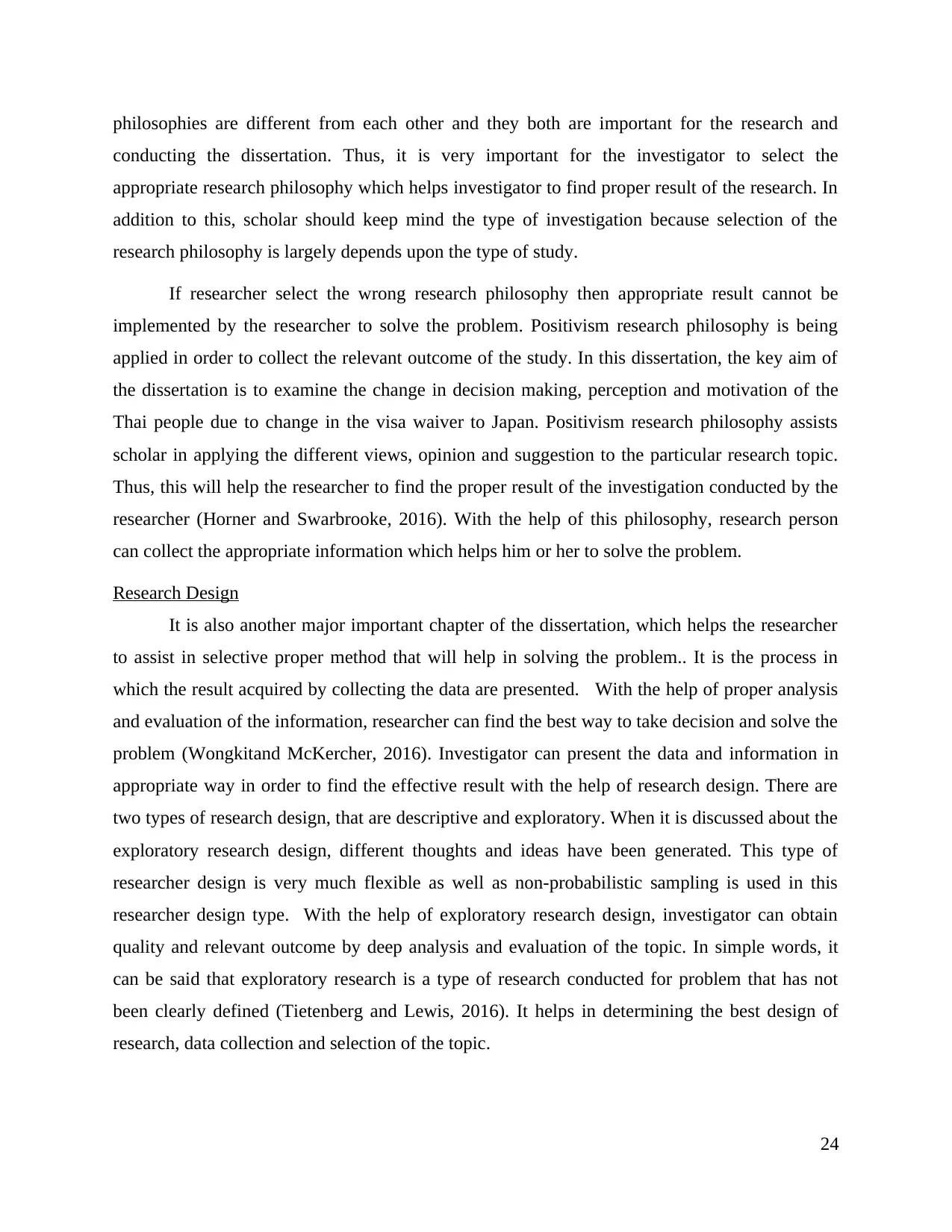
philosophies are different from each other and they both are important for the research and
conducting the dissertation. Thus, it is very important for the investigator to select the
appropriate research philosophy which helps investigator to find proper result of the research. In
addition to this, scholar should keep mind the type of investigation because selection of the
research philosophy is largely depends upon the type of study.
If researcher select the wrong research philosophy then appropriate result cannot be
implemented by the researcher to solve the problem. Positivism research philosophy is being
applied in order to collect the relevant outcome of the study. In this dissertation, the key aim of
the dissertation is to examine the change in decision making, perception and motivation of the
Thai people due to change in the visa waiver to Japan. Positivism research philosophy assists
scholar in applying the different views, opinion and suggestion to the particular research topic.
Thus, this will help the researcher to find the proper result of the investigation conducted by the
researcher (Horner and Swarbrooke, 2016). With the help of this philosophy, research person
can collect the appropriate information which helps him or her to solve the problem.
Research Design
It is also another major important chapter of the dissertation, which helps the researcher
to assist in selective proper method that will help in solving the problem.. It is the process in
which the result acquired by collecting the data are presented. With the help of proper analysis
and evaluation of the information, researcher can find the best way to take decision and solve the
problem (Wongkitand McKercher, 2016). Investigator can present the data and information in
appropriate way in order to find the effective result with the help of research design. There are
two types of research design, that are descriptive and exploratory. When it is discussed about the
exploratory research design, different thoughts and ideas have been generated. This type of
researcher design is very much flexible as well as non-probabilistic sampling is used in this
researcher design type. With the help of exploratory research design, investigator can obtain
quality and relevant outcome by deep analysis and evaluation of the topic. In simple words, it
can be said that exploratory research is a type of research conducted for problem that has not
been clearly defined (Tietenberg and Lewis, 2016). It helps in determining the best design of
research, data collection and selection of the topic.
24
conducting the dissertation. Thus, it is very important for the investigator to select the
appropriate research philosophy which helps investigator to find proper result of the research. In
addition to this, scholar should keep mind the type of investigation because selection of the
research philosophy is largely depends upon the type of study.
If researcher select the wrong research philosophy then appropriate result cannot be
implemented by the researcher to solve the problem. Positivism research philosophy is being
applied in order to collect the relevant outcome of the study. In this dissertation, the key aim of
the dissertation is to examine the change in decision making, perception and motivation of the
Thai people due to change in the visa waiver to Japan. Positivism research philosophy assists
scholar in applying the different views, opinion and suggestion to the particular research topic.
Thus, this will help the researcher to find the proper result of the investigation conducted by the
researcher (Horner and Swarbrooke, 2016). With the help of this philosophy, research person
can collect the appropriate information which helps him or her to solve the problem.
Research Design
It is also another major important chapter of the dissertation, which helps the researcher
to assist in selective proper method that will help in solving the problem.. It is the process in
which the result acquired by collecting the data are presented. With the help of proper analysis
and evaluation of the information, researcher can find the best way to take decision and solve the
problem (Wongkitand McKercher, 2016). Investigator can present the data and information in
appropriate way in order to find the effective result with the help of research design. There are
two types of research design, that are descriptive and exploratory. When it is discussed about the
exploratory research design, different thoughts and ideas have been generated. This type of
researcher design is very much flexible as well as non-probabilistic sampling is used in this
researcher design type. With the help of exploratory research design, investigator can obtain
quality and relevant outcome by deep analysis and evaluation of the topic. In simple words, it
can be said that exploratory research is a type of research conducted for problem that has not
been clearly defined (Tietenberg and Lewis, 2016). It helps in determining the best design of
research, data collection and selection of the topic.
24
Secure Best Marks with AI Grader
Need help grading? Try our AI Grader for instant feedback on your assignments.
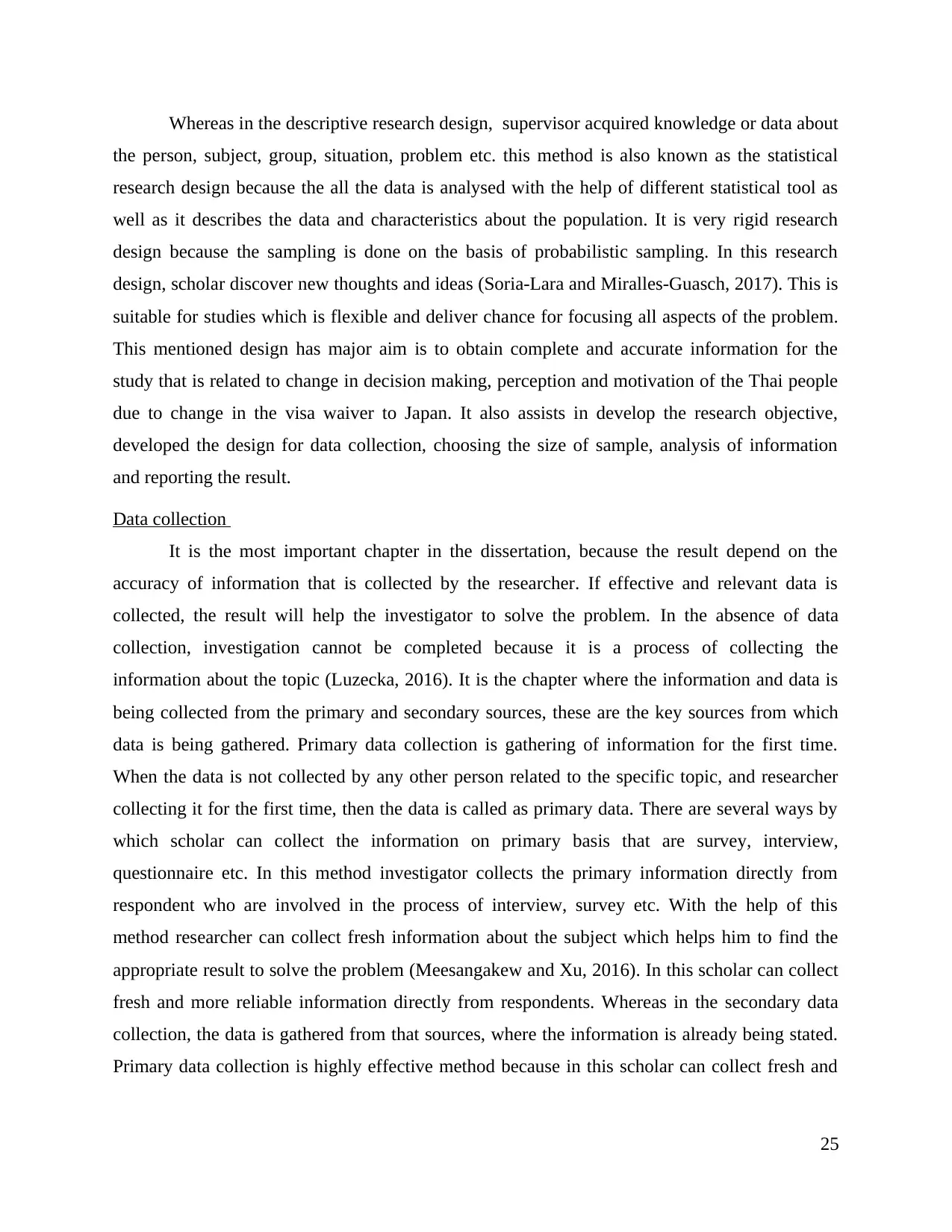
Whereas in the descriptive research design, supervisor acquired knowledge or data about
the person, subject, group, situation, problem etc. this method is also known as the statistical
research design because the all the data is analysed with the help of different statistical tool as
well as it describes the data and characteristics about the population. It is very rigid research
design because the sampling is done on the basis of probabilistic sampling. In this research
design, scholar discover new thoughts and ideas (Soria-Lara and Miralles-Guasch, 2017). This is
suitable for studies which is flexible and deliver chance for focusing all aspects of the problem.
This mentioned design has major aim is to obtain complete and accurate information for the
study that is related to change in decision making, perception and motivation of the Thai people
due to change in the visa waiver to Japan. It also assists in develop the research objective,
developed the design for data collection, choosing the size of sample, analysis of information
and reporting the result.
Data collection
It is the most important chapter in the dissertation, because the result depend on the
accuracy of information that is collected by the researcher. If effective and relevant data is
collected, the result will help the investigator to solve the problem. In the absence of data
collection, investigation cannot be completed because it is a process of collecting the
information about the topic (Luzecka, 2016). It is the chapter where the information and data is
being collected from the primary and secondary sources, these are the key sources from which
data is being gathered. Primary data collection is gathering of information for the first time.
When the data is not collected by any other person related to the specific topic, and researcher
collecting it for the first time, then the data is called as primary data. There are several ways by
which scholar can collect the information on primary basis that are survey, interview,
questionnaire etc. In this method investigator collects the primary information directly from
respondent who are involved in the process of interview, survey etc. With the help of this
method researcher can collect fresh information about the subject which helps him to find the
appropriate result to solve the problem (Meesangakew and Xu, 2016). In this scholar can collect
fresh and more reliable information directly from respondents. Whereas in the secondary data
collection, the data is gathered from that sources, where the information is already being stated.
Primary data collection is highly effective method because in this scholar can collect fresh and
25
the person, subject, group, situation, problem etc. this method is also known as the statistical
research design because the all the data is analysed with the help of different statistical tool as
well as it describes the data and characteristics about the population. It is very rigid research
design because the sampling is done on the basis of probabilistic sampling. In this research
design, scholar discover new thoughts and ideas (Soria-Lara and Miralles-Guasch, 2017). This is
suitable for studies which is flexible and deliver chance for focusing all aspects of the problem.
This mentioned design has major aim is to obtain complete and accurate information for the
study that is related to change in decision making, perception and motivation of the Thai people
due to change in the visa waiver to Japan. It also assists in develop the research objective,
developed the design for data collection, choosing the size of sample, analysis of information
and reporting the result.
Data collection
It is the most important chapter in the dissertation, because the result depend on the
accuracy of information that is collected by the researcher. If effective and relevant data is
collected, the result will help the investigator to solve the problem. In the absence of data
collection, investigation cannot be completed because it is a process of collecting the
information about the topic (Luzecka, 2016). It is the chapter where the information and data is
being collected from the primary and secondary sources, these are the key sources from which
data is being gathered. Primary data collection is gathering of information for the first time.
When the data is not collected by any other person related to the specific topic, and researcher
collecting it for the first time, then the data is called as primary data. There are several ways by
which scholar can collect the information on primary basis that are survey, interview,
questionnaire etc. In this method investigator collects the primary information directly from
respondent who are involved in the process of interview, survey etc. With the help of this
method researcher can collect fresh information about the subject which helps him to find the
appropriate result to solve the problem (Meesangakew and Xu, 2016). In this scholar can collect
fresh and more reliable information directly from respondents. Whereas in the secondary data
collection, the data is gathered from that sources, where the information is already being stated.
Primary data collection is highly effective method because in this scholar can collect fresh and
25
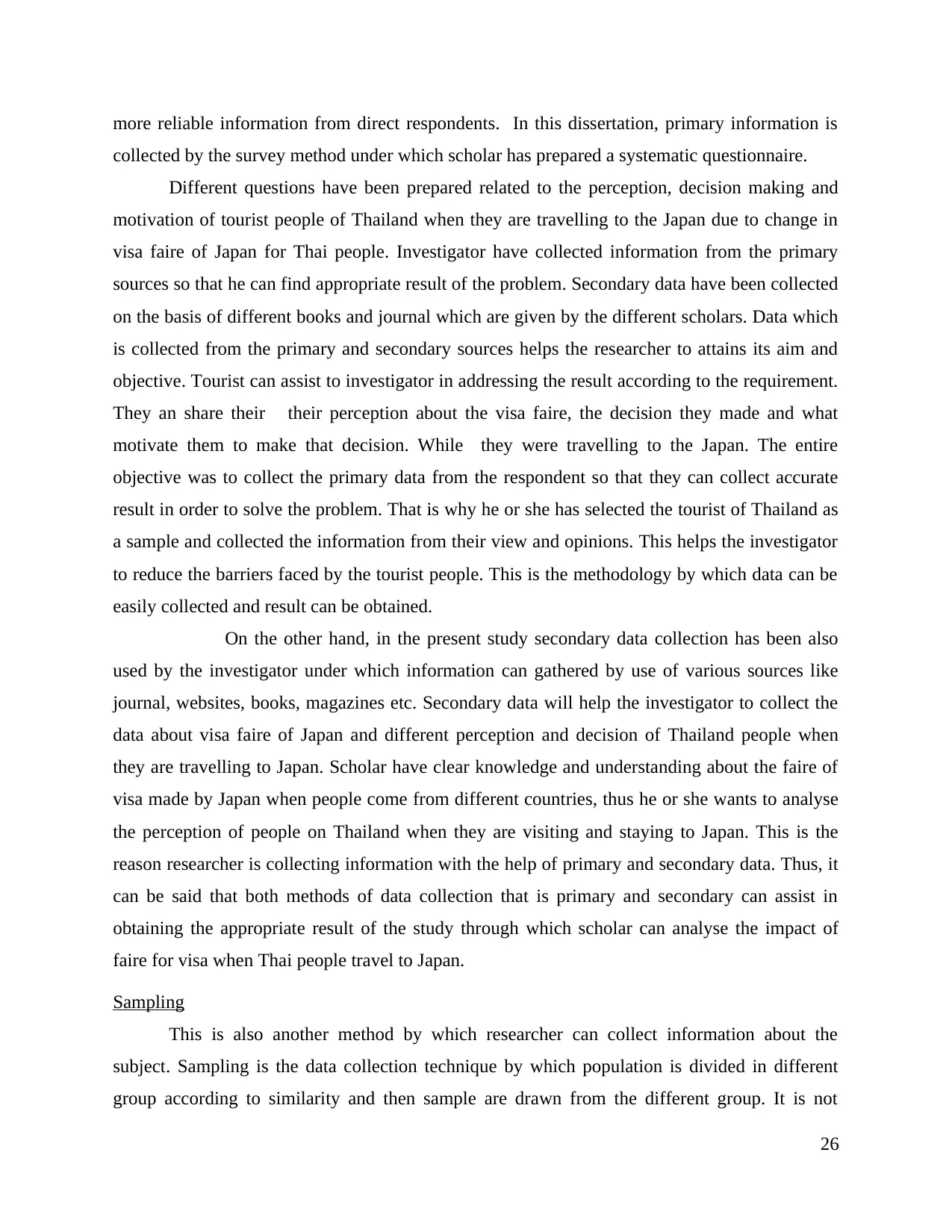
more reliable information from direct respondents. In this dissertation, primary information is
collected by the survey method under which scholar has prepared a systematic questionnaire.
Different questions have been prepared related to the perception, decision making and
motivation of tourist people of Thailand when they are travelling to the Japan due to change in
visa faire of Japan for Thai people. Investigator have collected information from the primary
sources so that he can find appropriate result of the problem. Secondary data have been collected
on the basis of different books and journal which are given by the different scholars. Data which
is collected from the primary and secondary sources helps the researcher to attains its aim and
objective. Tourist can assist to investigator in addressing the result according to the requirement.
They an share their their perception about the visa faire, the decision they made and what
motivate them to make that decision. While they were travelling to the Japan. The entire
objective was to collect the primary data from the respondent so that they can collect accurate
result in order to solve the problem. That is why he or she has selected the tourist of Thailand as
a sample and collected the information from their view and opinions. This helps the investigator
to reduce the barriers faced by the tourist people. This is the methodology by which data can be
easily collected and result can be obtained.
On the other hand, in the present study secondary data collection has been also
used by the investigator under which information can gathered by use of various sources like
journal, websites, books, magazines etc. Secondary data will help the investigator to collect the
data about visa faire of Japan and different perception and decision of Thailand people when
they are travelling to Japan. Scholar have clear knowledge and understanding about the faire of
visa made by Japan when people come from different countries, thus he or she wants to analyse
the perception of people on Thailand when they are visiting and staying to Japan. This is the
reason researcher is collecting information with the help of primary and secondary data. Thus, it
can be said that both methods of data collection that is primary and secondary can assist in
obtaining the appropriate result of the study through which scholar can analyse the impact of
faire for visa when Thai people travel to Japan.
Sampling
This is also another method by which researcher can collect information about the
subject. Sampling is the data collection technique by which population is divided in different
group according to similarity and then sample are drawn from the different group. It is not
26
collected by the survey method under which scholar has prepared a systematic questionnaire.
Different questions have been prepared related to the perception, decision making and
motivation of tourist people of Thailand when they are travelling to the Japan due to change in
visa faire of Japan for Thai people. Investigator have collected information from the primary
sources so that he can find appropriate result of the problem. Secondary data have been collected
on the basis of different books and journal which are given by the different scholars. Data which
is collected from the primary and secondary sources helps the researcher to attains its aim and
objective. Tourist can assist to investigator in addressing the result according to the requirement.
They an share their their perception about the visa faire, the decision they made and what
motivate them to make that decision. While they were travelling to the Japan. The entire
objective was to collect the primary data from the respondent so that they can collect accurate
result in order to solve the problem. That is why he or she has selected the tourist of Thailand as
a sample and collected the information from their view and opinions. This helps the investigator
to reduce the barriers faced by the tourist people. This is the methodology by which data can be
easily collected and result can be obtained.
On the other hand, in the present study secondary data collection has been also
used by the investigator under which information can gathered by use of various sources like
journal, websites, books, magazines etc. Secondary data will help the investigator to collect the
data about visa faire of Japan and different perception and decision of Thailand people when
they are travelling to Japan. Scholar have clear knowledge and understanding about the faire of
visa made by Japan when people come from different countries, thus he or she wants to analyse
the perception of people on Thailand when they are visiting and staying to Japan. This is the
reason researcher is collecting information with the help of primary and secondary data. Thus, it
can be said that both methods of data collection that is primary and secondary can assist in
obtaining the appropriate result of the study through which scholar can analyse the impact of
faire for visa when Thai people travel to Japan.
Sampling
This is also another method by which researcher can collect information about the
subject. Sampling is the data collection technique by which population is divided in different
group according to similarity and then sample are drawn from the different group. It is not
26
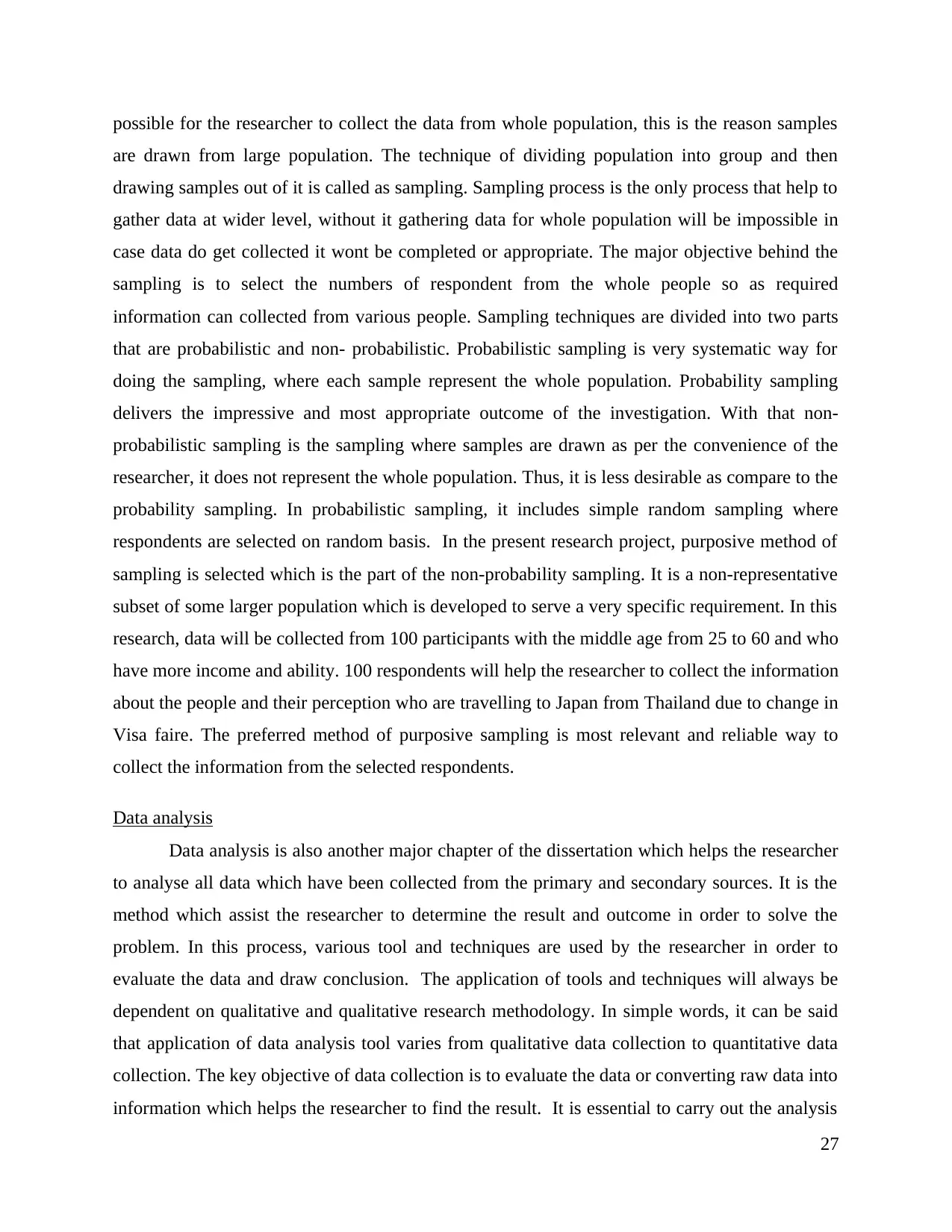
possible for the researcher to collect the data from whole population, this is the reason samples
are drawn from large population. The technique of dividing population into group and then
drawing samples out of it is called as sampling. Sampling process is the only process that help to
gather data at wider level, without it gathering data for whole population will be impossible in
case data do get collected it wont be completed or appropriate. The major objective behind the
sampling is to select the numbers of respondent from the whole people so as required
information can collected from various people. Sampling techniques are divided into two parts
that are probabilistic and non- probabilistic. Probabilistic sampling is very systematic way for
doing the sampling, where each sample represent the whole population. Probability sampling
delivers the impressive and most appropriate outcome of the investigation. With that non-
probabilistic sampling is the sampling where samples are drawn as per the convenience of the
researcher, it does not represent the whole population. Thus, it is less desirable as compare to the
probability sampling. In probabilistic sampling, it includes simple random sampling where
respondents are selected on random basis. In the present research project, purposive method of
sampling is selected which is the part of the non-probability sampling. It is a non-representative
subset of some larger population which is developed to serve a very specific requirement. In this
research, data will be collected from 100 participants with the middle age from 25 to 60 and who
have more income and ability. 100 respondents will help the researcher to collect the information
about the people and their perception who are travelling to Japan from Thailand due to change in
Visa faire. The preferred method of purposive sampling is most relevant and reliable way to
collect the information from the selected respondents.
Data analysis
Data analysis is also another major chapter of the dissertation which helps the researcher
to analyse all data which have been collected from the primary and secondary sources. It is the
method which assist the researcher to determine the result and outcome in order to solve the
problem. In this process, various tool and techniques are used by the researcher in order to
evaluate the data and draw conclusion. The application of tools and techniques will always be
dependent on qualitative and qualitative research methodology. In simple words, it can be said
that application of data analysis tool varies from qualitative data collection to quantitative data
collection. The key objective of data collection is to evaluate the data or converting raw data into
information which helps the researcher to find the result. It is essential to carry out the analysis
27
are drawn from large population. The technique of dividing population into group and then
drawing samples out of it is called as sampling. Sampling process is the only process that help to
gather data at wider level, without it gathering data for whole population will be impossible in
case data do get collected it wont be completed or appropriate. The major objective behind the
sampling is to select the numbers of respondent from the whole people so as required
information can collected from various people. Sampling techniques are divided into two parts
that are probabilistic and non- probabilistic. Probabilistic sampling is very systematic way for
doing the sampling, where each sample represent the whole population. Probability sampling
delivers the impressive and most appropriate outcome of the investigation. With that non-
probabilistic sampling is the sampling where samples are drawn as per the convenience of the
researcher, it does not represent the whole population. Thus, it is less desirable as compare to the
probability sampling. In probabilistic sampling, it includes simple random sampling where
respondents are selected on random basis. In the present research project, purposive method of
sampling is selected which is the part of the non-probability sampling. It is a non-representative
subset of some larger population which is developed to serve a very specific requirement. In this
research, data will be collected from 100 participants with the middle age from 25 to 60 and who
have more income and ability. 100 respondents will help the researcher to collect the information
about the people and their perception who are travelling to Japan from Thailand due to change in
Visa faire. The preferred method of purposive sampling is most relevant and reliable way to
collect the information from the selected respondents.
Data analysis
Data analysis is also another major chapter of the dissertation which helps the researcher
to analyse all data which have been collected from the primary and secondary sources. It is the
method which assist the researcher to determine the result and outcome in order to solve the
problem. In this process, various tool and techniques are used by the researcher in order to
evaluate the data and draw conclusion. The application of tools and techniques will always be
dependent on qualitative and qualitative research methodology. In simple words, it can be said
that application of data analysis tool varies from qualitative data collection to quantitative data
collection. The key objective of data collection is to evaluate the data or converting raw data into
information which helps the researcher to find the result. It is essential to carry out the analysis
27
Paraphrase This Document
Need a fresh take? Get an instant paraphrase of this document with our AI Paraphraser
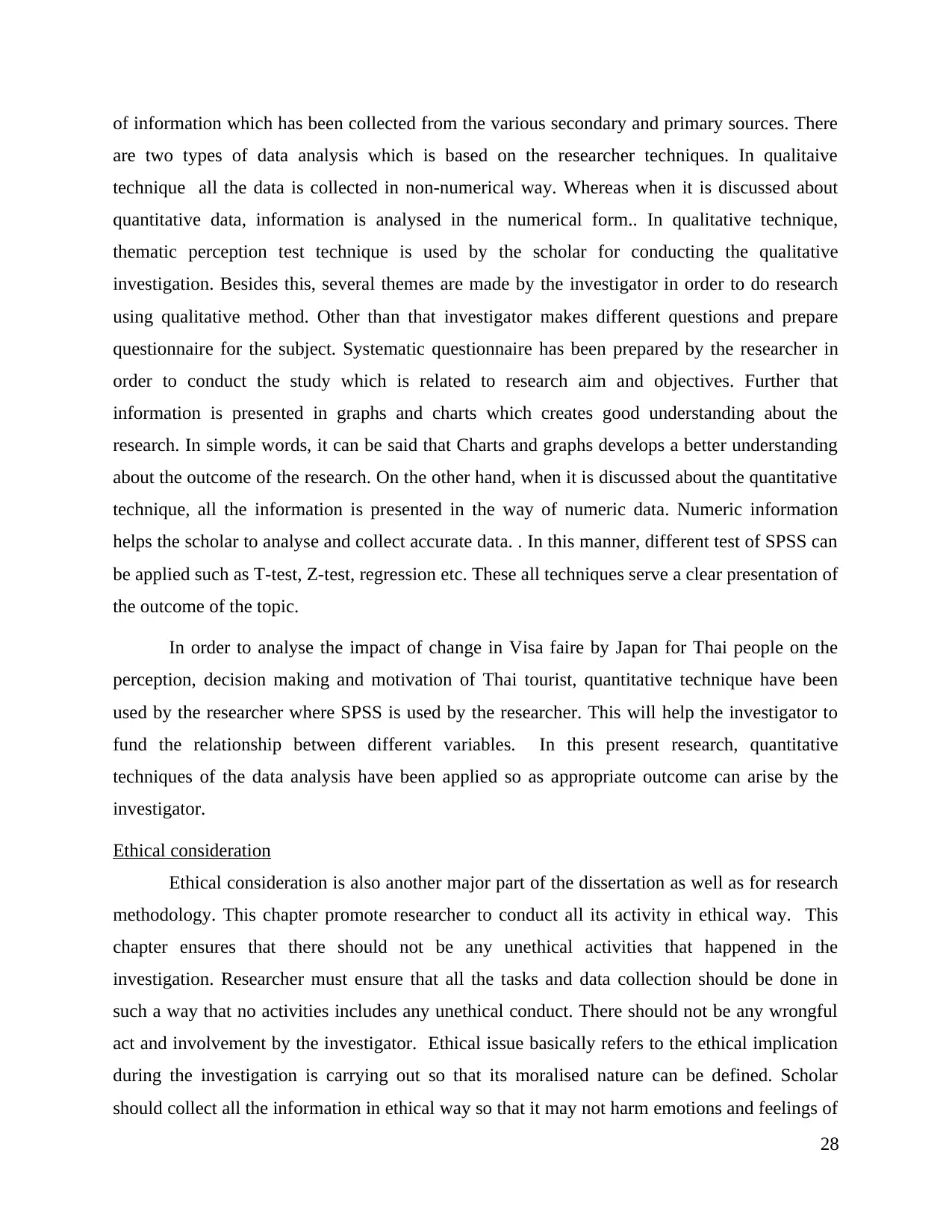
of information which has been collected from the various secondary and primary sources. There
are two types of data analysis which is based on the researcher techniques. In qualitaive
technique all the data is collected in non-numerical way. Whereas when it is discussed about
quantitative data, information is analysed in the numerical form.. In qualitative technique,
thematic perception test technique is used by the scholar for conducting the qualitative
investigation. Besides this, several themes are made by the investigator in order to do research
using qualitative method. Other than that investigator makes different questions and prepare
questionnaire for the subject. Systematic questionnaire has been prepared by the researcher in
order to conduct the study which is related to research aim and objectives. Further that
information is presented in graphs and charts which creates good understanding about the
research. In simple words, it can be said that Charts and graphs develops a better understanding
about the outcome of the research. On the other hand, when it is discussed about the quantitative
technique, all the information is presented in the way of numeric data. Numeric information
helps the scholar to analyse and collect accurate data. . In this manner, different test of SPSS can
be applied such as T-test, Z-test, regression etc. These all techniques serve a clear presentation of
the outcome of the topic.
In order to analyse the impact of change in Visa faire by Japan for Thai people on the
perception, decision making and motivation of Thai tourist, quantitative technique have been
used by the researcher where SPSS is used by the researcher. This will help the investigator to
fund the relationship between different variables. In this present research, quantitative
techniques of the data analysis have been applied so as appropriate outcome can arise by the
investigator.
Ethical consideration
Ethical consideration is also another major part of the dissertation as well as for research
methodology. This chapter promote researcher to conduct all its activity in ethical way. This
chapter ensures that there should not be any unethical activities that happened in the
investigation. Researcher must ensure that all the tasks and data collection should be done in
such a way that no activities includes any unethical conduct. There should not be any wrongful
act and involvement by the investigator. Ethical issue basically refers to the ethical implication
during the investigation is carrying out so that its moralised nature can be defined. Scholar
should collect all the information in ethical way so that it may not harm emotions and feelings of
28
are two types of data analysis which is based on the researcher techniques. In qualitaive
technique all the data is collected in non-numerical way. Whereas when it is discussed about
quantitative data, information is analysed in the numerical form.. In qualitative technique,
thematic perception test technique is used by the scholar for conducting the qualitative
investigation. Besides this, several themes are made by the investigator in order to do research
using qualitative method. Other than that investigator makes different questions and prepare
questionnaire for the subject. Systematic questionnaire has been prepared by the researcher in
order to conduct the study which is related to research aim and objectives. Further that
information is presented in graphs and charts which creates good understanding about the
research. In simple words, it can be said that Charts and graphs develops a better understanding
about the outcome of the research. On the other hand, when it is discussed about the quantitative
technique, all the information is presented in the way of numeric data. Numeric information
helps the scholar to analyse and collect accurate data. . In this manner, different test of SPSS can
be applied such as T-test, Z-test, regression etc. These all techniques serve a clear presentation of
the outcome of the topic.
In order to analyse the impact of change in Visa faire by Japan for Thai people on the
perception, decision making and motivation of Thai tourist, quantitative technique have been
used by the researcher where SPSS is used by the researcher. This will help the investigator to
fund the relationship between different variables. In this present research, quantitative
techniques of the data analysis have been applied so as appropriate outcome can arise by the
investigator.
Ethical consideration
Ethical consideration is also another major part of the dissertation as well as for research
methodology. This chapter promote researcher to conduct all its activity in ethical way. This
chapter ensures that there should not be any unethical activities that happened in the
investigation. Researcher must ensure that all the tasks and data collection should be done in
such a way that no activities includes any unethical conduct. There should not be any wrongful
act and involvement by the investigator. Ethical issue basically refers to the ethical implication
during the investigation is carrying out so that its moralised nature can be defined. Scholar
should collect all the information in ethical way so that it may not harm emotions and feelings of
28
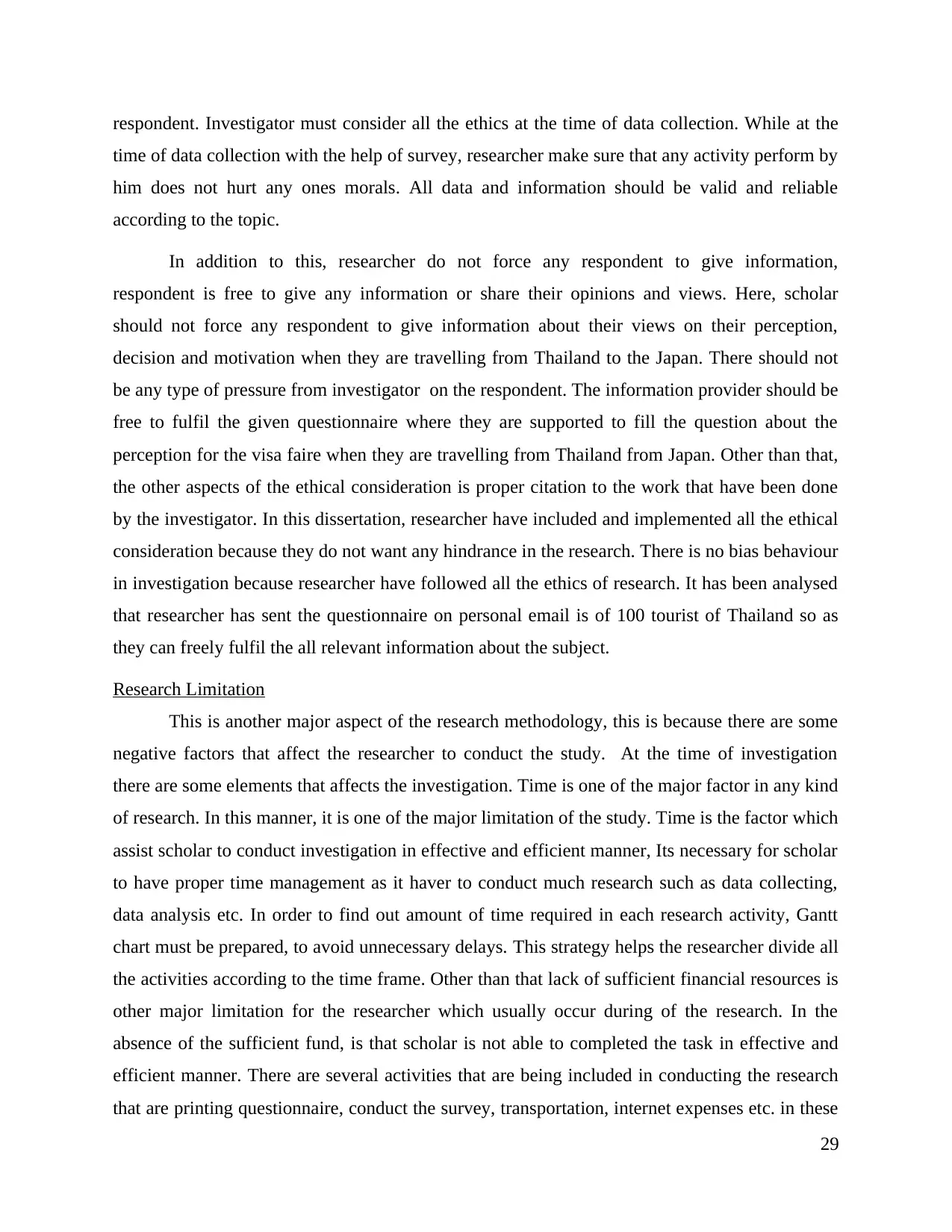
respondent. Investigator must consider all the ethics at the time of data collection. While at the
time of data collection with the help of survey, researcher make sure that any activity perform by
him does not hurt any ones morals. All data and information should be valid and reliable
according to the topic.
In addition to this, researcher do not force any respondent to give information,
respondent is free to give any information or share their opinions and views. Here, scholar
should not force any respondent to give information about their views on their perception,
decision and motivation when they are travelling from Thailand to the Japan. There should not
be any type of pressure from investigator on the respondent. The information provider should be
free to fulfil the given questionnaire where they are supported to fill the question about the
perception for the visa faire when they are travelling from Thailand from Japan. Other than that,
the other aspects of the ethical consideration is proper citation to the work that have been done
by the investigator. In this dissertation, researcher have included and implemented all the ethical
consideration because they do not want any hindrance in the research. There is no bias behaviour
in investigation because researcher have followed all the ethics of research. It has been analysed
that researcher has sent the questionnaire on personal email is of 100 tourist of Thailand so as
they can freely fulfil the all relevant information about the subject.
Research Limitation
This is another major aspect of the research methodology, this is because there are some
negative factors that affect the researcher to conduct the study. At the time of investigation
there are some elements that affects the investigation. Time is one of the major factor in any kind
of research. In this manner, it is one of the major limitation of the study. Time is the factor which
assist scholar to conduct investigation in effective and efficient manner, Its necessary for scholar
to have proper time management as it haver to conduct much research such as data collecting,
data analysis etc. In order to find out amount of time required in each research activity, Gantt
chart must be prepared, to avoid unnecessary delays. This strategy helps the researcher divide all
the activities according to the time frame. Other than that lack of sufficient financial resources is
other major limitation for the researcher which usually occur during of the research. In the
absence of the sufficient fund, is that scholar is not able to completed the task in effective and
efficient manner. There are several activities that are being included in conducting the research
that are printing questionnaire, conduct the survey, transportation, internet expenses etc. in these
29
time of data collection with the help of survey, researcher make sure that any activity perform by
him does not hurt any ones morals. All data and information should be valid and reliable
according to the topic.
In addition to this, researcher do not force any respondent to give information,
respondent is free to give any information or share their opinions and views. Here, scholar
should not force any respondent to give information about their views on their perception,
decision and motivation when they are travelling from Thailand to the Japan. There should not
be any type of pressure from investigator on the respondent. The information provider should be
free to fulfil the given questionnaire where they are supported to fill the question about the
perception for the visa faire when they are travelling from Thailand from Japan. Other than that,
the other aspects of the ethical consideration is proper citation to the work that have been done
by the investigator. In this dissertation, researcher have included and implemented all the ethical
consideration because they do not want any hindrance in the research. There is no bias behaviour
in investigation because researcher have followed all the ethics of research. It has been analysed
that researcher has sent the questionnaire on personal email is of 100 tourist of Thailand so as
they can freely fulfil the all relevant information about the subject.
Research Limitation
This is another major aspect of the research methodology, this is because there are some
negative factors that affect the researcher to conduct the study. At the time of investigation
there are some elements that affects the investigation. Time is one of the major factor in any kind
of research. In this manner, it is one of the major limitation of the study. Time is the factor which
assist scholar to conduct investigation in effective and efficient manner, Its necessary for scholar
to have proper time management as it haver to conduct much research such as data collecting,
data analysis etc. In order to find out amount of time required in each research activity, Gantt
chart must be prepared, to avoid unnecessary delays. This strategy helps the researcher divide all
the activities according to the time frame. Other than that lack of sufficient financial resources is
other major limitation for the researcher which usually occur during of the research. In the
absence of the sufficient fund, is that scholar is not able to completed the task in effective and
efficient manner. There are several activities that are being included in conducting the research
that are printing questionnaire, conduct the survey, transportation, internet expenses etc. in these
29
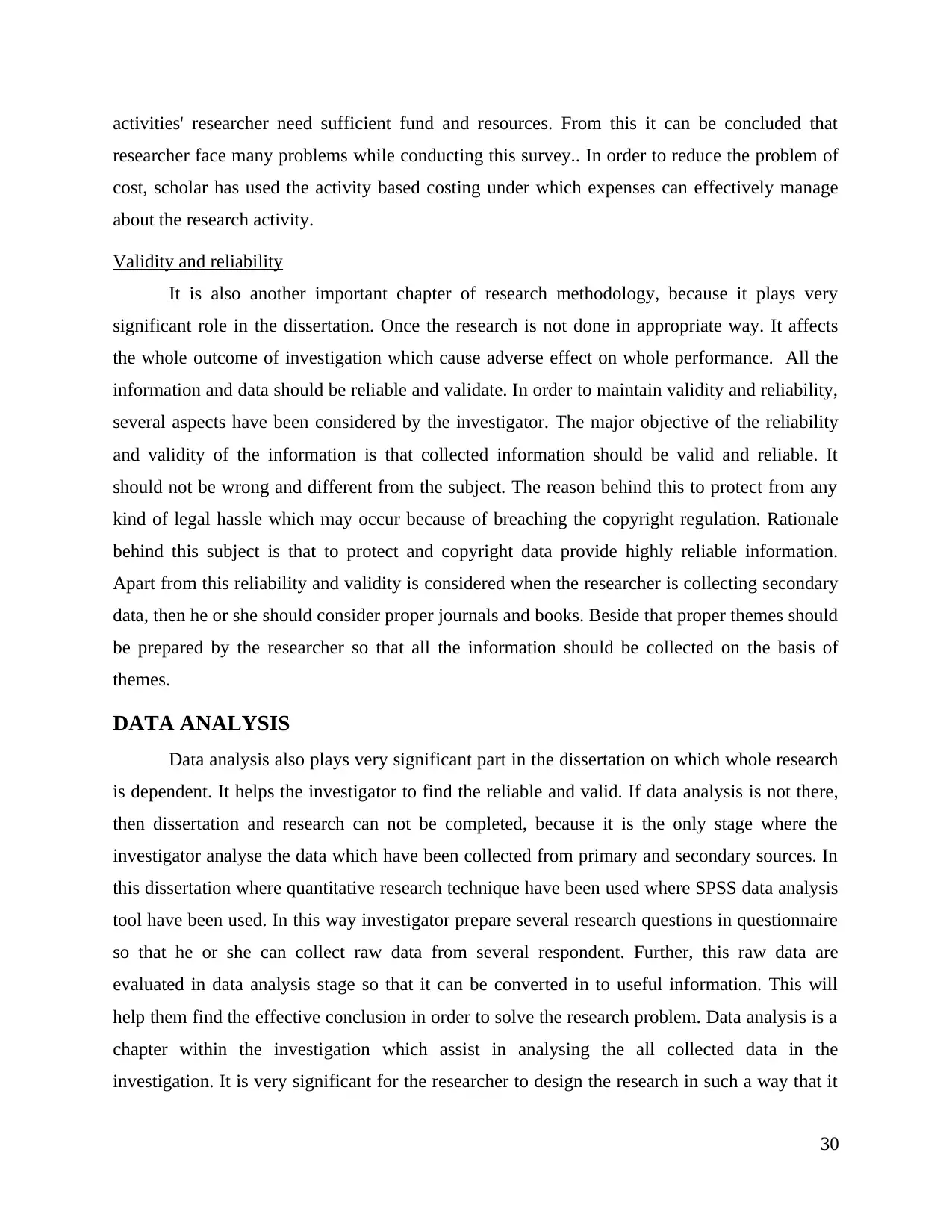
activities' researcher need sufficient fund and resources. From this it can be concluded that
researcher face many problems while conducting this survey.. In order to reduce the problem of
cost, scholar has used the activity based costing under which expenses can effectively manage
about the research activity.
Validity and reliability
It is also another important chapter of research methodology, because it plays very
significant role in the dissertation. Once the research is not done in appropriate way. It affects
the whole outcome of investigation which cause adverse effect on whole performance. All the
information and data should be reliable and validate. In order to maintain validity and reliability,
several aspects have been considered by the investigator. The major objective of the reliability
and validity of the information is that collected information should be valid and reliable. It
should not be wrong and different from the subject. The reason behind this to protect from any
kind of legal hassle which may occur because of breaching the copyright regulation. Rationale
behind this subject is that to protect and copyright data provide highly reliable information.
Apart from this reliability and validity is considered when the researcher is collecting secondary
data, then he or she should consider proper journals and books. Beside that proper themes should
be prepared by the researcher so that all the information should be collected on the basis of
themes.
DATA ANALYSIS
Data analysis also plays very significant part in the dissertation on which whole research
is dependent. It helps the investigator to find the reliable and valid. If data analysis is not there,
then dissertation and research can not be completed, because it is the only stage where the
investigator analyse the data which have been collected from primary and secondary sources. In
this dissertation where quantitative research technique have been used where SPSS data analysis
tool have been used. In this way investigator prepare several research questions in questionnaire
so that he or she can collect raw data from several respondent. Further, this raw data are
evaluated in data analysis stage so that it can be converted in to useful information. This will
help them find the effective conclusion in order to solve the research problem. Data analysis is a
chapter within the investigation which assist in analysing the all collected data in the
investigation. It is very significant for the researcher to design the research in such a way that it
30
researcher face many problems while conducting this survey.. In order to reduce the problem of
cost, scholar has used the activity based costing under which expenses can effectively manage
about the research activity.
Validity and reliability
It is also another important chapter of research methodology, because it plays very
significant role in the dissertation. Once the research is not done in appropriate way. It affects
the whole outcome of investigation which cause adverse effect on whole performance. All the
information and data should be reliable and validate. In order to maintain validity and reliability,
several aspects have been considered by the investigator. The major objective of the reliability
and validity of the information is that collected information should be valid and reliable. It
should not be wrong and different from the subject. The reason behind this to protect from any
kind of legal hassle which may occur because of breaching the copyright regulation. Rationale
behind this subject is that to protect and copyright data provide highly reliable information.
Apart from this reliability and validity is considered when the researcher is collecting secondary
data, then he or she should consider proper journals and books. Beside that proper themes should
be prepared by the researcher so that all the information should be collected on the basis of
themes.
DATA ANALYSIS
Data analysis also plays very significant part in the dissertation on which whole research
is dependent. It helps the investigator to find the reliable and valid. If data analysis is not there,
then dissertation and research can not be completed, because it is the only stage where the
investigator analyse the data which have been collected from primary and secondary sources. In
this dissertation where quantitative research technique have been used where SPSS data analysis
tool have been used. In this way investigator prepare several research questions in questionnaire
so that he or she can collect raw data from several respondent. Further, this raw data are
evaluated in data analysis stage so that it can be converted in to useful information. This will
help them find the effective conclusion in order to solve the research problem. Data analysis is a
chapter within the investigation which assist in analysing the all collected data in the
investigation. It is very significant for the researcher to design the research in such a way that it
30
Secure Best Marks with AI Grader
Need help grading? Try our AI Grader for instant feedback on your assignments.
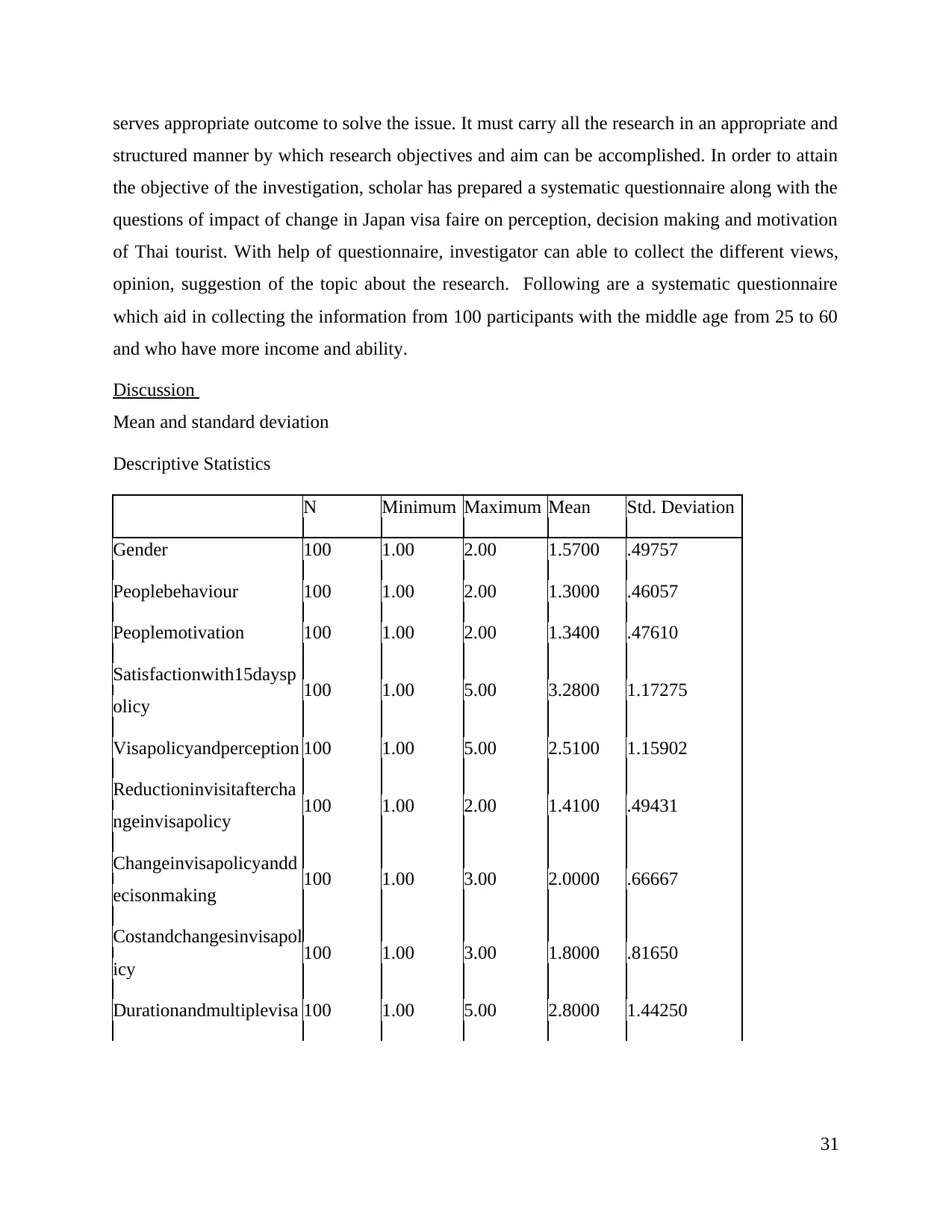
serves appropriate outcome to solve the issue. It must carry all the research in an appropriate and
structured manner by which research objectives and aim can be accomplished. In order to attain
the objective of the investigation, scholar has prepared a systematic questionnaire along with the
questions of impact of change in Japan visa faire on perception, decision making and motivation
of Thai tourist. With help of questionnaire, investigator can able to collect the different views,
opinion, suggestion of the topic about the research. Following are a systematic questionnaire
which aid in collecting the information from 100 participants with the middle age from 25 to 60
and who have more income and ability.
Discussion
Mean and standard deviation
Descriptive Statistics
N Minimum Maximum Mean Std. Deviation
Gender 100 1.00 2.00 1.5700 .49757
Peoplebehaviour 100 1.00 2.00 1.3000 .46057
Peoplemotivation 100 1.00 2.00 1.3400 .47610
Satisfactionwith15daysp
olicy 100 1.00 5.00 3.2800 1.17275
Visapolicyandperception 100 1.00 5.00 2.5100 1.15902
Reductioninvisitaftercha
ngeinvisapolicy 100 1.00 2.00 1.4100 .49431
Changeinvisapolicyandd
ecisonmaking 100 1.00 3.00 2.0000 .66667
Costandchangesinvisapol
icy 100 1.00 3.00 1.8000 .81650
Durationandmultiplevisa 100 1.00 5.00 2.8000 1.44250
31
structured manner by which research objectives and aim can be accomplished. In order to attain
the objective of the investigation, scholar has prepared a systematic questionnaire along with the
questions of impact of change in Japan visa faire on perception, decision making and motivation
of Thai tourist. With help of questionnaire, investigator can able to collect the different views,
opinion, suggestion of the topic about the research. Following are a systematic questionnaire
which aid in collecting the information from 100 participants with the middle age from 25 to 60
and who have more income and ability.
Discussion
Mean and standard deviation
Descriptive Statistics
N Minimum Maximum Mean Std. Deviation
Gender 100 1.00 2.00 1.5700 .49757
Peoplebehaviour 100 1.00 2.00 1.3000 .46057
Peoplemotivation 100 1.00 2.00 1.3400 .47610
Satisfactionwith15daysp
olicy 100 1.00 5.00 3.2800 1.17275
Visapolicyandperception 100 1.00 5.00 2.5100 1.15902
Reductioninvisitaftercha
ngeinvisapolicy 100 1.00 2.00 1.4100 .49431
Changeinvisapolicyandd
ecisonmaking 100 1.00 3.00 2.0000 .66667
Costandchangesinvisapol
icy 100 1.00 3.00 1.8000 .81650
Durationandmultiplevisa 100 1.00 5.00 2.8000 1.44250
31
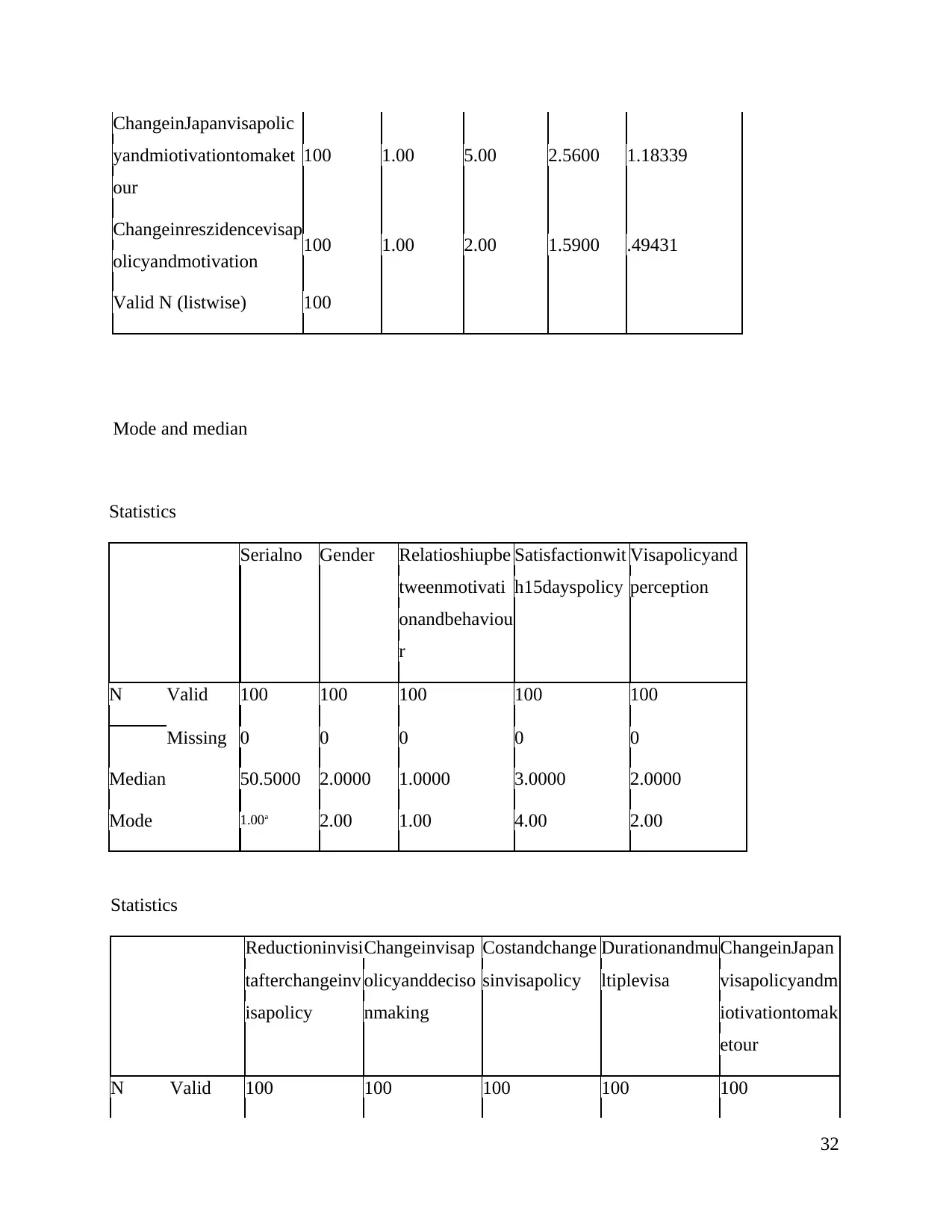
ChangeinJapanvisapolic
yandmiotivationtomaket
our
100 1.00 5.00 2.5600 1.18339
Changeinreszidencevisap
olicyandmotivation 100 1.00 2.00 1.5900 .49431
Valid N (listwise) 100
Mode and median
Statistics
Serialno Gender Relatioshiupbe
tweenmotivati
onandbehaviou
r
Satisfactionwit
h15dayspolicy
Visapolicyand
perception
N Valid 100 100 100 100 100
Missing 0 0 0 0 0
Median 50.5000 2.0000 1.0000 3.0000 2.0000
Mode 1.00a 2.00 1.00 4.00 2.00
Statistics
Reductioninvisi
tafterchangeinv
isapolicy
Changeinvisap
olicyanddeciso
nmaking
Costandchange
sinvisapolicy
Durationandmu
ltiplevisa
ChangeinJapan
visapolicyandm
iotivationtomak
etour
N Valid 100 100 100 100 100
32
yandmiotivationtomaket
our
100 1.00 5.00 2.5600 1.18339
Changeinreszidencevisap
olicyandmotivation 100 1.00 2.00 1.5900 .49431
Valid N (listwise) 100
Mode and median
Statistics
Serialno Gender Relatioshiupbe
tweenmotivati
onandbehaviou
r
Satisfactionwit
h15dayspolicy
Visapolicyand
perception
N Valid 100 100 100 100 100
Missing 0 0 0 0 0
Median 50.5000 2.0000 1.0000 3.0000 2.0000
Mode 1.00a 2.00 1.00 4.00 2.00
Statistics
Reductioninvisi
tafterchangeinv
isapolicy
Changeinvisap
olicyanddeciso
nmaking
Costandchange
sinvisapolicy
Durationandmu
ltiplevisa
ChangeinJapan
visapolicyandm
iotivationtomak
etour
N Valid 100 100 100 100 100
32
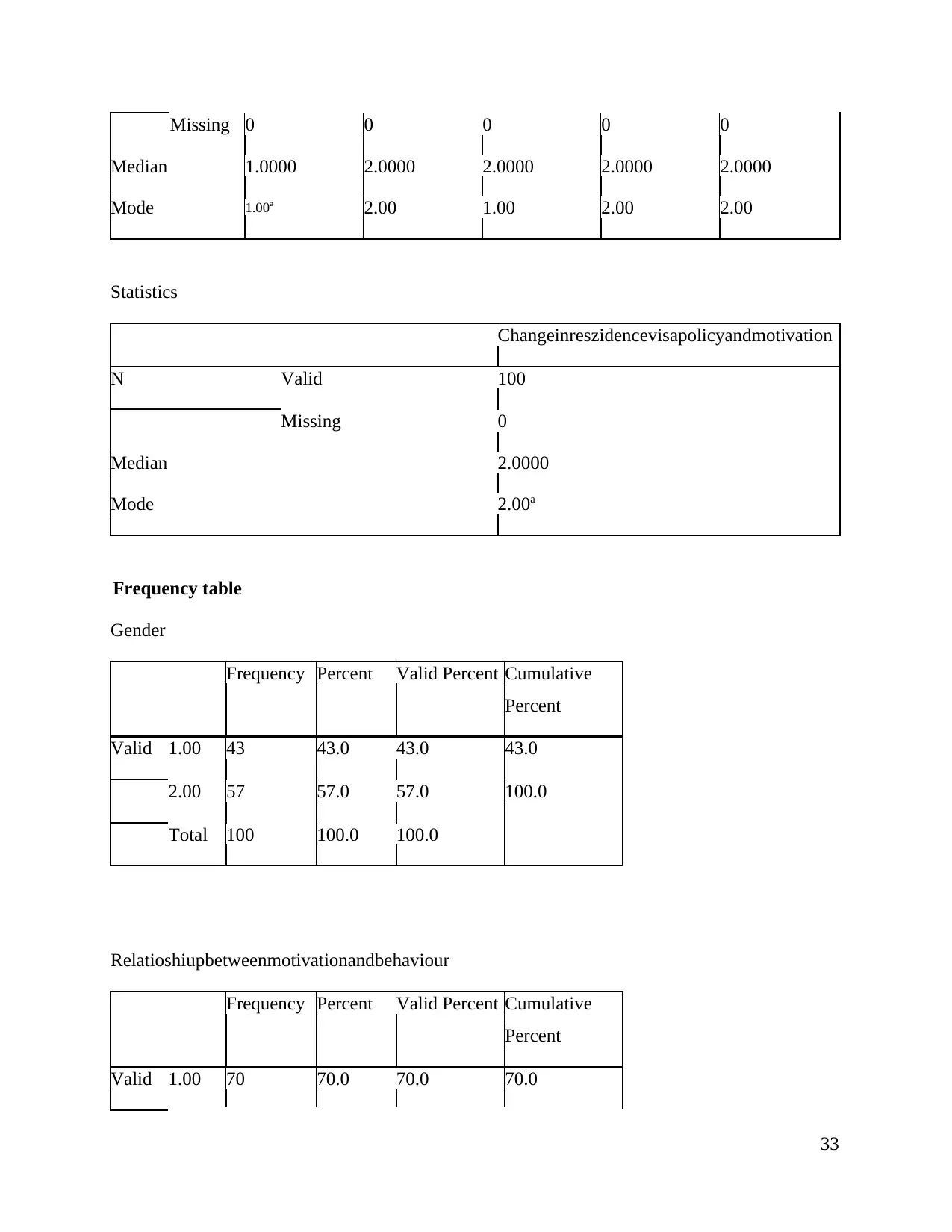
Missing 0 0 0 0 0
Median 1.0000 2.0000 2.0000 2.0000 2.0000
Mode 1.00a 2.00 1.00 2.00 2.00
Statistics
Changeinreszidencevisapolicyandmotivation
N Valid 100
Missing 0
Median 2.0000
Mode 2.00a
Frequency table
Gender
Frequency Percent Valid Percent Cumulative
Percent
Valid 1.00 43 43.0 43.0 43.0
2.00 57 57.0 57.0 100.0
Total 100 100.0 100.0
Relatioshiupbetweenmotivationandbehaviour
Frequency Percent Valid Percent Cumulative
Percent
Valid 1.00 70 70.0 70.0 70.0
33
Median 1.0000 2.0000 2.0000 2.0000 2.0000
Mode 1.00a 2.00 1.00 2.00 2.00
Statistics
Changeinreszidencevisapolicyandmotivation
N Valid 100
Missing 0
Median 2.0000
Mode 2.00a
Frequency table
Gender
Frequency Percent Valid Percent Cumulative
Percent
Valid 1.00 43 43.0 43.0 43.0
2.00 57 57.0 57.0 100.0
Total 100 100.0 100.0
Relatioshiupbetweenmotivationandbehaviour
Frequency Percent Valid Percent Cumulative
Percent
Valid 1.00 70 70.0 70.0 70.0
33
Paraphrase This Document
Need a fresh take? Get an instant paraphrase of this document with our AI Paraphraser
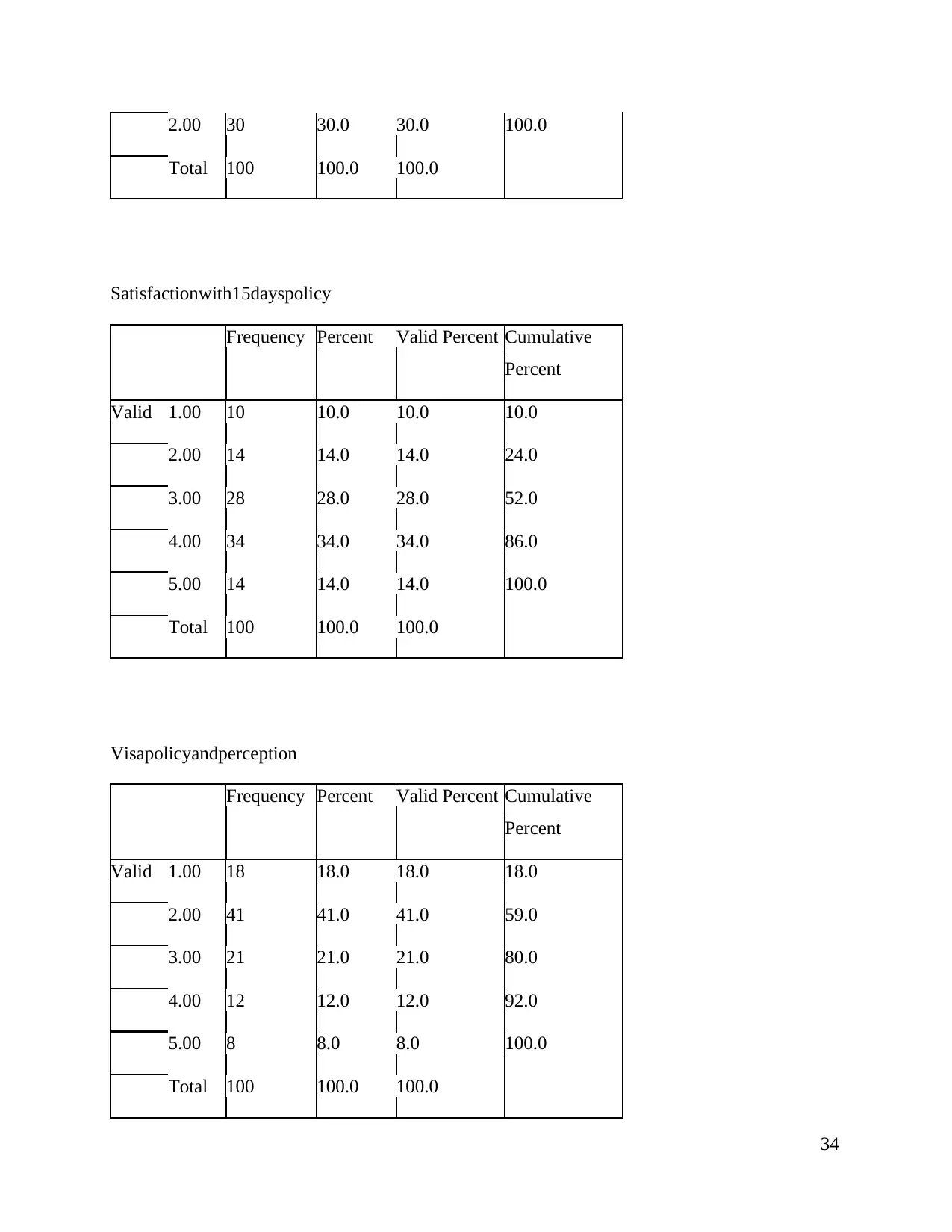
2.00 30 30.0 30.0 100.0
Total 100 100.0 100.0
Satisfactionwith15dayspolicy
Frequency Percent Valid Percent Cumulative
Percent
Valid 1.00 10 10.0 10.0 10.0
2.00 14 14.0 14.0 24.0
3.00 28 28.0 28.0 52.0
4.00 34 34.0 34.0 86.0
5.00 14 14.0 14.0 100.0
Total 100 100.0 100.0
Visapolicyandperception
Frequency Percent Valid Percent Cumulative
Percent
Valid 1.00 18 18.0 18.0 18.0
2.00 41 41.0 41.0 59.0
3.00 21 21.0 21.0 80.0
4.00 12 12.0 12.0 92.0
5.00 8 8.0 8.0 100.0
Total 100 100.0 100.0
34
Total 100 100.0 100.0
Satisfactionwith15dayspolicy
Frequency Percent Valid Percent Cumulative
Percent
Valid 1.00 10 10.0 10.0 10.0
2.00 14 14.0 14.0 24.0
3.00 28 28.0 28.0 52.0
4.00 34 34.0 34.0 86.0
5.00 14 14.0 14.0 100.0
Total 100 100.0 100.0
Visapolicyandperception
Frequency Percent Valid Percent Cumulative
Percent
Valid 1.00 18 18.0 18.0 18.0
2.00 41 41.0 41.0 59.0
3.00 21 21.0 21.0 80.0
4.00 12 12.0 12.0 92.0
5.00 8 8.0 8.0 100.0
Total 100 100.0 100.0
34
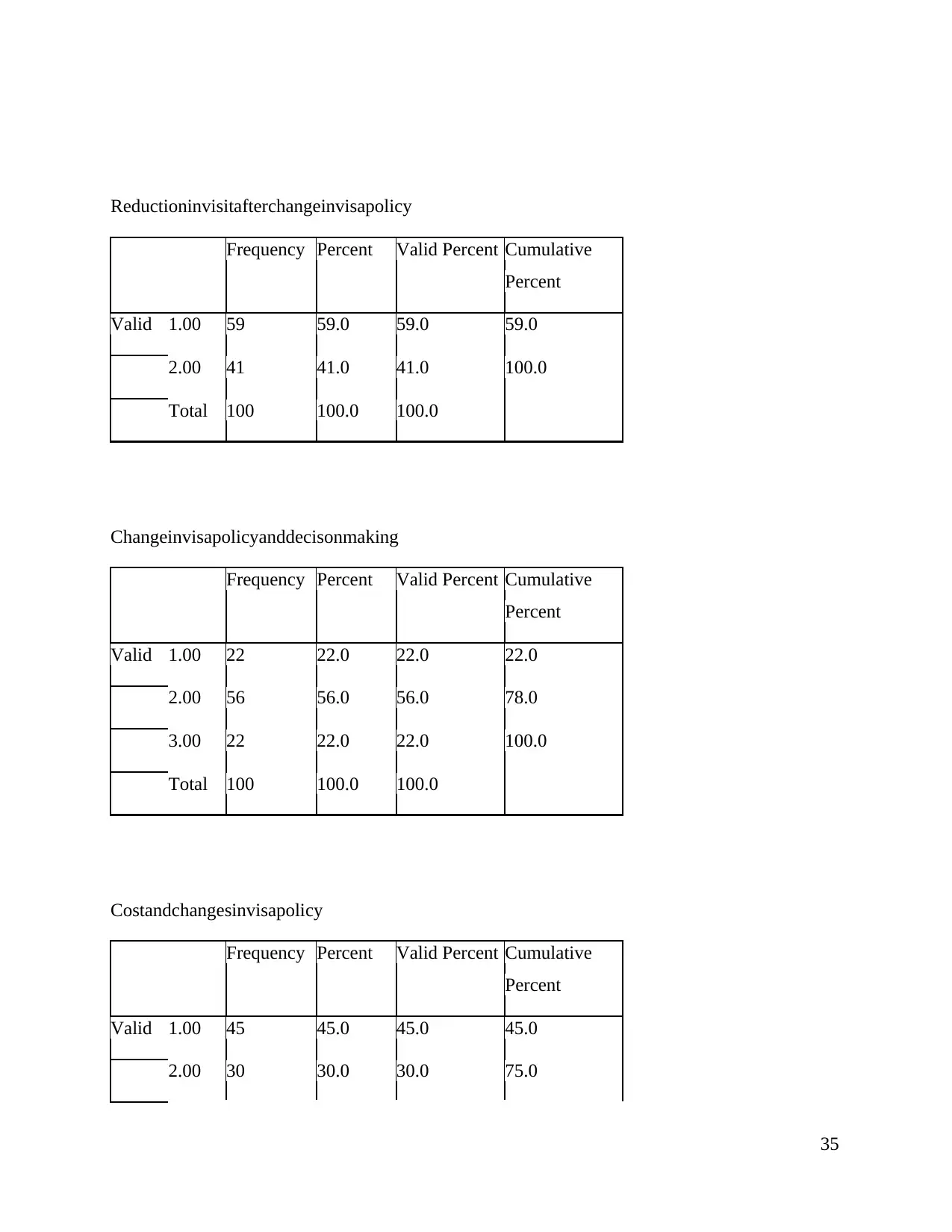
Reductioninvisitafterchangeinvisapolicy
Frequency Percent Valid Percent Cumulative
Percent
Valid 1.00 59 59.0 59.0 59.0
2.00 41 41.0 41.0 100.0
Total 100 100.0 100.0
Changeinvisapolicyanddecisonmaking
Frequency Percent Valid Percent Cumulative
Percent
Valid 1.00 22 22.0 22.0 22.0
2.00 56 56.0 56.0 78.0
3.00 22 22.0 22.0 100.0
Total 100 100.0 100.0
Costandchangesinvisapolicy
Frequency Percent Valid Percent Cumulative
Percent
Valid 1.00 45 45.0 45.0 45.0
2.00 30 30.0 30.0 75.0
35
Frequency Percent Valid Percent Cumulative
Percent
Valid 1.00 59 59.0 59.0 59.0
2.00 41 41.0 41.0 100.0
Total 100 100.0 100.0
Changeinvisapolicyanddecisonmaking
Frequency Percent Valid Percent Cumulative
Percent
Valid 1.00 22 22.0 22.0 22.0
2.00 56 56.0 56.0 78.0
3.00 22 22.0 22.0 100.0
Total 100 100.0 100.0
Costandchangesinvisapolicy
Frequency Percent Valid Percent Cumulative
Percent
Valid 1.00 45 45.0 45.0 45.0
2.00 30 30.0 30.0 75.0
35
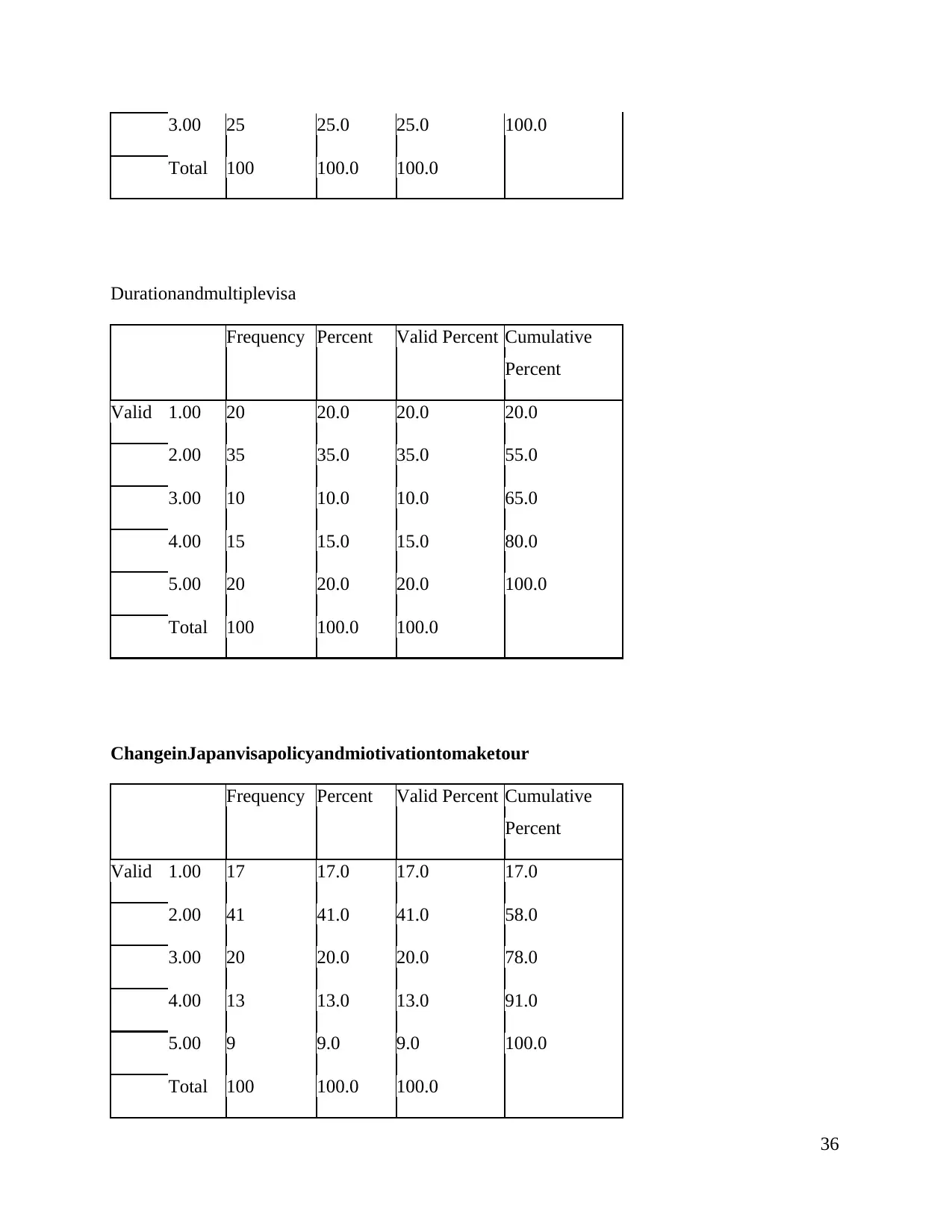
3.00 25 25.0 25.0 100.0
Total 100 100.0 100.0
Durationandmultiplevisa
Frequency Percent Valid Percent Cumulative
Percent
Valid 1.00 20 20.0 20.0 20.0
2.00 35 35.0 35.0 55.0
3.00 10 10.0 10.0 65.0
4.00 15 15.0 15.0 80.0
5.00 20 20.0 20.0 100.0
Total 100 100.0 100.0
ChangeinJapanvisapolicyandmiotivationtomaketour
Frequency Percent Valid Percent Cumulative
Percent
Valid 1.00 17 17.0 17.0 17.0
2.00 41 41.0 41.0 58.0
3.00 20 20.0 20.0 78.0
4.00 13 13.0 13.0 91.0
5.00 9 9.0 9.0 100.0
Total 100 100.0 100.0
36
Total 100 100.0 100.0
Durationandmultiplevisa
Frequency Percent Valid Percent Cumulative
Percent
Valid 1.00 20 20.0 20.0 20.0
2.00 35 35.0 35.0 55.0
3.00 10 10.0 10.0 65.0
4.00 15 15.0 15.0 80.0
5.00 20 20.0 20.0 100.0
Total 100 100.0 100.0
ChangeinJapanvisapolicyandmiotivationtomaketour
Frequency Percent Valid Percent Cumulative
Percent
Valid 1.00 17 17.0 17.0 17.0
2.00 41 41.0 41.0 58.0
3.00 20 20.0 20.0 78.0
4.00 13 13.0 13.0 91.0
5.00 9 9.0 9.0 100.0
Total 100 100.0 100.0
36
Secure Best Marks with AI Grader
Need help grading? Try our AI Grader for instant feedback on your assignments.
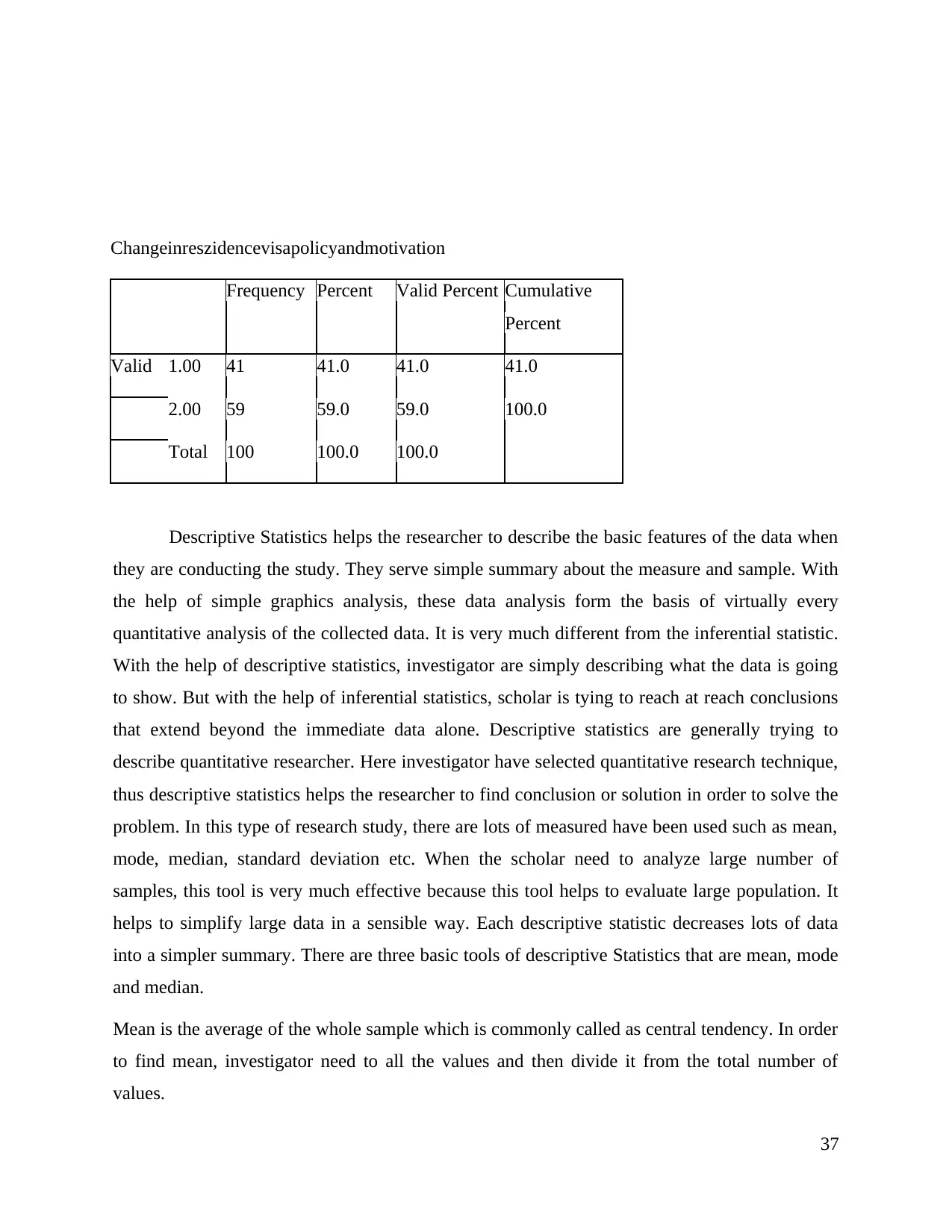
Changeinreszidencevisapolicyandmotivation
Frequency Percent Valid Percent Cumulative
Percent
Valid 1.00 41 41.0 41.0 41.0
2.00 59 59.0 59.0 100.0
Total 100 100.0 100.0
Descriptive Statistics helps the researcher to describe the basic features of the data when
they are conducting the study. They serve simple summary about the measure and sample. With
the help of simple graphics analysis, these data analysis form the basis of virtually every
quantitative analysis of the collected data. It is very much different from the inferential statistic.
With the help of descriptive statistics, investigator are simply describing what the data is going
to show. But with the help of inferential statistics, scholar is tying to reach at reach conclusions
that extend beyond the immediate data alone. Descriptive statistics are generally trying to
describe quantitative researcher. Here investigator have selected quantitative research technique,
thus descriptive statistics helps the researcher to find conclusion or solution in order to solve the
problem. In this type of research study, there are lots of measured have been used such as mean,
mode, median, standard deviation etc. When the scholar need to analyze large number of
samples, this tool is very much effective because this tool helps to evaluate large population. It
helps to simplify large data in a sensible way. Each descriptive statistic decreases lots of data
into a simpler summary. There are three basic tools of descriptive Statistics that are mean, mode
and median.
Mean is the average of the whole sample which is commonly called as central tendency. In order
to find mean, investigator need to all the values and then divide it from the total number of
values.
37
Frequency Percent Valid Percent Cumulative
Percent
Valid 1.00 41 41.0 41.0 41.0
2.00 59 59.0 59.0 100.0
Total 100 100.0 100.0
Descriptive Statistics helps the researcher to describe the basic features of the data when
they are conducting the study. They serve simple summary about the measure and sample. With
the help of simple graphics analysis, these data analysis form the basis of virtually every
quantitative analysis of the collected data. It is very much different from the inferential statistic.
With the help of descriptive statistics, investigator are simply describing what the data is going
to show. But with the help of inferential statistics, scholar is tying to reach at reach conclusions
that extend beyond the immediate data alone. Descriptive statistics are generally trying to
describe quantitative researcher. Here investigator have selected quantitative research technique,
thus descriptive statistics helps the researcher to find conclusion or solution in order to solve the
problem. In this type of research study, there are lots of measured have been used such as mean,
mode, median, standard deviation etc. When the scholar need to analyze large number of
samples, this tool is very much effective because this tool helps to evaluate large population. It
helps to simplify large data in a sensible way. Each descriptive statistic decreases lots of data
into a simpler summary. There are three basic tools of descriptive Statistics that are mean, mode
and median.
Mean is the average of the whole sample which is commonly called as central tendency. In order
to find mean, investigator need to all the values and then divide it from the total number of
values.
37
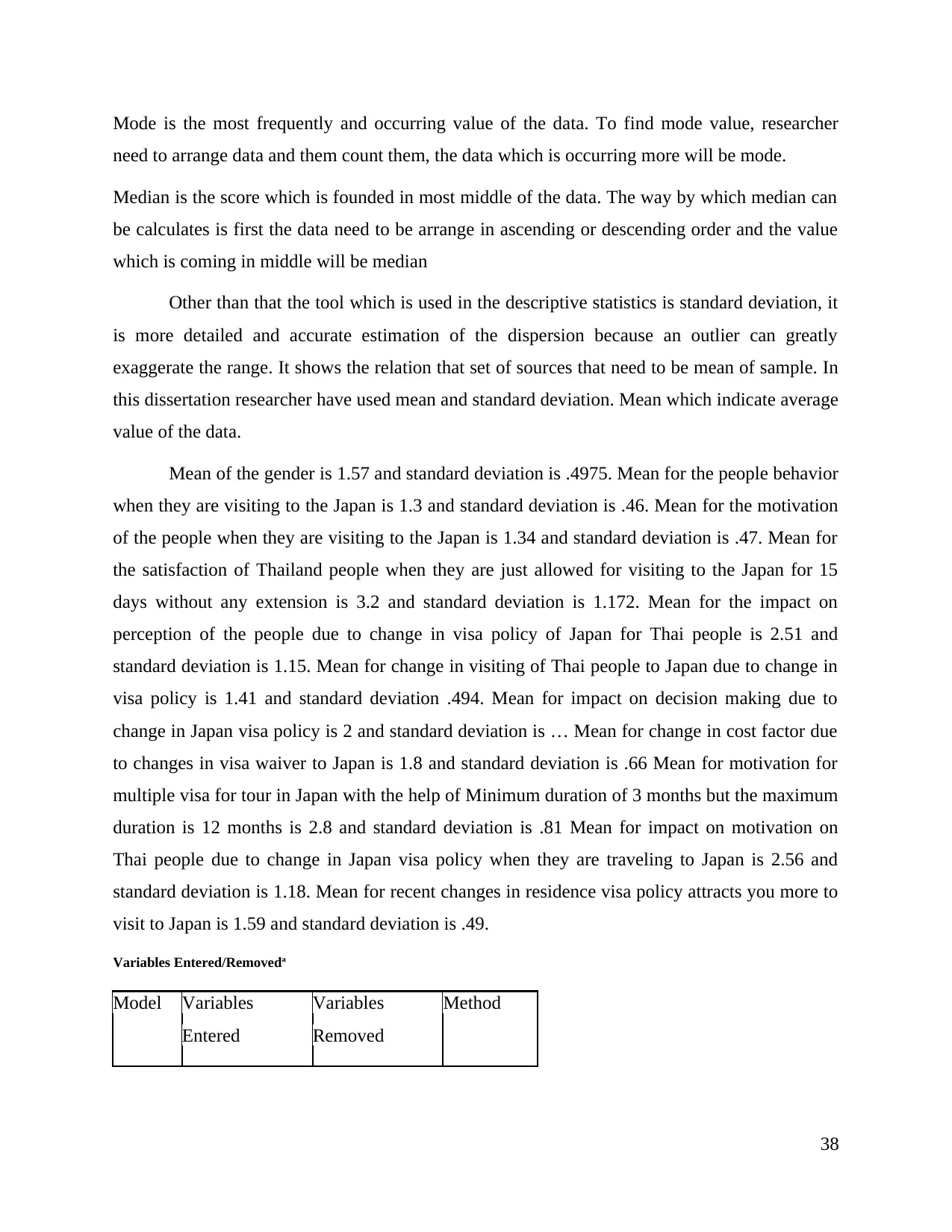
Mode is the most frequently and occurring value of the data. To find mode value, researcher
need to arrange data and them count them, the data which is occurring more will be mode.
Median is the score which is founded in most middle of the data. The way by which median can
be calculates is first the data need to be arrange in ascending or descending order and the value
which is coming in middle will be median
Other than that the tool which is used in the descriptive statistics is standard deviation, it
is more detailed and accurate estimation of the dispersion because an outlier can greatly
exaggerate the range. It shows the relation that set of sources that need to be mean of sample. In
this dissertation researcher have used mean and standard deviation. Mean which indicate average
value of the data.
Mean of the gender is 1.57 and standard deviation is .4975. Mean for the people behavior
when they are visiting to the Japan is 1.3 and standard deviation is .46. Mean for the motivation
of the people when they are visiting to the Japan is 1.34 and standard deviation is .47. Mean for
the satisfaction of Thailand people when they are just allowed for visiting to the Japan for 15
days without any extension is 3.2 and standard deviation is 1.172. Mean for the impact on
perception of the people due to change in visa policy of Japan for Thai people is 2.51 and
standard deviation is 1.15. Mean for change in visiting of Thai people to Japan due to change in
visa policy is 1.41 and standard deviation .494. Mean for impact on decision making due to
change in Japan visa policy is 2 and standard deviation is … Mean for change in cost factor due
to changes in visa waiver to Japan is 1.8 and standard deviation is .66 Mean for motivation for
multiple visa for tour in Japan with the help of Minimum duration of 3 months but the maximum
duration is 12 months is 2.8 and standard deviation is .81 Mean for impact on motivation on
Thai people due to change in Japan visa policy when they are traveling to Japan is 2.56 and
standard deviation is 1.18. Mean for recent changes in residence visa policy attracts you more to
visit to Japan is 1.59 and standard deviation is .49.
Variables Entered/Removeda
Model Variables
Entered
Variables
Removed
Method
38
need to arrange data and them count them, the data which is occurring more will be mode.
Median is the score which is founded in most middle of the data. The way by which median can
be calculates is first the data need to be arrange in ascending or descending order and the value
which is coming in middle will be median
Other than that the tool which is used in the descriptive statistics is standard deviation, it
is more detailed and accurate estimation of the dispersion because an outlier can greatly
exaggerate the range. It shows the relation that set of sources that need to be mean of sample. In
this dissertation researcher have used mean and standard deviation. Mean which indicate average
value of the data.
Mean of the gender is 1.57 and standard deviation is .4975. Mean for the people behavior
when they are visiting to the Japan is 1.3 and standard deviation is .46. Mean for the motivation
of the people when they are visiting to the Japan is 1.34 and standard deviation is .47. Mean for
the satisfaction of Thailand people when they are just allowed for visiting to the Japan for 15
days without any extension is 3.2 and standard deviation is 1.172. Mean for the impact on
perception of the people due to change in visa policy of Japan for Thai people is 2.51 and
standard deviation is 1.15. Mean for change in visiting of Thai people to Japan due to change in
visa policy is 1.41 and standard deviation .494. Mean for impact on decision making due to
change in Japan visa policy is 2 and standard deviation is … Mean for change in cost factor due
to changes in visa waiver to Japan is 1.8 and standard deviation is .66 Mean for motivation for
multiple visa for tour in Japan with the help of Minimum duration of 3 months but the maximum
duration is 12 months is 2.8 and standard deviation is .81 Mean for impact on motivation on
Thai people due to change in Japan visa policy when they are traveling to Japan is 2.56 and
standard deviation is 1.18. Mean for recent changes in residence visa policy attracts you more to
visit to Japan is 1.59 and standard deviation is .49.
Variables Entered/Removeda
Model Variables
Entered
Variables
Removed
Method
38
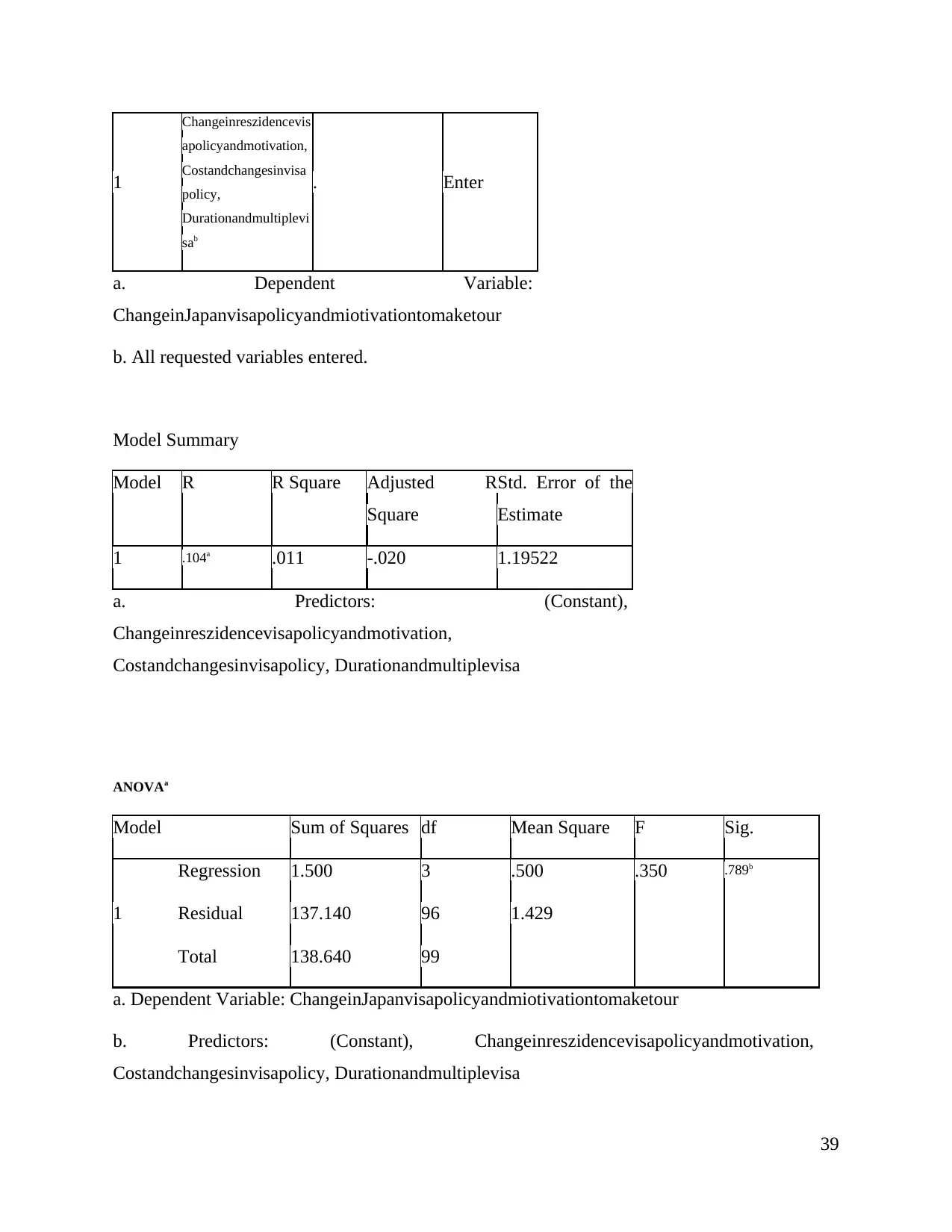
1
Changeinreszidencevis
apolicyandmotivation,
Costandchangesinvisa
policy,
Durationandmultiplevi
sab
. Enter
a. Dependent Variable:
ChangeinJapanvisapolicyandmiotivationtomaketour
b. All requested variables entered.
Model Summary
Model R R Square Adjusted R
Square
Std. Error of the
Estimate
1 .104a .011 -.020 1.19522
a. Predictors: (Constant),
Changeinreszidencevisapolicyandmotivation,
Costandchangesinvisapolicy, Durationandmultiplevisa
ANOVAa
Model Sum of Squares df Mean Square F Sig.
1
Regression 1.500 3 .500 .350 .789b
Residual 137.140 96 1.429
Total 138.640 99
a. Dependent Variable: ChangeinJapanvisapolicyandmiotivationtomaketour
b. Predictors: (Constant), Changeinreszidencevisapolicyandmotivation,
Costandchangesinvisapolicy, Durationandmultiplevisa
39
Changeinreszidencevis
apolicyandmotivation,
Costandchangesinvisa
policy,
Durationandmultiplevi
sab
. Enter
a. Dependent Variable:
ChangeinJapanvisapolicyandmiotivationtomaketour
b. All requested variables entered.
Model Summary
Model R R Square Adjusted R
Square
Std. Error of the
Estimate
1 .104a .011 -.020 1.19522
a. Predictors: (Constant),
Changeinreszidencevisapolicyandmotivation,
Costandchangesinvisapolicy, Durationandmultiplevisa
ANOVAa
Model Sum of Squares df Mean Square F Sig.
1
Regression 1.500 3 .500 .350 .789b
Residual 137.140 96 1.429
Total 138.640 99
a. Dependent Variable: ChangeinJapanvisapolicyandmiotivationtomaketour
b. Predictors: (Constant), Changeinreszidencevisapolicyandmotivation,
Costandchangesinvisapolicy, Durationandmultiplevisa
39
Paraphrase This Document
Need a fresh take? Get an instant paraphrase of this document with our AI Paraphraser
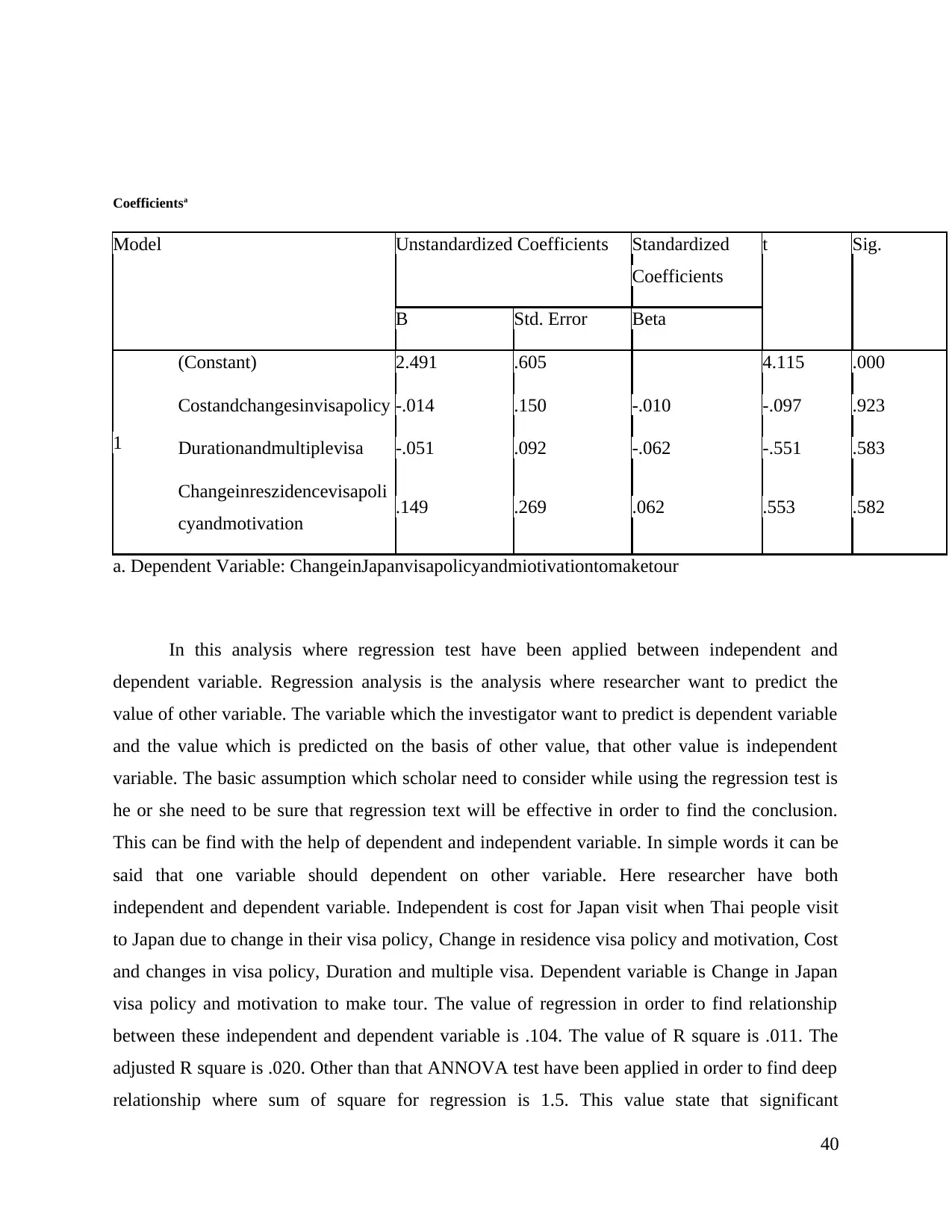
Coefficientsa
Model Unstandardized Coefficients Standardized
Coefficients
t Sig.
B Std. Error Beta
1
(Constant) 2.491 .605 4.115 .000
Costandchangesinvisapolicy -.014 .150 -.010 -.097 .923
Durationandmultiplevisa -.051 .092 -.062 -.551 .583
Changeinreszidencevisapoli
cyandmotivation .149 .269 .062 .553 .582
a. Dependent Variable: ChangeinJapanvisapolicyandmiotivationtomaketour
In this analysis where regression test have been applied between independent and
dependent variable. Regression analysis is the analysis where researcher want to predict the
value of other variable. The variable which the investigator want to predict is dependent variable
and the value which is predicted on the basis of other value, that other value is independent
variable. The basic assumption which scholar need to consider while using the regression test is
he or she need to be sure that regression text will be effective in order to find the conclusion.
This can be find with the help of dependent and independent variable. In simple words it can be
said that one variable should dependent on other variable. Here researcher have both
independent and dependent variable. Independent is cost for Japan visit when Thai people visit
to Japan due to change in their visa policy, Change in residence visa policy and motivation, Cost
and changes in visa policy, Duration and multiple visa. Dependent variable is Change in Japan
visa policy and motivation to make tour. The value of regression in order to find relationship
between these independent and dependent variable is .104. The value of R square is .011. The
adjusted R square is .020. Other than that ANNOVA test have been applied in order to find deep
relationship where sum of square for regression is 1.5. This value state that significant
40
Model Unstandardized Coefficients Standardized
Coefficients
t Sig.
B Std. Error Beta
1
(Constant) 2.491 .605 4.115 .000
Costandchangesinvisapolicy -.014 .150 -.010 -.097 .923
Durationandmultiplevisa -.051 .092 -.062 -.551 .583
Changeinreszidencevisapoli
cyandmotivation .149 .269 .062 .553 .582
a. Dependent Variable: ChangeinJapanvisapolicyandmiotivationtomaketour
In this analysis where regression test have been applied between independent and
dependent variable. Regression analysis is the analysis where researcher want to predict the
value of other variable. The variable which the investigator want to predict is dependent variable
and the value which is predicted on the basis of other value, that other value is independent
variable. The basic assumption which scholar need to consider while using the regression test is
he or she need to be sure that regression text will be effective in order to find the conclusion.
This can be find with the help of dependent and independent variable. In simple words it can be
said that one variable should dependent on other variable. Here researcher have both
independent and dependent variable. Independent is cost for Japan visit when Thai people visit
to Japan due to change in their visa policy, Change in residence visa policy and motivation, Cost
and changes in visa policy, Duration and multiple visa. Dependent variable is Change in Japan
visa policy and motivation to make tour. The value of regression in order to find relationship
between these independent and dependent variable is .104. The value of R square is .011. The
adjusted R square is .020. Other than that ANNOVA test have been applied in order to find deep
relationship where sum of square for regression is 1.5. This value state that significant
40
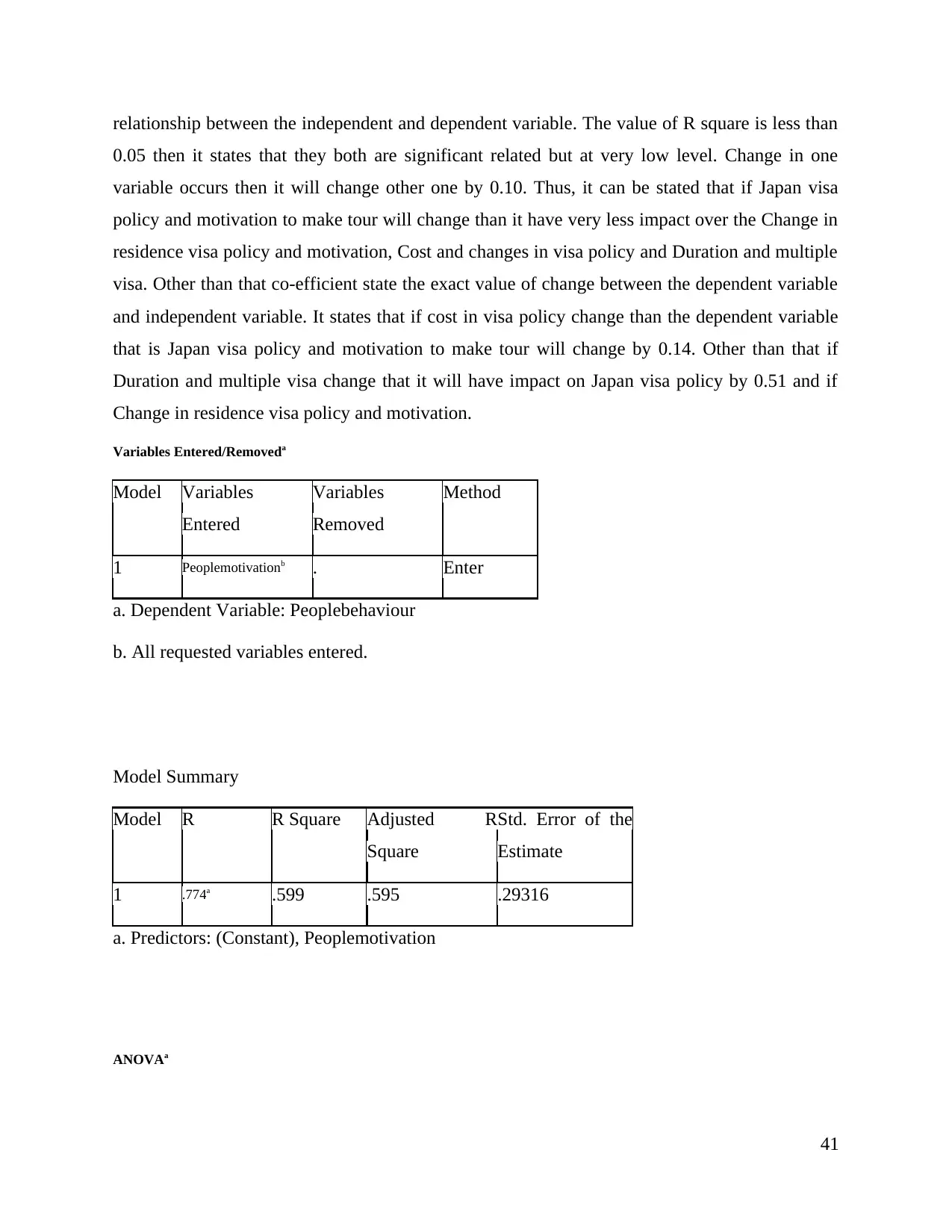
relationship between the independent and dependent variable. The value of R square is less than
0.05 then it states that they both are significant related but at very low level. Change in one
variable occurs then it will change other one by 0.10. Thus, it can be stated that if Japan visa
policy and motivation to make tour will change than it have very less impact over the Change in
residence visa policy and motivation, Cost and changes in visa policy and Duration and multiple
visa. Other than that co-efficient state the exact value of change between the dependent variable
and independent variable. It states that if cost in visa policy change than the dependent variable
that is Japan visa policy and motivation to make tour will change by 0.14. Other than that if
Duration and multiple visa change that it will have impact on Japan visa policy by 0.51 and if
Change in residence visa policy and motivation.
Variables Entered/Removeda
Model Variables
Entered
Variables
Removed
Method
1 Peoplemotivationb . Enter
a. Dependent Variable: Peoplebehaviour
b. All requested variables entered.
Model Summary
Model R R Square Adjusted R
Square
Std. Error of the
Estimate
1 .774a .599 .595 .29316
a. Predictors: (Constant), Peoplemotivation
ANOVAa
41
0.05 then it states that they both are significant related but at very low level. Change in one
variable occurs then it will change other one by 0.10. Thus, it can be stated that if Japan visa
policy and motivation to make tour will change than it have very less impact over the Change in
residence visa policy and motivation, Cost and changes in visa policy and Duration and multiple
visa. Other than that co-efficient state the exact value of change between the dependent variable
and independent variable. It states that if cost in visa policy change than the dependent variable
that is Japan visa policy and motivation to make tour will change by 0.14. Other than that if
Duration and multiple visa change that it will have impact on Japan visa policy by 0.51 and if
Change in residence visa policy and motivation.
Variables Entered/Removeda
Model Variables
Entered
Variables
Removed
Method
1 Peoplemotivationb . Enter
a. Dependent Variable: Peoplebehaviour
b. All requested variables entered.
Model Summary
Model R R Square Adjusted R
Square
Std. Error of the
Estimate
1 .774a .599 .595 .29316
a. Predictors: (Constant), Peoplemotivation
ANOVAa
41
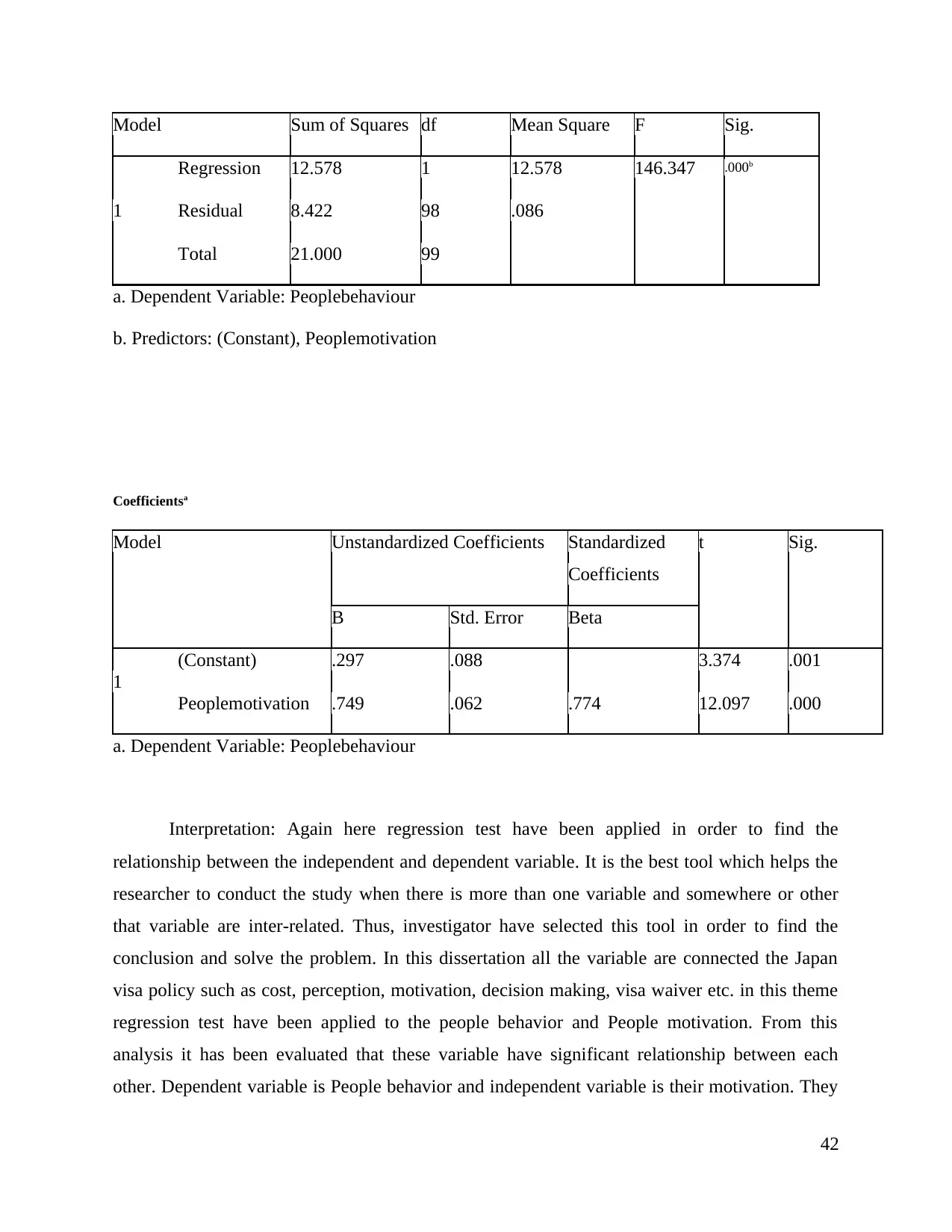
Model Sum of Squares df Mean Square F Sig.
1
Regression 12.578 1 12.578 146.347 .000b
Residual 8.422 98 .086
Total 21.000 99
a. Dependent Variable: Peoplebehaviour
b. Predictors: (Constant), Peoplemotivation
Coefficientsa
Model Unstandardized Coefficients Standardized
Coefficients
t Sig.
B Std. Error Beta
1
(Constant) .297 .088 3.374 .001
Peoplemotivation .749 .062 .774 12.097 .000
a. Dependent Variable: Peoplebehaviour
Interpretation: Again here regression test have been applied in order to find the
relationship between the independent and dependent variable. It is the best tool which helps the
researcher to conduct the study when there is more than one variable and somewhere or other
that variable are inter-related. Thus, investigator have selected this tool in order to find the
conclusion and solve the problem. In this dissertation all the variable are connected the Japan
visa policy such as cost, perception, motivation, decision making, visa waiver etc. in this theme
regression test have been applied to the people behavior and People motivation. From this
analysis it has been evaluated that these variable have significant relationship between each
other. Dependent variable is People behavior and independent variable is their motivation. They
42
1
Regression 12.578 1 12.578 146.347 .000b
Residual 8.422 98 .086
Total 21.000 99
a. Dependent Variable: Peoplebehaviour
b. Predictors: (Constant), Peoplemotivation
Coefficientsa
Model Unstandardized Coefficients Standardized
Coefficients
t Sig.
B Std. Error Beta
1
(Constant) .297 .088 3.374 .001
Peoplemotivation .749 .062 .774 12.097 .000
a. Dependent Variable: Peoplebehaviour
Interpretation: Again here regression test have been applied in order to find the
relationship between the independent and dependent variable. It is the best tool which helps the
researcher to conduct the study when there is more than one variable and somewhere or other
that variable are inter-related. Thus, investigator have selected this tool in order to find the
conclusion and solve the problem. In this dissertation all the variable are connected the Japan
visa policy such as cost, perception, motivation, decision making, visa waiver etc. in this theme
regression test have been applied to the people behavior and People motivation. From this
analysis it has been evaluated that these variable have significant relationship between each
other. Dependent variable is People behavior and independent variable is their motivation. They
42
Secure Best Marks with AI Grader
Need help grading? Try our AI Grader for instant feedback on your assignments.
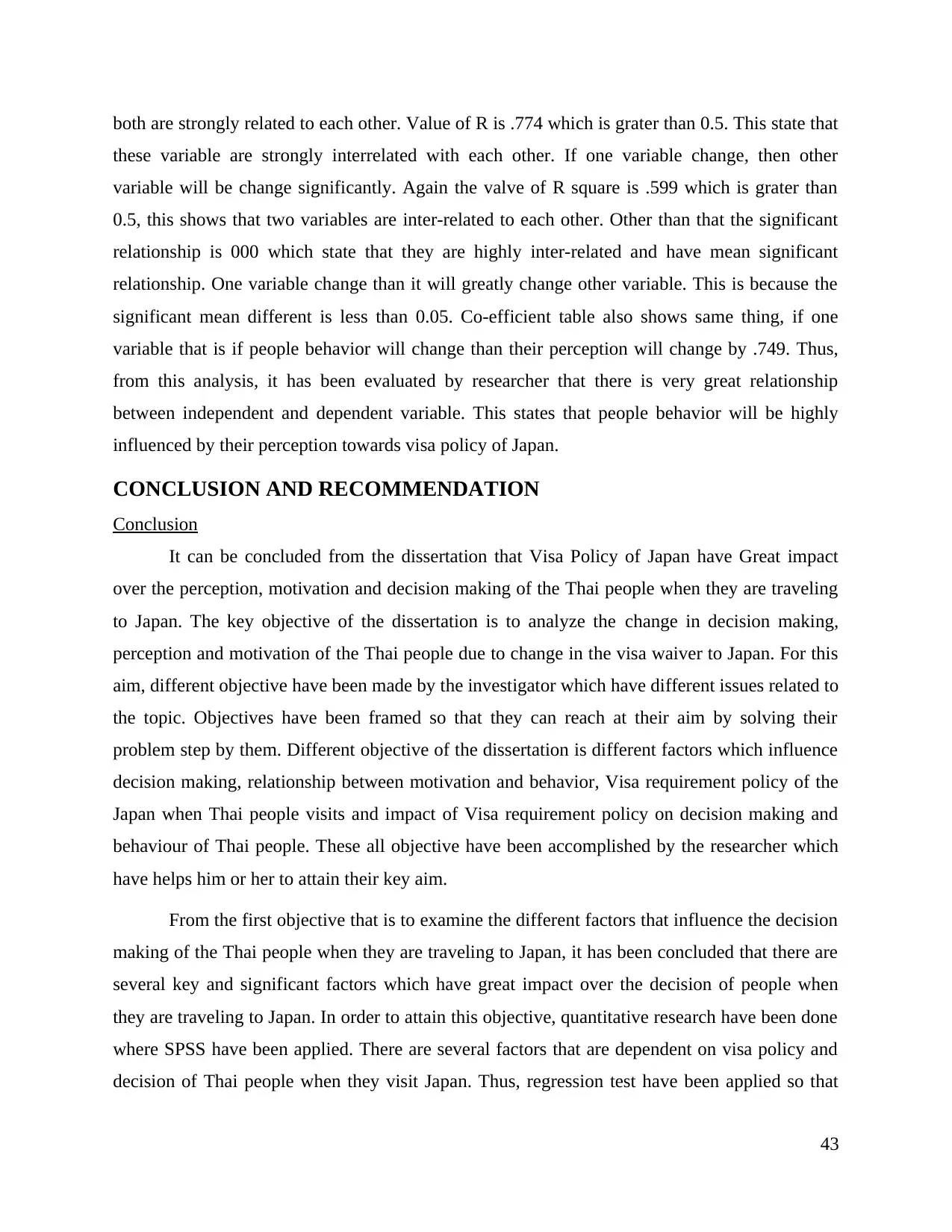
both are strongly related to each other. Value of R is .774 which is grater than 0.5. This state that
these variable are strongly interrelated with each other. If one variable change, then other
variable will be change significantly. Again the valve of R square is .599 which is grater than
0.5, this shows that two variables are inter-related to each other. Other than that the significant
relationship is 000 which state that they are highly inter-related and have mean significant
relationship. One variable change than it will greatly change other variable. This is because the
significant mean different is less than 0.05. Co-efficient table also shows same thing, if one
variable that is if people behavior will change than their perception will change by .749. Thus,
from this analysis, it has been evaluated by researcher that there is very great relationship
between independent and dependent variable. This states that people behavior will be highly
influenced by their perception towards visa policy of Japan.
CONCLUSION AND RECOMMENDATION
Conclusion
It can be concluded from the dissertation that Visa Policy of Japan have Great impact
over the perception, motivation and decision making of the Thai people when they are traveling
to Japan. The key objective of the dissertation is to analyze the change in decision making,
perception and motivation of the Thai people due to change in the visa waiver to Japan. For this
aim, different objective have been made by the investigator which have different issues related to
the topic. Objectives have been framed so that they can reach at their aim by solving their
problem step by them. Different objective of the dissertation is different factors which influence
decision making, relationship between motivation and behavior, Visa requirement policy of the
Japan when Thai people visits and impact of Visa requirement policy on decision making and
behaviour of Thai people. These all objective have been accomplished by the researcher which
have helps him or her to attain their key aim.
From the first objective that is to examine the different factors that influence the decision
making of the Thai people when they are traveling to Japan, it has been concluded that there are
several key and significant factors which have great impact over the decision of people when
they are traveling to Japan. In order to attain this objective, quantitative research have been done
where SPSS have been applied. There are several factors that are dependent on visa policy and
decision of Thai people when they visit Japan. Thus, regression test have been applied so that
43
these variable are strongly interrelated with each other. If one variable change, then other
variable will be change significantly. Again the valve of R square is .599 which is grater than
0.5, this shows that two variables are inter-related to each other. Other than that the significant
relationship is 000 which state that they are highly inter-related and have mean significant
relationship. One variable change than it will greatly change other variable. This is because the
significant mean different is less than 0.05. Co-efficient table also shows same thing, if one
variable that is if people behavior will change than their perception will change by .749. Thus,
from this analysis, it has been evaluated by researcher that there is very great relationship
between independent and dependent variable. This states that people behavior will be highly
influenced by their perception towards visa policy of Japan.
CONCLUSION AND RECOMMENDATION
Conclusion
It can be concluded from the dissertation that Visa Policy of Japan have Great impact
over the perception, motivation and decision making of the Thai people when they are traveling
to Japan. The key objective of the dissertation is to analyze the change in decision making,
perception and motivation of the Thai people due to change in the visa waiver to Japan. For this
aim, different objective have been made by the investigator which have different issues related to
the topic. Objectives have been framed so that they can reach at their aim by solving their
problem step by them. Different objective of the dissertation is different factors which influence
decision making, relationship between motivation and behavior, Visa requirement policy of the
Japan when Thai people visits and impact of Visa requirement policy on decision making and
behaviour of Thai people. These all objective have been accomplished by the researcher which
have helps him or her to attain their key aim.
From the first objective that is to examine the different factors that influence the decision
making of the Thai people when they are traveling to Japan, it has been concluded that there are
several key and significant factors which have great impact over the decision of people when
they are traveling to Japan. In order to attain this objective, quantitative research have been done
where SPSS have been applied. There are several factors that are dependent on visa policy and
decision of Thai people when they visit Japan. Thus, regression test have been applied so that
43
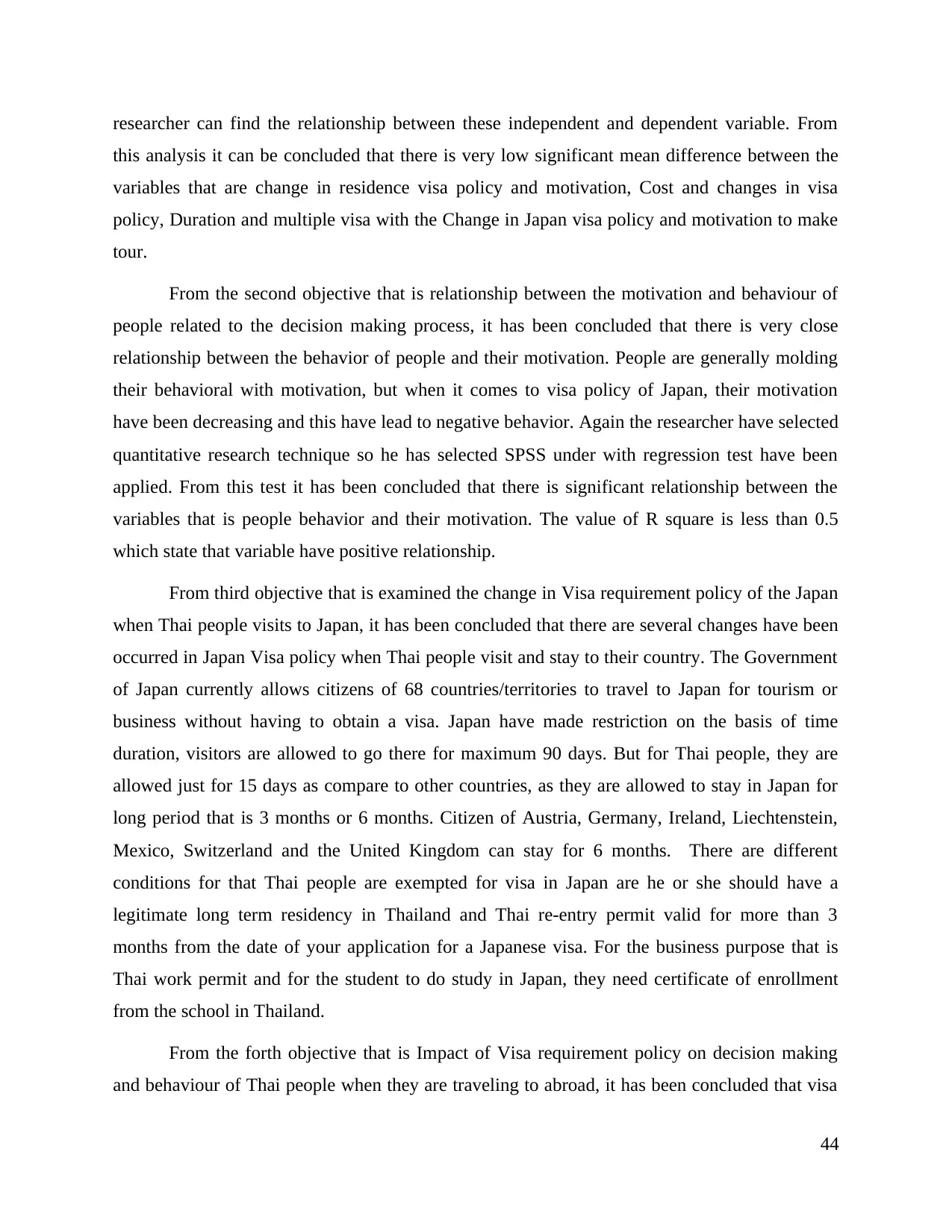
researcher can find the relationship between these independent and dependent variable. From
this analysis it can be concluded that there is very low significant mean difference between the
variables that are change in residence visa policy and motivation, Cost and changes in visa
policy, Duration and multiple visa with the Change in Japan visa policy and motivation to make
tour.
From the second objective that is relationship between the motivation and behaviour of
people related to the decision making process, it has been concluded that there is very close
relationship between the behavior of people and their motivation. People are generally molding
their behavioral with motivation, but when it comes to visa policy of Japan, their motivation
have been decreasing and this have lead to negative behavior. Again the researcher have selected
quantitative research technique so he has selected SPSS under with regression test have been
applied. From this test it has been concluded that there is significant relationship between the
variables that is people behavior and their motivation. The value of R square is less than 0.5
which state that variable have positive relationship.
From third objective that is examined the change in Visa requirement policy of the Japan
when Thai people visits to Japan, it has been concluded that there are several changes have been
occurred in Japan Visa policy when Thai people visit and stay to their country. The Government
of Japan currently allows citizens of 68 countries/territories to travel to Japan for tourism or
business without having to obtain a visa. Japan have made restriction on the basis of time
duration, visitors are allowed to go there for maximum 90 days. But for Thai people, they are
allowed just for 15 days as compare to other countries, as they are allowed to stay in Japan for
long period that is 3 months or 6 months. Citizen of Austria, Germany, Ireland, Liechtenstein,
Mexico, Switzerland and the United Kingdom can stay for 6 months. There are different
conditions for that Thai people are exempted for visa in Japan are he or she should have a
legitimate long term residency in Thailand and Thai re-entry permit valid for more than 3
months from the date of your application for a Japanese visa. For the business purpose that is
Thai work permit and for the student to do study in Japan, they need certificate of enrollment
from the school in Thailand.
From the forth objective that is Impact of Visa requirement policy on decision making
and behaviour of Thai people when they are traveling to abroad, it has been concluded that visa
44
this analysis it can be concluded that there is very low significant mean difference between the
variables that are change in residence visa policy and motivation, Cost and changes in visa
policy, Duration and multiple visa with the Change in Japan visa policy and motivation to make
tour.
From the second objective that is relationship between the motivation and behaviour of
people related to the decision making process, it has been concluded that there is very close
relationship between the behavior of people and their motivation. People are generally molding
their behavioral with motivation, but when it comes to visa policy of Japan, their motivation
have been decreasing and this have lead to negative behavior. Again the researcher have selected
quantitative research technique so he has selected SPSS under with regression test have been
applied. From this test it has been concluded that there is significant relationship between the
variables that is people behavior and their motivation. The value of R square is less than 0.5
which state that variable have positive relationship.
From third objective that is examined the change in Visa requirement policy of the Japan
when Thai people visits to Japan, it has been concluded that there are several changes have been
occurred in Japan Visa policy when Thai people visit and stay to their country. The Government
of Japan currently allows citizens of 68 countries/territories to travel to Japan for tourism or
business without having to obtain a visa. Japan have made restriction on the basis of time
duration, visitors are allowed to go there for maximum 90 days. But for Thai people, they are
allowed just for 15 days as compare to other countries, as they are allowed to stay in Japan for
long period that is 3 months or 6 months. Citizen of Austria, Germany, Ireland, Liechtenstein,
Mexico, Switzerland and the United Kingdom can stay for 6 months. There are different
conditions for that Thai people are exempted for visa in Japan are he or she should have a
legitimate long term residency in Thailand and Thai re-entry permit valid for more than 3
months from the date of your application for a Japanese visa. For the business purpose that is
Thai work permit and for the student to do study in Japan, they need certificate of enrollment
from the school in Thailand.
From the forth objective that is Impact of Visa requirement policy on decision making
and behaviour of Thai people when they are traveling to abroad, it has been concluded that visa
44
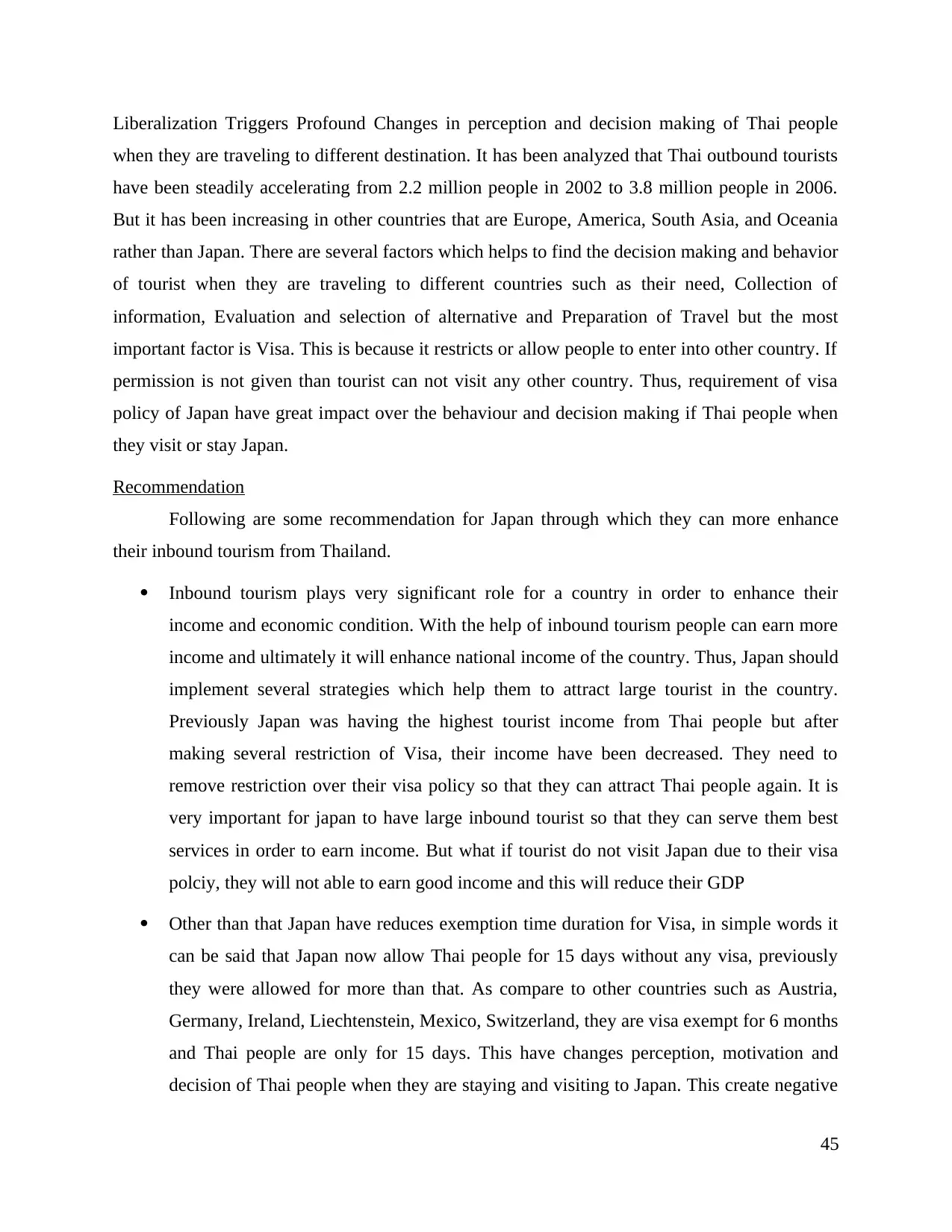
Liberalization Triggers Profound Changes in perception and decision making of Thai people
when they are traveling to different destination. It has been analyzed that Thai outbound tourists
have been steadily accelerating from 2.2 million people in 2002 to 3.8 million people in 2006.
But it has been increasing in other countries that are Europe, America, South Asia, and Oceania
rather than Japan. There are several factors which helps to find the decision making and behavior
of tourist when they are traveling to different countries such as their need, Collection of
information, Evaluation and selection of alternative and Preparation of Travel but the most
important factor is Visa. This is because it restricts or allow people to enter into other country. If
permission is not given than tourist can not visit any other country. Thus, requirement of visa
policy of Japan have great impact over the behaviour and decision making if Thai people when
they visit or stay Japan.
Recommendation
Following are some recommendation for Japan through which they can more enhance
their inbound tourism from Thailand.
Inbound tourism plays very significant role for a country in order to enhance their
income and economic condition. With the help of inbound tourism people can earn more
income and ultimately it will enhance national income of the country. Thus, Japan should
implement several strategies which help them to attract large tourist in the country.
Previously Japan was having the highest tourist income from Thai people but after
making several restriction of Visa, their income have been decreased. They need to
remove restriction over their visa policy so that they can attract Thai people again. It is
very important for japan to have large inbound tourist so that they can serve them best
services in order to earn income. But what if tourist do not visit Japan due to their visa
polciy, they will not able to earn good income and this will reduce their GDP
Other than that Japan have reduces exemption time duration for Visa, in simple words it
can be said that Japan now allow Thai people for 15 days without any visa, previously
they were allowed for more than that. As compare to other countries such as Austria,
Germany, Ireland, Liechtenstein, Mexico, Switzerland, they are visa exempt for 6 months
and Thai people are only for 15 days. This have changes perception, motivation and
decision of Thai people when they are staying and visiting to Japan. This create negative
45
when they are traveling to different destination. It has been analyzed that Thai outbound tourists
have been steadily accelerating from 2.2 million people in 2002 to 3.8 million people in 2006.
But it has been increasing in other countries that are Europe, America, South Asia, and Oceania
rather than Japan. There are several factors which helps to find the decision making and behavior
of tourist when they are traveling to different countries such as their need, Collection of
information, Evaluation and selection of alternative and Preparation of Travel but the most
important factor is Visa. This is because it restricts or allow people to enter into other country. If
permission is not given than tourist can not visit any other country. Thus, requirement of visa
policy of Japan have great impact over the behaviour and decision making if Thai people when
they visit or stay Japan.
Recommendation
Following are some recommendation for Japan through which they can more enhance
their inbound tourism from Thailand.
Inbound tourism plays very significant role for a country in order to enhance their
income and economic condition. With the help of inbound tourism people can earn more
income and ultimately it will enhance national income of the country. Thus, Japan should
implement several strategies which help them to attract large tourist in the country.
Previously Japan was having the highest tourist income from Thai people but after
making several restriction of Visa, their income have been decreased. They need to
remove restriction over their visa policy so that they can attract Thai people again. It is
very important for japan to have large inbound tourist so that they can serve them best
services in order to earn income. But what if tourist do not visit Japan due to their visa
polciy, they will not able to earn good income and this will reduce their GDP
Other than that Japan have reduces exemption time duration for Visa, in simple words it
can be said that Japan now allow Thai people for 15 days without any visa, previously
they were allowed for more than that. As compare to other countries such as Austria,
Germany, Ireland, Liechtenstein, Mexico, Switzerland, they are visa exempt for 6 months
and Thai people are only for 15 days. This have changes perception, motivation and
decision of Thai people when they are staying and visiting to Japan. This create negative
45
Paraphrase This Document
Need a fresh take? Get an instant paraphrase of this document with our AI Paraphraser
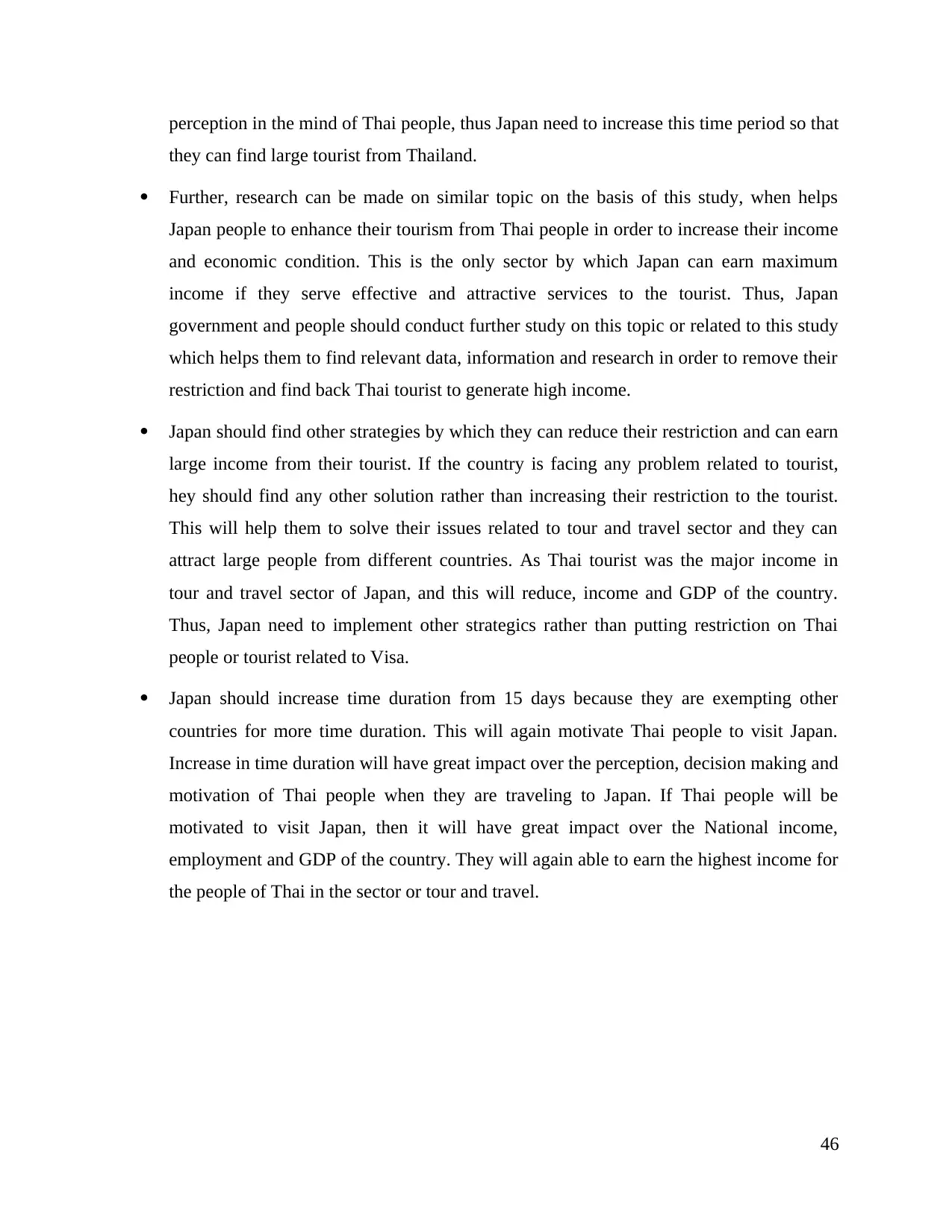
perception in the mind of Thai people, thus Japan need to increase this time period so that
they can find large tourist from Thailand.
Further, research can be made on similar topic on the basis of this study, when helps
Japan people to enhance their tourism from Thai people in order to increase their income
and economic condition. This is the only sector by which Japan can earn maximum
income if they serve effective and attractive services to the tourist. Thus, Japan
government and people should conduct further study on this topic or related to this study
which helps them to find relevant data, information and research in order to remove their
restriction and find back Thai tourist to generate high income.
Japan should find other strategies by which they can reduce their restriction and can earn
large income from their tourist. If the country is facing any problem related to tourist,
hey should find any other solution rather than increasing their restriction to the tourist.
This will help them to solve their issues related to tour and travel sector and they can
attract large people from different countries. As Thai tourist was the major income in
tour and travel sector of Japan, and this will reduce, income and GDP of the country.
Thus, Japan need to implement other strategics rather than putting restriction on Thai
people or tourist related to Visa.
Japan should increase time duration from 15 days because they are exempting other
countries for more time duration. This will again motivate Thai people to visit Japan.
Increase in time duration will have great impact over the perception, decision making and
motivation of Thai people when they are traveling to Japan. If Thai people will be
motivated to visit Japan, then it will have great impact over the National income,
employment and GDP of the country. They will again able to earn the highest income for
the people of Thai in the sector or tour and travel.
46
they can find large tourist from Thailand.
Further, research can be made on similar topic on the basis of this study, when helps
Japan people to enhance their tourism from Thai people in order to increase their income
and economic condition. This is the only sector by which Japan can earn maximum
income if they serve effective and attractive services to the tourist. Thus, Japan
government and people should conduct further study on this topic or related to this study
which helps them to find relevant data, information and research in order to remove their
restriction and find back Thai tourist to generate high income.
Japan should find other strategies by which they can reduce their restriction and can earn
large income from their tourist. If the country is facing any problem related to tourist,
hey should find any other solution rather than increasing their restriction to the tourist.
This will help them to solve their issues related to tour and travel sector and they can
attract large people from different countries. As Thai tourist was the major income in
tour and travel sector of Japan, and this will reduce, income and GDP of the country.
Thus, Japan need to implement other strategics rather than putting restriction on Thai
people or tourist related to Visa.
Japan should increase time duration from 15 days because they are exempting other
countries for more time duration. This will again motivate Thai people to visit Japan.
Increase in time duration will have great impact over the perception, decision making and
motivation of Thai people when they are traveling to Japan. If Thai people will be
motivated to visit Japan, then it will have great impact over the National income,
employment and GDP of the country. They will again able to earn the highest income for
the people of Thai in the sector or tour and travel.
46
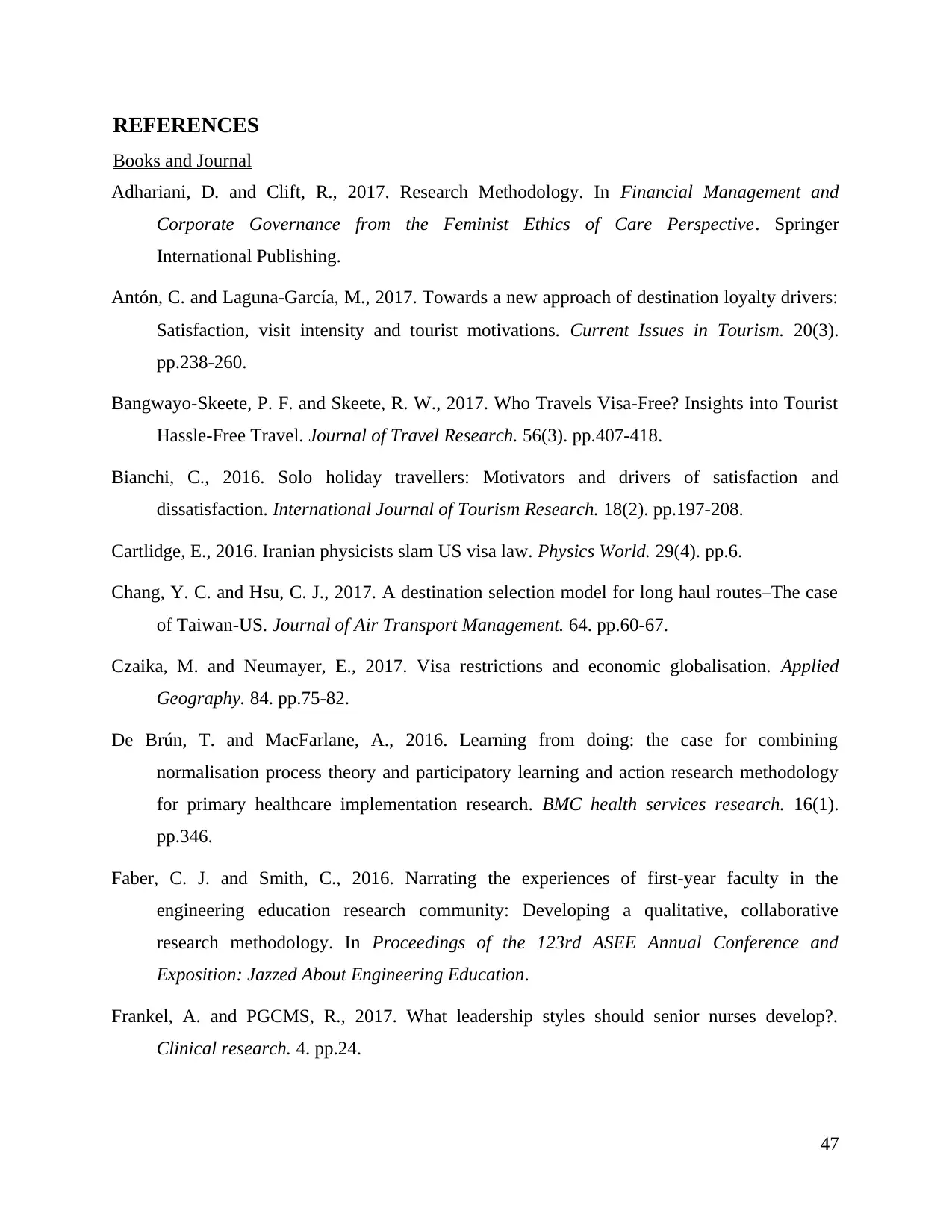
REFERENCES
Books and Journal
Adhariani, D. and Clift, R., 2017. Research Methodology. In Financial Management and
Corporate Governance from the Feminist Ethics of Care Perspective. Springer
International Publishing.
Antón, C. and Laguna-García, M., 2017. Towards a new approach of destination loyalty drivers:
Satisfaction, visit intensity and tourist motivations. Current Issues in Tourism. 20(3).
pp.238-260.
Bangwayo-Skeete, P. F. and Skeete, R. W., 2017. Who Travels Visa-Free? Insights into Tourist
Hassle-Free Travel. Journal of Travel Research. 56(3). pp.407-418.
Bianchi, C., 2016. Solo holiday travellers: Motivators and drivers of satisfaction and
dissatisfaction. International Journal of Tourism Research. 18(2). pp.197-208.
Cartlidge, E., 2016. Iranian physicists slam US visa law. Physics World. 29(4). pp.6.
Chang, Y. C. and Hsu, C. J., 2017. A destination selection model for long haul routes–The case
of Taiwan-US. Journal of Air Transport Management. 64. pp.60-67.
Czaika, M. and Neumayer, E., 2017. Visa restrictions and economic globalisation. Applied
Geography. 84. pp.75-82.
De Brún, T. and MacFarlane, A., 2016. Learning from doing: the case for combining
normalisation process theory and participatory learning and action research methodology
for primary healthcare implementation research. BMC health services research. 16(1).
pp.346.
Faber, C. J. and Smith, C., 2016. Narrating the experiences of first-year faculty in the
engineering education research community: Developing a qualitative, collaborative
research methodology. In Proceedings of the 123rd ASEE Annual Conference and
Exposition: Jazzed About Engineering Education.
Frankel, A. and PGCMS, R., 2017. What leadership styles should senior nurses develop?.
Clinical research. 4. pp.24.
47
Books and Journal
Adhariani, D. and Clift, R., 2017. Research Methodology. In Financial Management and
Corporate Governance from the Feminist Ethics of Care Perspective. Springer
International Publishing.
Antón, C. and Laguna-García, M., 2017. Towards a new approach of destination loyalty drivers:
Satisfaction, visit intensity and tourist motivations. Current Issues in Tourism. 20(3).
pp.238-260.
Bangwayo-Skeete, P. F. and Skeete, R. W., 2017. Who Travels Visa-Free? Insights into Tourist
Hassle-Free Travel. Journal of Travel Research. 56(3). pp.407-418.
Bianchi, C., 2016. Solo holiday travellers: Motivators and drivers of satisfaction and
dissatisfaction. International Journal of Tourism Research. 18(2). pp.197-208.
Cartlidge, E., 2016. Iranian physicists slam US visa law. Physics World. 29(4). pp.6.
Chang, Y. C. and Hsu, C. J., 2017. A destination selection model for long haul routes–The case
of Taiwan-US. Journal of Air Transport Management. 64. pp.60-67.
Czaika, M. and Neumayer, E., 2017. Visa restrictions and economic globalisation. Applied
Geography. 84. pp.75-82.
De Brún, T. and MacFarlane, A., 2016. Learning from doing: the case for combining
normalisation process theory and participatory learning and action research methodology
for primary healthcare implementation research. BMC health services research. 16(1).
pp.346.
Faber, C. J. and Smith, C., 2016. Narrating the experiences of first-year faculty in the
engineering education research community: Developing a qualitative, collaborative
research methodology. In Proceedings of the 123rd ASEE Annual Conference and
Exposition: Jazzed About Engineering Education.
Frankel, A. and PGCMS, R., 2017. What leadership styles should senior nurses develop?.
Clinical research. 4. pp.24.
47
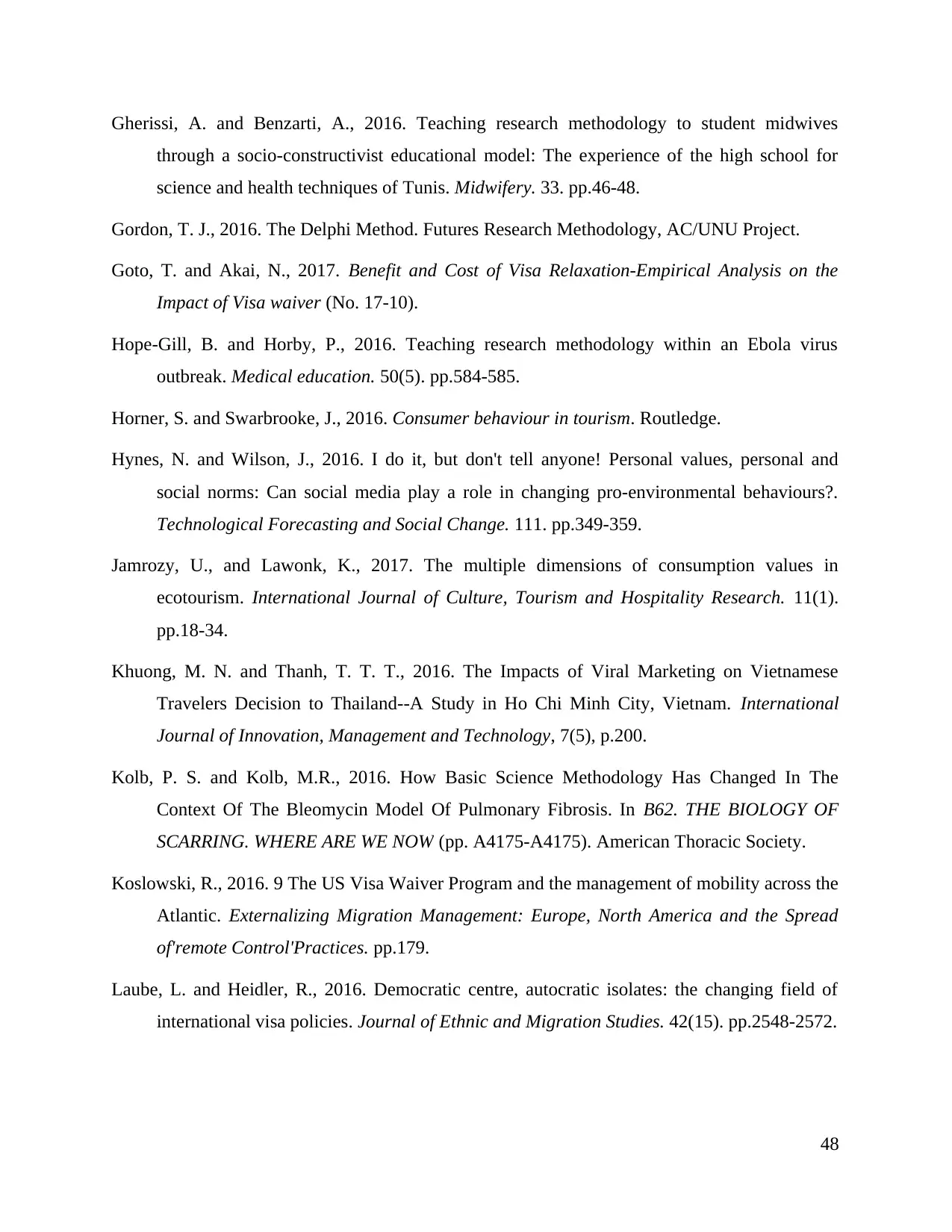
Gherissi, A. and Benzarti, A., 2016. Teaching research methodology to student midwives
through a socio-constructivist educational model: The experience of the high school for
science and health techniques of Tunis. Midwifery. 33. pp.46-48.
Gordon, T. J., 2016. The Delphi Method. Futures Research Methodology, AC/UNU Project.
Goto, T. and Akai, N., 2017. Benefit and Cost of Visa Relaxation-Empirical Analysis on the
Impact of Visa waiver (No. 17-10).
Hope‐Gill, B. and Horby, P., 2016. Teaching research methodology within an Ebola virus
outbreak. Medical education. 50(5). pp.584-585.
Horner, S. and Swarbrooke, J., 2016. Consumer behaviour in tourism. Routledge.
Hynes, N. and Wilson, J., 2016. I do it, but don't tell anyone! Personal values, personal and
social norms: Can social media play a role in changing pro-environmental behaviours?.
Technological Forecasting and Social Change. 111. pp.349-359.
Jamrozy, U., and Lawonk, K., 2017. The multiple dimensions of consumption values in
ecotourism. International Journal of Culture, Tourism and Hospitality Research. 11(1).
pp.18-34.
Khuong, M. N. and Thanh, T. T. T., 2016. The Impacts of Viral Marketing on Vietnamese
Travelers Decision to Thailand--A Study in Ho Chi Minh City, Vietnam. International
Journal of Innovation, Management and Technology, 7(5), p.200.
Kolb, P. S. and Kolb, M.R., 2016. How Basic Science Methodology Has Changed In The
Context Of The Bleomycin Model Of Pulmonary Fibrosis. In B62. THE BIOLOGY OF
SCARRING. WHERE ARE WE NOW (pp. A4175-A4175). American Thoracic Society.
Koslowski, R., 2016. 9 The US Visa Waiver Program and the management of mobility across the
Atlantic. Externalizing Migration Management: Europe, North America and the Spread
of'remote Control'Practices. pp.179.
Laube, L. and Heidler, R., 2016. Democratic centre, autocratic isolates: the changing field of
international visa policies. Journal of Ethnic and Migration Studies. 42(15). pp.2548-2572.
48
through a socio-constructivist educational model: The experience of the high school for
science and health techniques of Tunis. Midwifery. 33. pp.46-48.
Gordon, T. J., 2016. The Delphi Method. Futures Research Methodology, AC/UNU Project.
Goto, T. and Akai, N., 2017. Benefit and Cost of Visa Relaxation-Empirical Analysis on the
Impact of Visa waiver (No. 17-10).
Hope‐Gill, B. and Horby, P., 2016. Teaching research methodology within an Ebola virus
outbreak. Medical education. 50(5). pp.584-585.
Horner, S. and Swarbrooke, J., 2016. Consumer behaviour in tourism. Routledge.
Hynes, N. and Wilson, J., 2016. I do it, but don't tell anyone! Personal values, personal and
social norms: Can social media play a role in changing pro-environmental behaviours?.
Technological Forecasting and Social Change. 111. pp.349-359.
Jamrozy, U., and Lawonk, K., 2017. The multiple dimensions of consumption values in
ecotourism. International Journal of Culture, Tourism and Hospitality Research. 11(1).
pp.18-34.
Khuong, M. N. and Thanh, T. T. T., 2016. The Impacts of Viral Marketing on Vietnamese
Travelers Decision to Thailand--A Study in Ho Chi Minh City, Vietnam. International
Journal of Innovation, Management and Technology, 7(5), p.200.
Kolb, P. S. and Kolb, M.R., 2016. How Basic Science Methodology Has Changed In The
Context Of The Bleomycin Model Of Pulmonary Fibrosis. In B62. THE BIOLOGY OF
SCARRING. WHERE ARE WE NOW (pp. A4175-A4175). American Thoracic Society.
Koslowski, R., 2016. 9 The US Visa Waiver Program and the management of mobility across the
Atlantic. Externalizing Migration Management: Europe, North America and the Spread
of'remote Control'Practices. pp.179.
Laube, L. and Heidler, R., 2016. Democratic centre, autocratic isolates: the changing field of
international visa policies. Journal of Ethnic and Migration Studies. 42(15). pp.2548-2572.
48
Secure Best Marks with AI Grader
Need help grading? Try our AI Grader for instant feedback on your assignments.
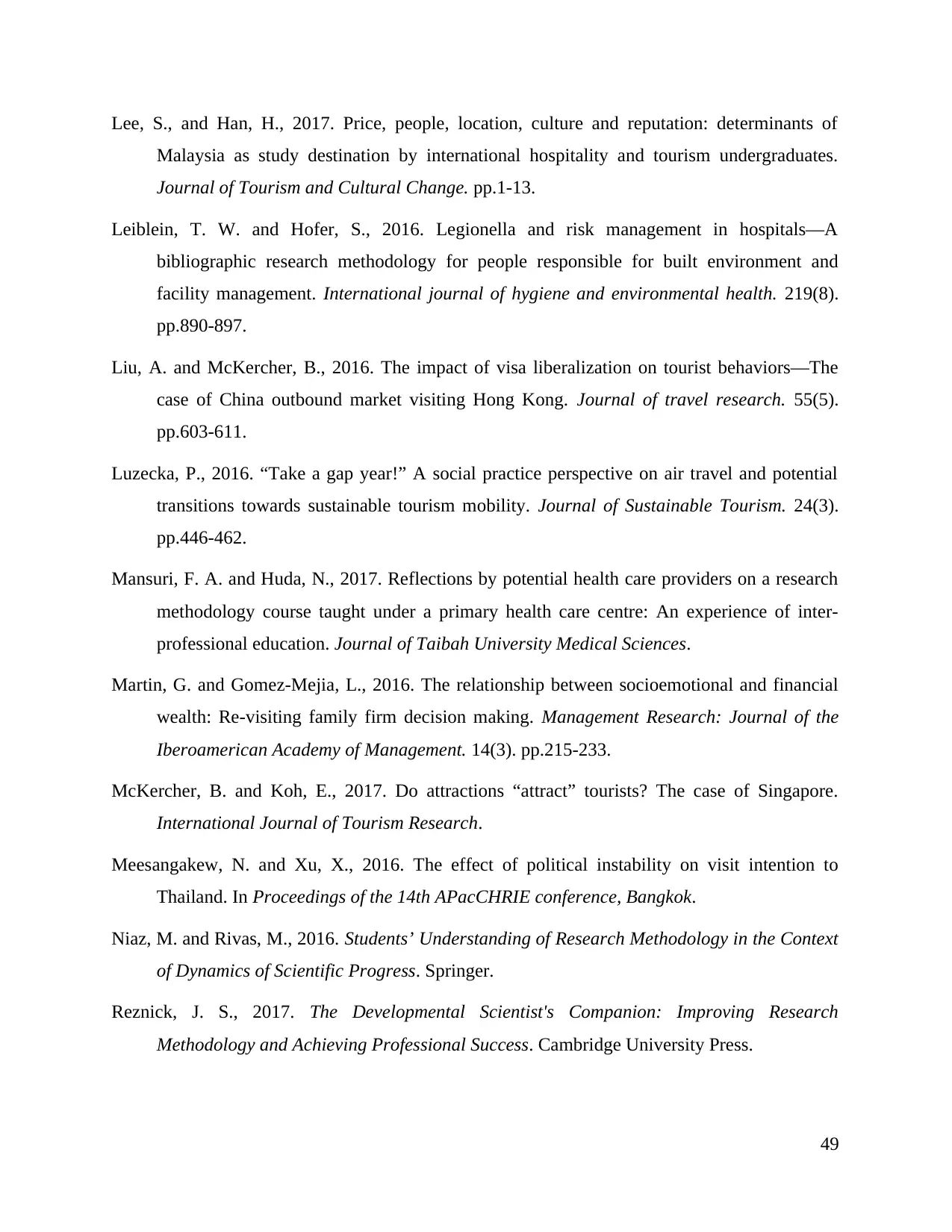
Lee, S., and Han, H., 2017. Price, people, location, culture and reputation: determinants of
Malaysia as study destination by international hospitality and tourism undergraduates.
Journal of Tourism and Cultural Change. pp.1-13.
Leiblein, T. W. and Hofer, S., 2016. Legionella and risk management in hospitals—A
bibliographic research methodology for people responsible for built environment and
facility management. International journal of hygiene and environmental health. 219(8).
pp.890-897.
Liu, A. and McKercher, B., 2016. The impact of visa liberalization on tourist behaviors—The
case of China outbound market visiting Hong Kong. Journal of travel research. 55(5).
pp.603-611.
Luzecka, P., 2016. “Take a gap year!” A social practice perspective on air travel and potential
transitions towards sustainable tourism mobility. Journal of Sustainable Tourism. 24(3).
pp.446-462.
Mansuri, F. A. and Huda, N., 2017. Reflections by potential health care providers on a research
methodology course taught under a primary health care centre: An experience of inter-
professional education. Journal of Taibah University Medical Sciences.
Martin, G. and Gomez-Mejia, L., 2016. The relationship between socioemotional and financial
wealth: Re-visiting family firm decision making. Management Research: Journal of the
Iberoamerican Academy of Management. 14(3). pp.215-233.
McKercher, B. and Koh, E., 2017. Do attractions “attract” tourists? The case of Singapore.
International Journal of Tourism Research.
Meesangakew, N. and Xu, X., 2016. The effect of political instability on visit intention to
Thailand. In Proceedings of the 14th APacCHRIE conference, Bangkok.
Niaz, M. and Rivas, M., 2016. Students’ Understanding of Research Methodology in the Context
of Dynamics of Scientific Progress. Springer.
Reznick, J. S., 2017. The Developmental Scientist's Companion: Improving Research
Methodology and Achieving Professional Success. Cambridge University Press.
49
Malaysia as study destination by international hospitality and tourism undergraduates.
Journal of Tourism and Cultural Change. pp.1-13.
Leiblein, T. W. and Hofer, S., 2016. Legionella and risk management in hospitals—A
bibliographic research methodology for people responsible for built environment and
facility management. International journal of hygiene and environmental health. 219(8).
pp.890-897.
Liu, A. and McKercher, B., 2016. The impact of visa liberalization on tourist behaviors—The
case of China outbound market visiting Hong Kong. Journal of travel research. 55(5).
pp.603-611.
Luzecka, P., 2016. “Take a gap year!” A social practice perspective on air travel and potential
transitions towards sustainable tourism mobility. Journal of Sustainable Tourism. 24(3).
pp.446-462.
Mansuri, F. A. and Huda, N., 2017. Reflections by potential health care providers on a research
methodology course taught under a primary health care centre: An experience of inter-
professional education. Journal of Taibah University Medical Sciences.
Martin, G. and Gomez-Mejia, L., 2016. The relationship between socioemotional and financial
wealth: Re-visiting family firm decision making. Management Research: Journal of the
Iberoamerican Academy of Management. 14(3). pp.215-233.
McKercher, B. and Koh, E., 2017. Do attractions “attract” tourists? The case of Singapore.
International Journal of Tourism Research.
Meesangakew, N. and Xu, X., 2016. The effect of political instability on visit intention to
Thailand. In Proceedings of the 14th APacCHRIE conference, Bangkok.
Niaz, M. and Rivas, M., 2016. Students’ Understanding of Research Methodology in the Context
of Dynamics of Scientific Progress. Springer.
Reznick, J. S., 2017. The Developmental Scientist's Companion: Improving Research
Methodology and Achieving Professional Success. Cambridge University Press.
49
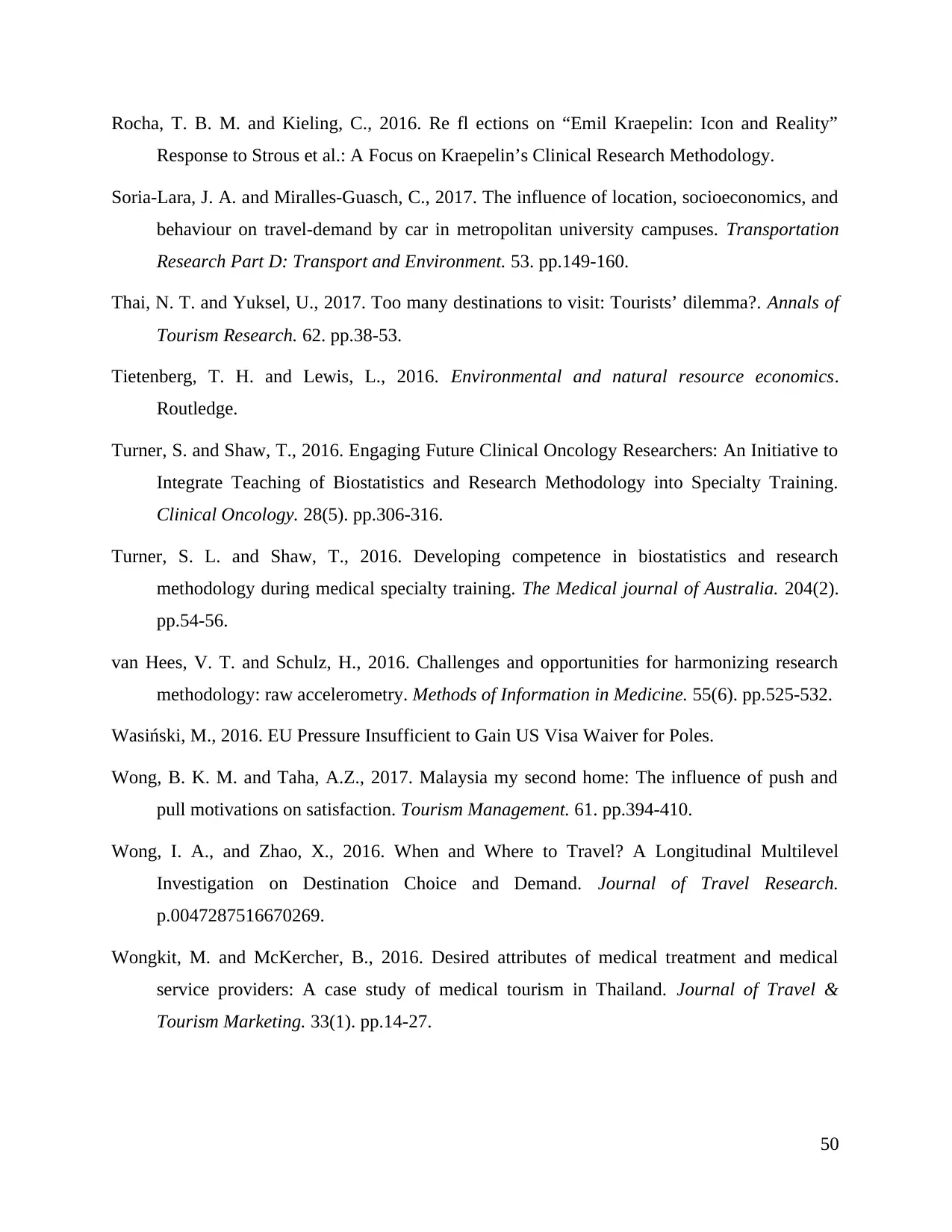
Rocha, T. B. M. and Kieling, C., 2016. Re fl ections on “Emil Kraepelin: Icon and Reality”
Response to Strous et al.: A Focus on Kraepelin’s Clinical Research Methodology.
Soria-Lara, J. A. and Miralles-Guasch, C., 2017. The influence of location, socioeconomics, and
behaviour on travel-demand by car in metropolitan university campuses. Transportation
Research Part D: Transport and Environment. 53. pp.149-160.
Thai, N. T. and Yuksel, U., 2017. Too many destinations to visit: Tourists’ dilemma?. Annals of
Tourism Research. 62. pp.38-53.
Tietenberg, T. H. and Lewis, L., 2016. Environmental and natural resource economics.
Routledge.
Turner, S. and Shaw, T., 2016. Engaging Future Clinical Oncology Researchers: An Initiative to
Integrate Teaching of Biostatistics and Research Methodology into Specialty Training.
Clinical Oncology. 28(5). pp.306-316.
Turner, S. L. and Shaw, T., 2016. Developing competence in biostatistics and research
methodology during medical specialty training. The Medical journal of Australia. 204(2).
pp.54-56.
van Hees, V. T. and Schulz, H., 2016. Challenges and opportunities for harmonizing research
methodology: raw accelerometry. Methods of Information in Medicine. 55(6). pp.525-532.
Wasiński, M., 2016. EU Pressure Insufficient to Gain US Visa Waiver for Poles.
Wong, B. K. M. and Taha, A.Z., 2017. Malaysia my second home: The influence of push and
pull motivations on satisfaction. Tourism Management. 61. pp.394-410.
Wong, I. A., and Zhao, X., 2016. When and Where to Travel? A Longitudinal Multilevel
Investigation on Destination Choice and Demand. Journal of Travel Research.
p.0047287516670269.
Wongkit, M. and McKercher, B., 2016. Desired attributes of medical treatment and medical
service providers: A case study of medical tourism in Thailand. Journal of Travel &
Tourism Marketing. 33(1). pp.14-27.
50
Response to Strous et al.: A Focus on Kraepelin’s Clinical Research Methodology.
Soria-Lara, J. A. and Miralles-Guasch, C., 2017. The influence of location, socioeconomics, and
behaviour on travel-demand by car in metropolitan university campuses. Transportation
Research Part D: Transport and Environment. 53. pp.149-160.
Thai, N. T. and Yuksel, U., 2017. Too many destinations to visit: Tourists’ dilemma?. Annals of
Tourism Research. 62. pp.38-53.
Tietenberg, T. H. and Lewis, L., 2016. Environmental and natural resource economics.
Routledge.
Turner, S. and Shaw, T., 2016. Engaging Future Clinical Oncology Researchers: An Initiative to
Integrate Teaching of Biostatistics and Research Methodology into Specialty Training.
Clinical Oncology. 28(5). pp.306-316.
Turner, S. L. and Shaw, T., 2016. Developing competence in biostatistics and research
methodology during medical specialty training. The Medical journal of Australia. 204(2).
pp.54-56.
van Hees, V. T. and Schulz, H., 2016. Challenges and opportunities for harmonizing research
methodology: raw accelerometry. Methods of Information in Medicine. 55(6). pp.525-532.
Wasiński, M., 2016. EU Pressure Insufficient to Gain US Visa Waiver for Poles.
Wong, B. K. M. and Taha, A.Z., 2017. Malaysia my second home: The influence of push and
pull motivations on satisfaction. Tourism Management. 61. pp.394-410.
Wong, I. A., and Zhao, X., 2016. When and Where to Travel? A Longitudinal Multilevel
Investigation on Destination Choice and Demand. Journal of Travel Research.
p.0047287516670269.
Wongkit, M. and McKercher, B., 2016. Desired attributes of medical treatment and medical
service providers: A case study of medical tourism in Thailand. Journal of Travel &
Tourism Marketing. 33(1). pp.14-27.
50
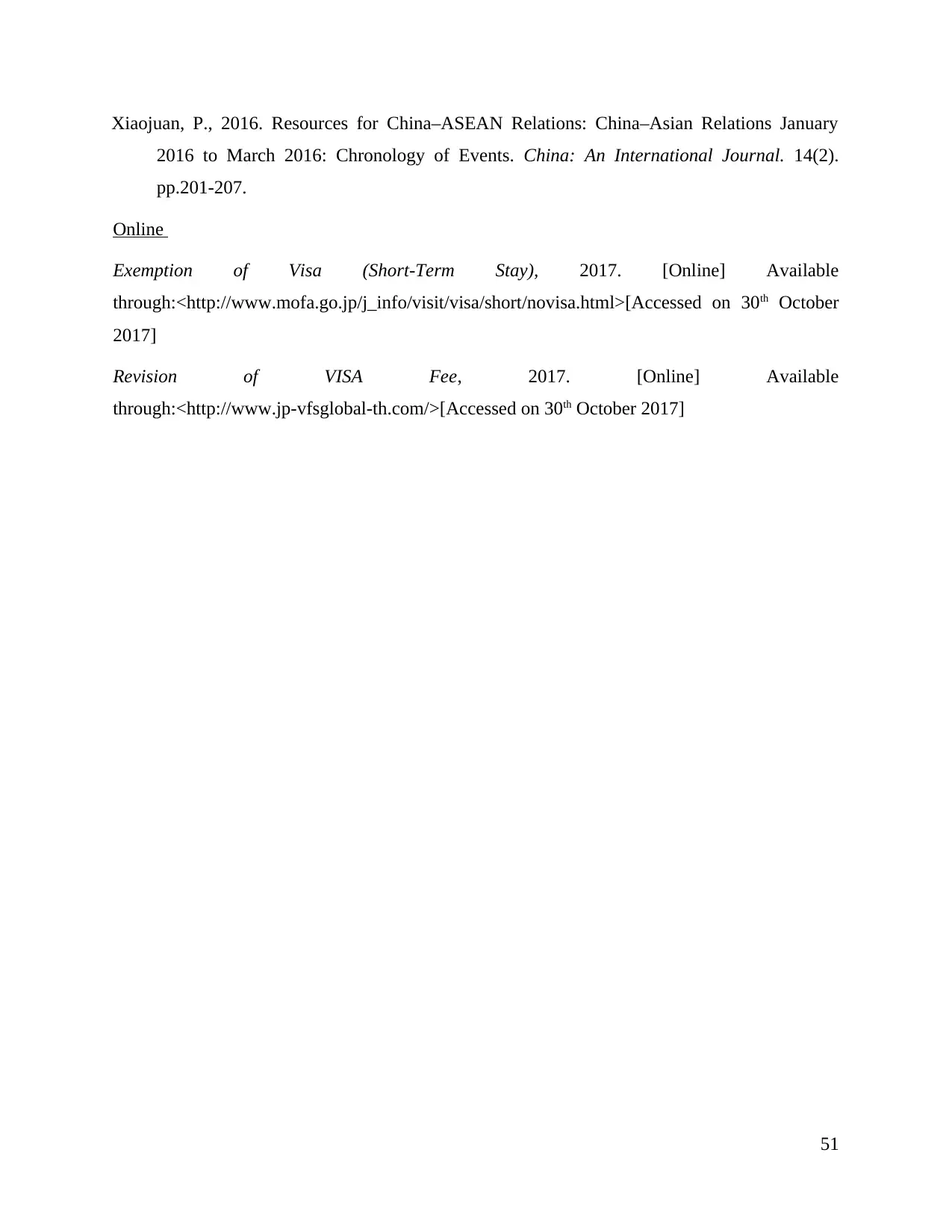
Xiaojuan, P., 2016. Resources for China–ASEAN Relations: China–Asian Relations January
2016 to March 2016: Chronology of Events. China: An International Journal. 14(2).
pp.201-207.
Online
Exemption of Visa (Short-Term Stay), 2017. [Online] Available
through:<http://www.mofa.go.jp/j_info/visit/visa/short/novisa.html>[Accessed on 30th October
2017]
Revision of VISA Fee, 2017. [Online] Available
through:<http://www.jp-vfsglobal-th.com/>[Accessed on 30th October 2017]
51
2016 to March 2016: Chronology of Events. China: An International Journal. 14(2).
pp.201-207.
Online
Exemption of Visa (Short-Term Stay), 2017. [Online] Available
through:<http://www.mofa.go.jp/j_info/visit/visa/short/novisa.html>[Accessed on 30th October
2017]
Revision of VISA Fee, 2017. [Online] Available
through:<http://www.jp-vfsglobal-th.com/>[Accessed on 30th October 2017]
51
Paraphrase This Document
Need a fresh take? Get an instant paraphrase of this document with our AI Paraphraser
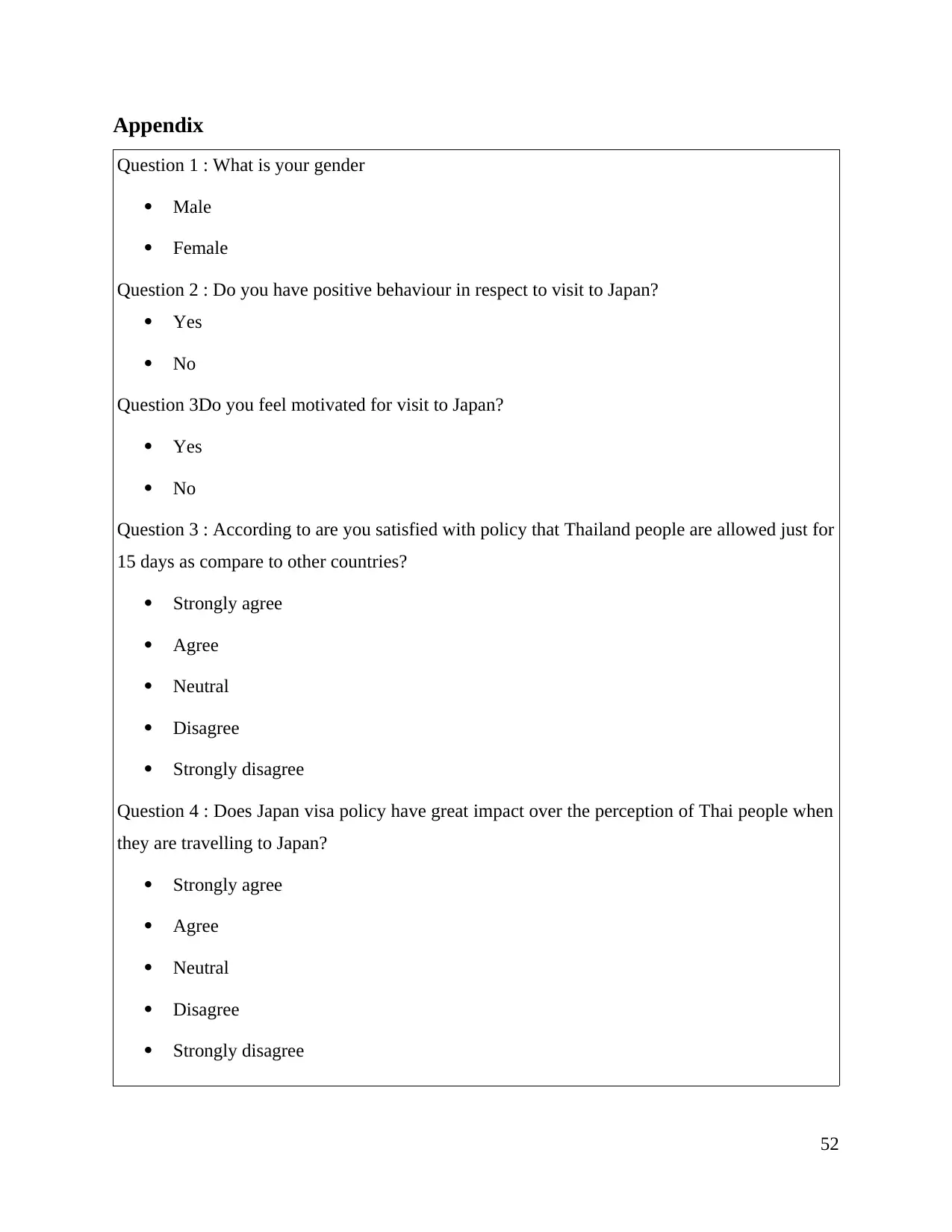
Appendix
Question 1 : What is your gender
Male
Female
Question 2 : Do you have positive behaviour in respect to visit to Japan?
Yes
No
Question 3Do you feel motivated for visit to Japan?
Yes
No
Question 3 : According to are you satisfied with policy that Thailand people are allowed just for
15 days as compare to other countries?
Strongly agree
Agree
Neutral
Disagree
Strongly disagree
Question 4 : Does Japan visa policy have great impact over the perception of Thai people when
they are travelling to Japan?
Strongly agree
Agree
Neutral
Disagree
Strongly disagree
52
Question 1 : What is your gender
Male
Female
Question 2 : Do you have positive behaviour in respect to visit to Japan?
Yes
No
Question 3Do you feel motivated for visit to Japan?
Yes
No
Question 3 : According to are you satisfied with policy that Thailand people are allowed just for
15 days as compare to other countries?
Strongly agree
Agree
Neutral
Disagree
Strongly disagree
Question 4 : Does Japan visa policy have great impact over the perception of Thai people when
they are travelling to Japan?
Strongly agree
Agree
Neutral
Disagree
Strongly disagree
52
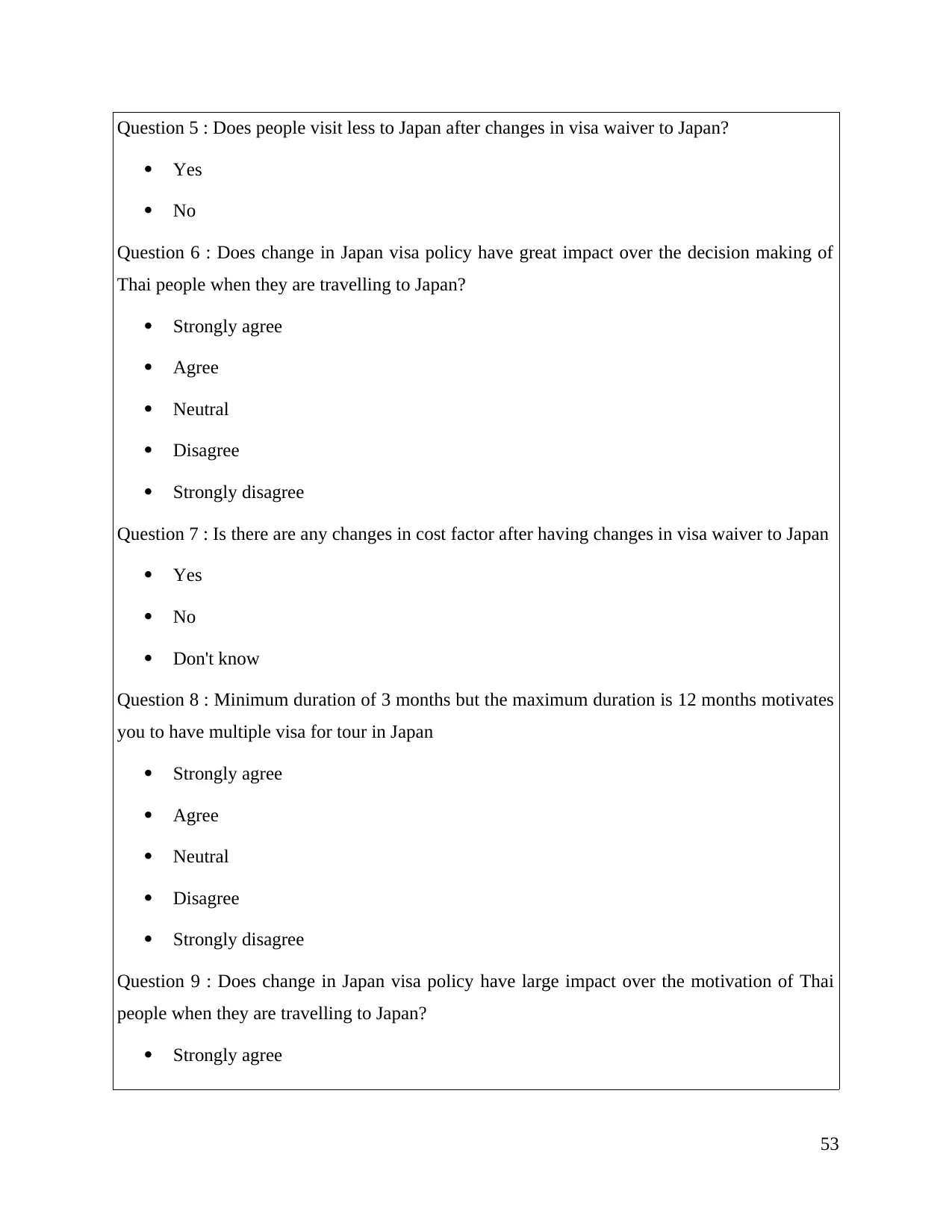
Question 5 : Does people visit less to Japan after changes in visa waiver to Japan?
Yes
No
Question 6 : Does change in Japan visa policy have great impact over the decision making of
Thai people when they are travelling to Japan?
Strongly agree
Agree
Neutral
Disagree
Strongly disagree
Question 7 : Is there are any changes in cost factor after having changes in visa waiver to Japan
Yes
No
Don't know
Question 8 : Minimum duration of 3 months but the maximum duration is 12 months motivates
you to have multiple visa for tour in Japan
Strongly agree
Agree
Neutral
Disagree
Strongly disagree
Question 9 : Does change in Japan visa policy have large impact over the motivation of Thai
people when they are travelling to Japan?
Strongly agree
53
Yes
No
Question 6 : Does change in Japan visa policy have great impact over the decision making of
Thai people when they are travelling to Japan?
Strongly agree
Agree
Neutral
Disagree
Strongly disagree
Question 7 : Is there are any changes in cost factor after having changes in visa waiver to Japan
Yes
No
Don't know
Question 8 : Minimum duration of 3 months but the maximum duration is 12 months motivates
you to have multiple visa for tour in Japan
Strongly agree
Agree
Neutral
Disagree
Strongly disagree
Question 9 : Does change in Japan visa policy have large impact over the motivation of Thai
people when they are travelling to Japan?
Strongly agree
53
1 out of 57
Related Documents
Your All-in-One AI-Powered Toolkit for Academic Success.
+13062052269
info@desklib.com
Available 24*7 on WhatsApp / Email
![[object Object]](/_next/static/media/star-bottom.7253800d.svg)
Unlock your academic potential
© 2024 | Zucol Services PVT LTD | All rights reserved.





![[SOLVED] Exploring UAE Citizens' Satisfaction with Government Services Abroad](/_next/image/?url=https%3A%2F%2Fdesklib.com%2Fmedia%2Fimages%2Fyn%2F227f04b132fe45a4bb40c2ec42e01b27.jpg&w=256&q=75)